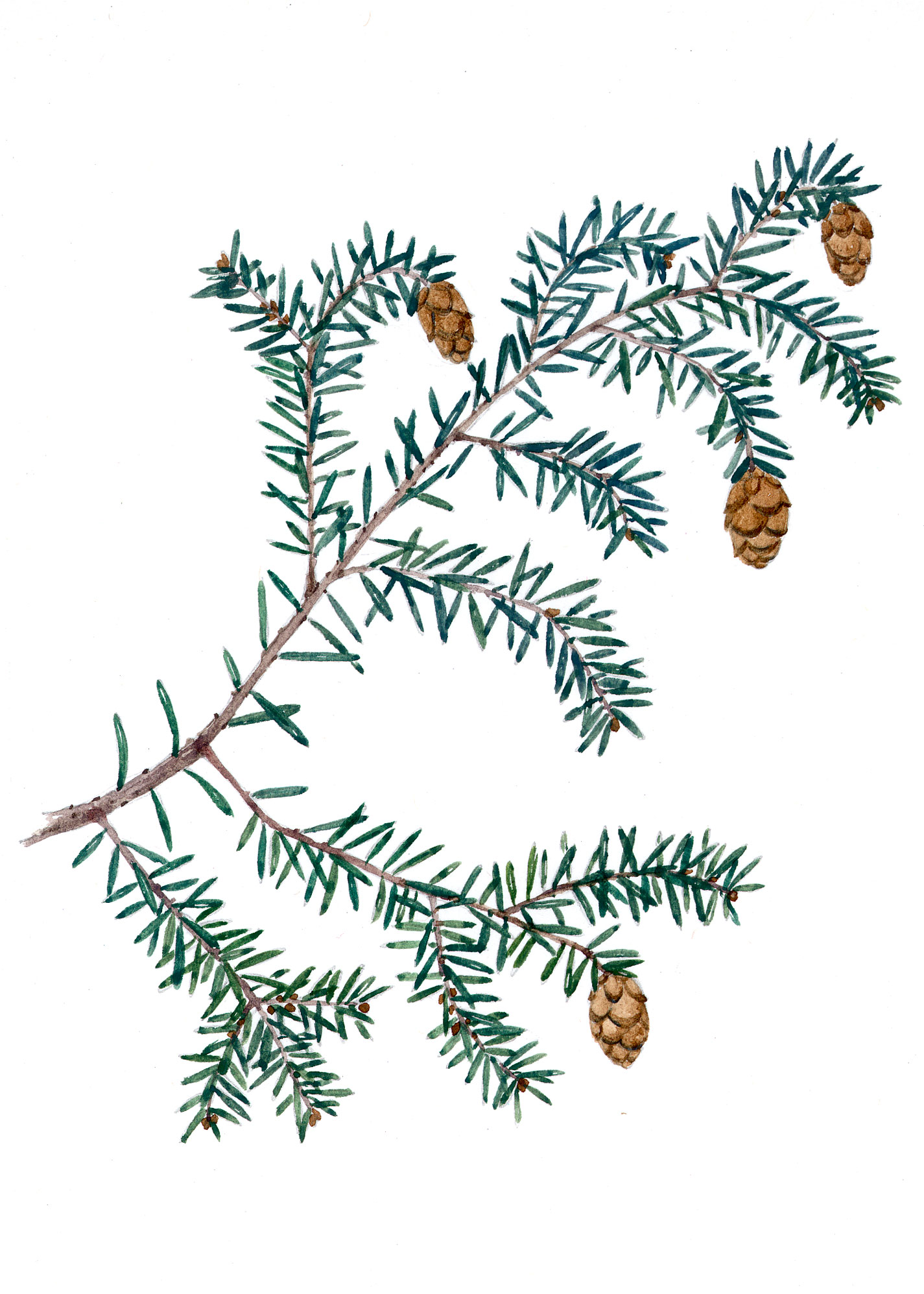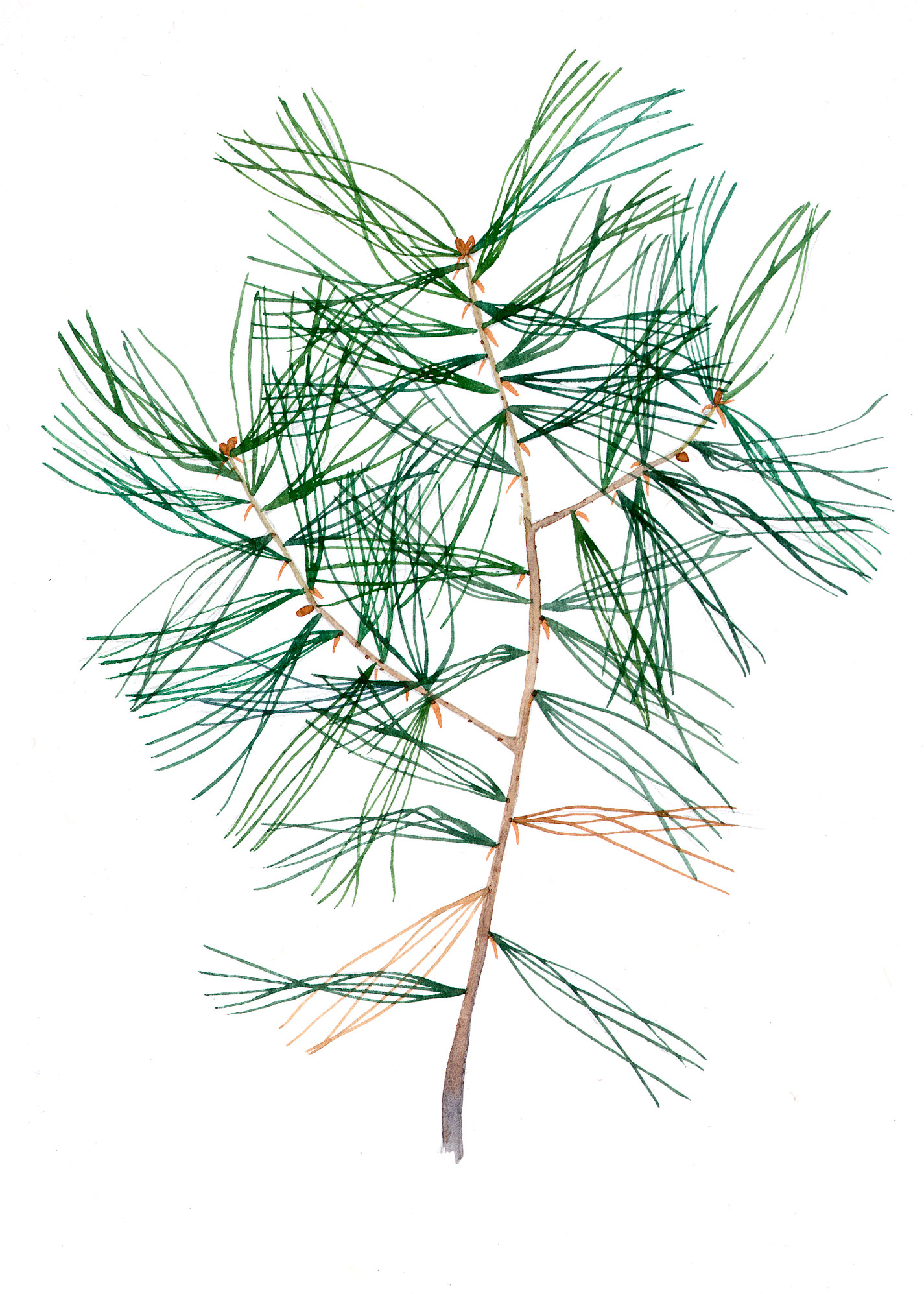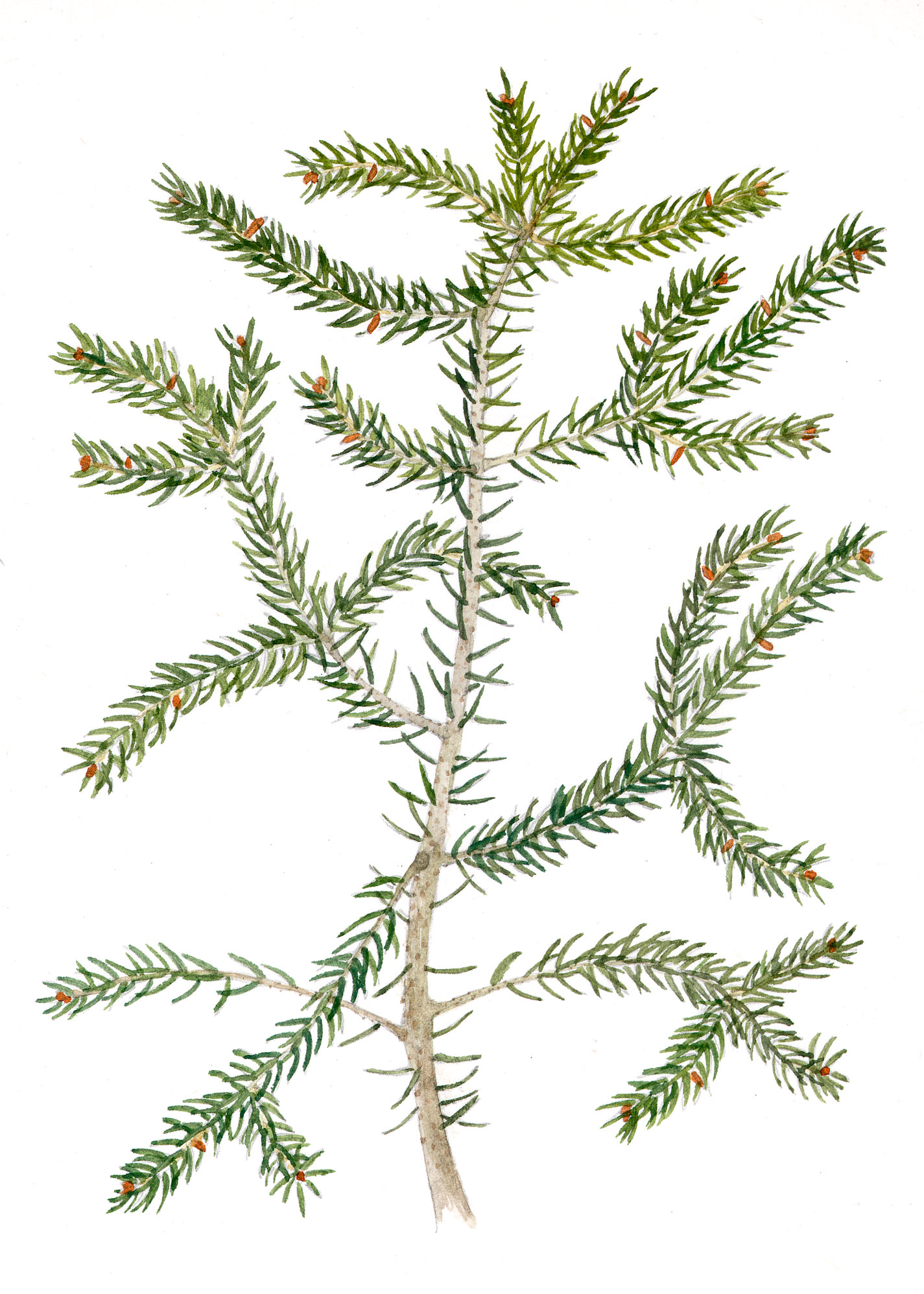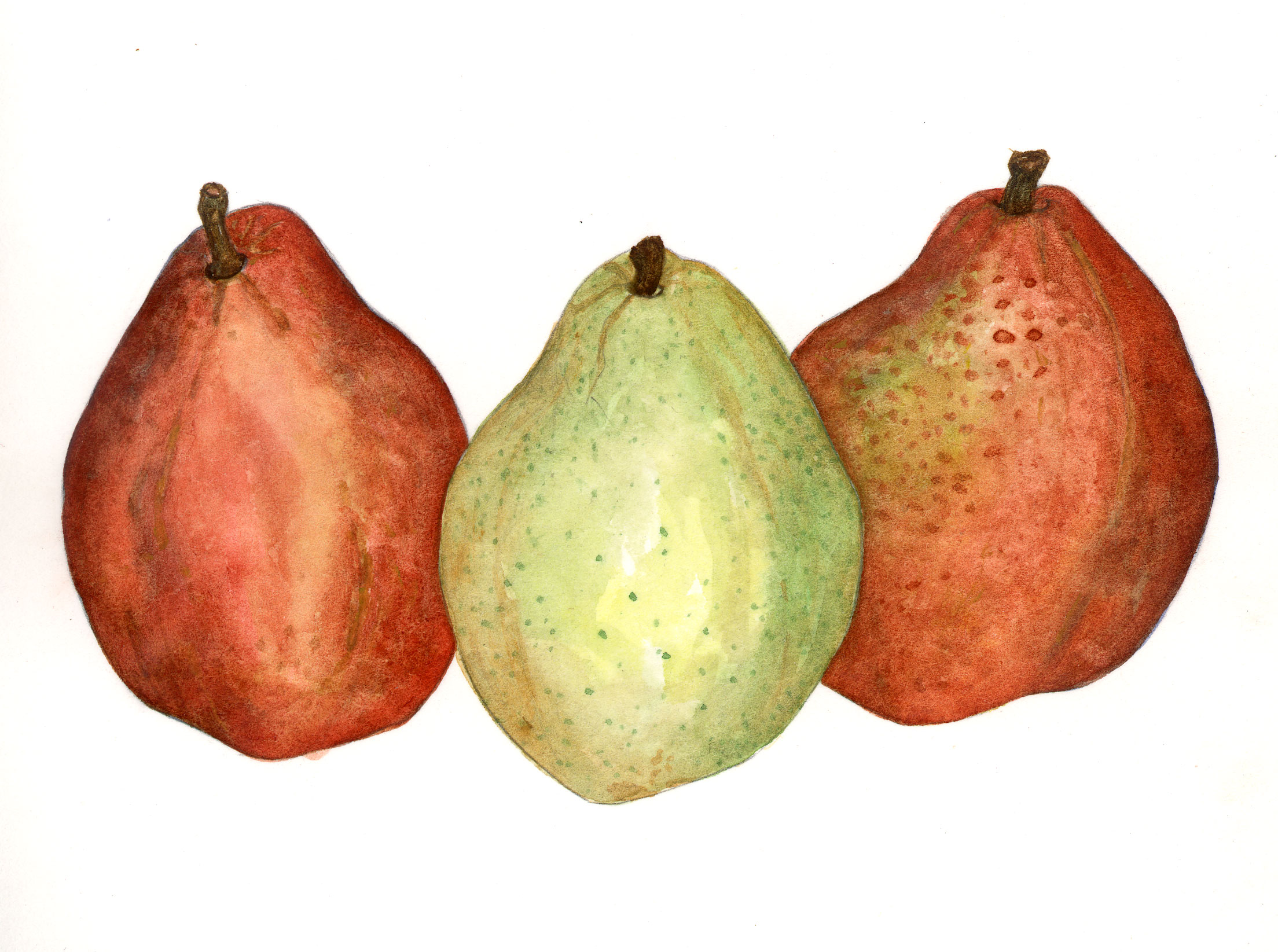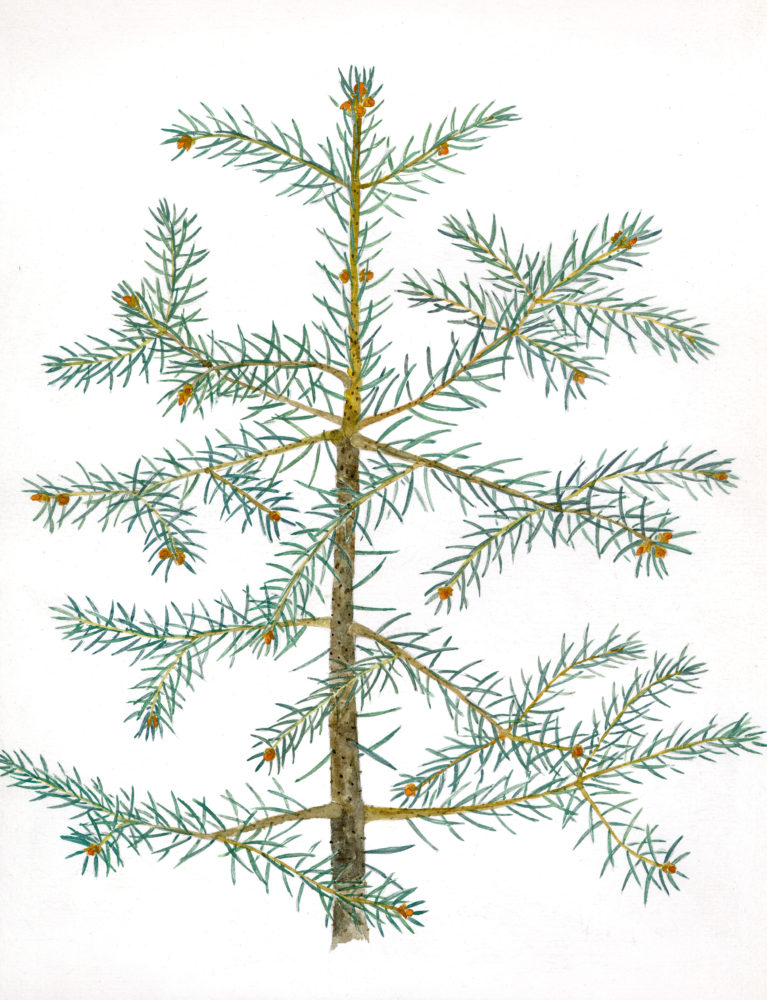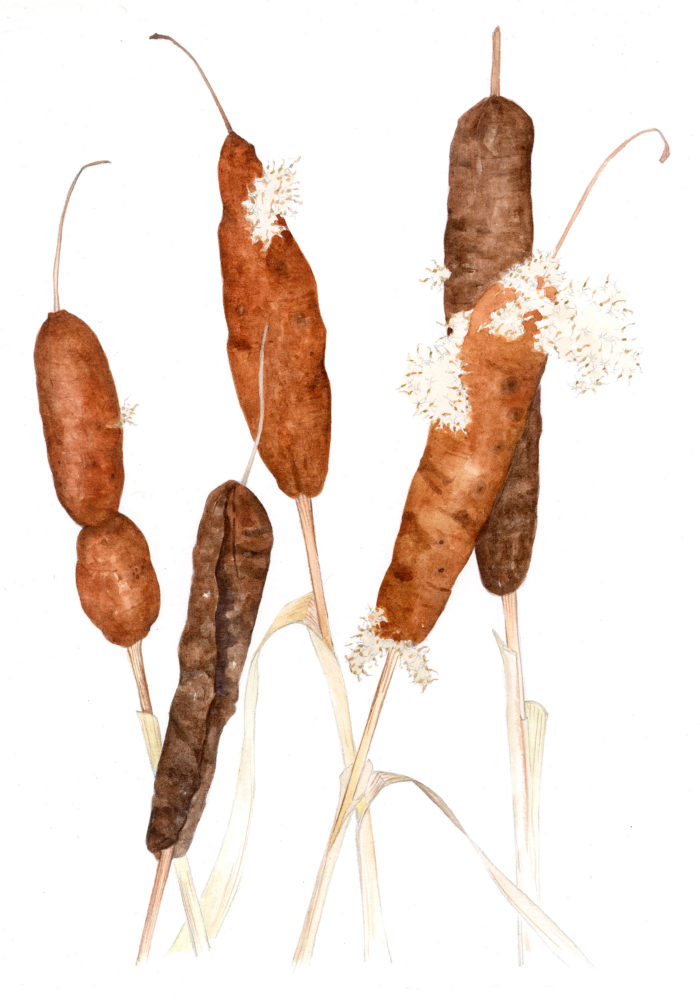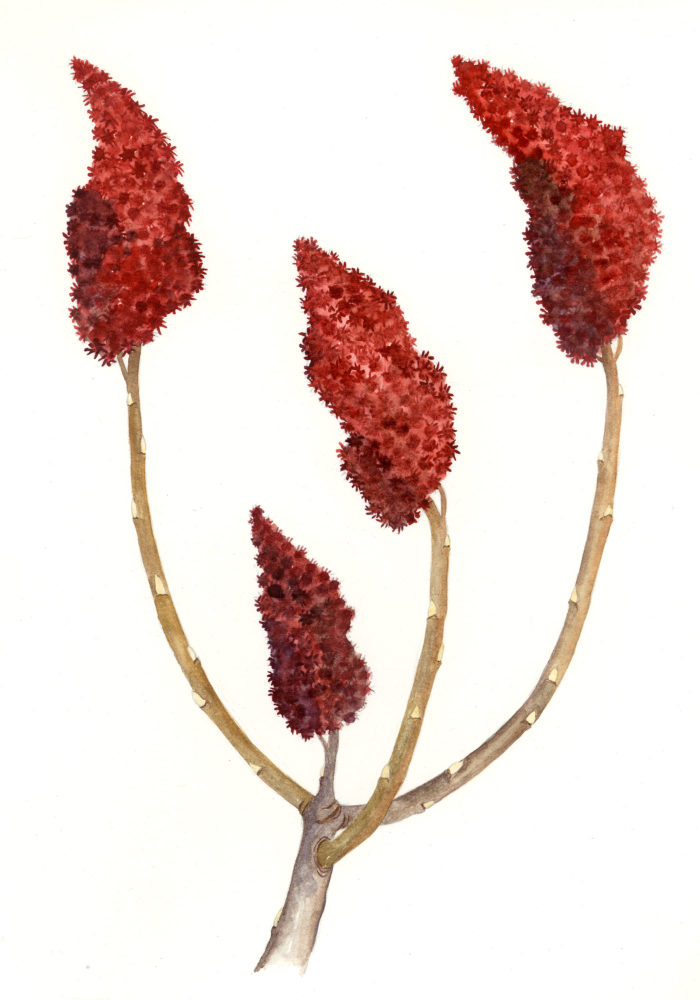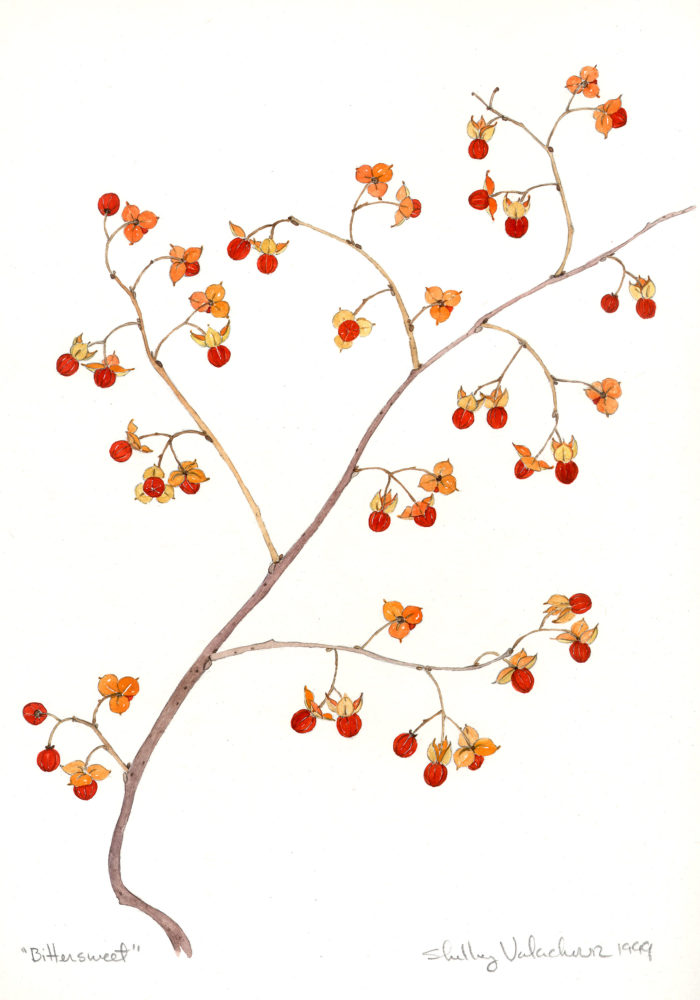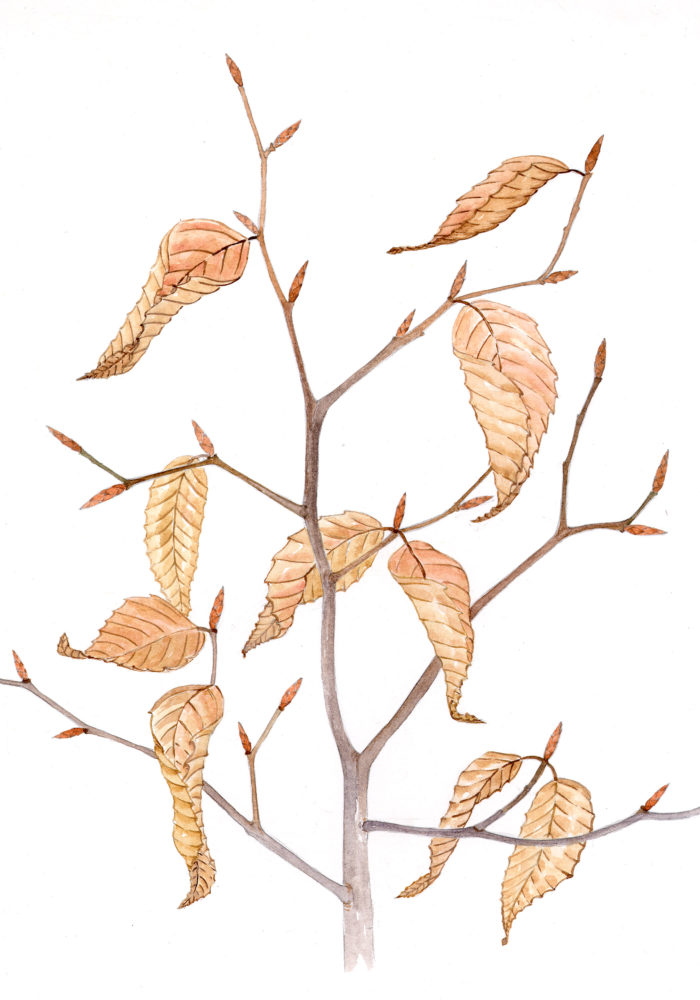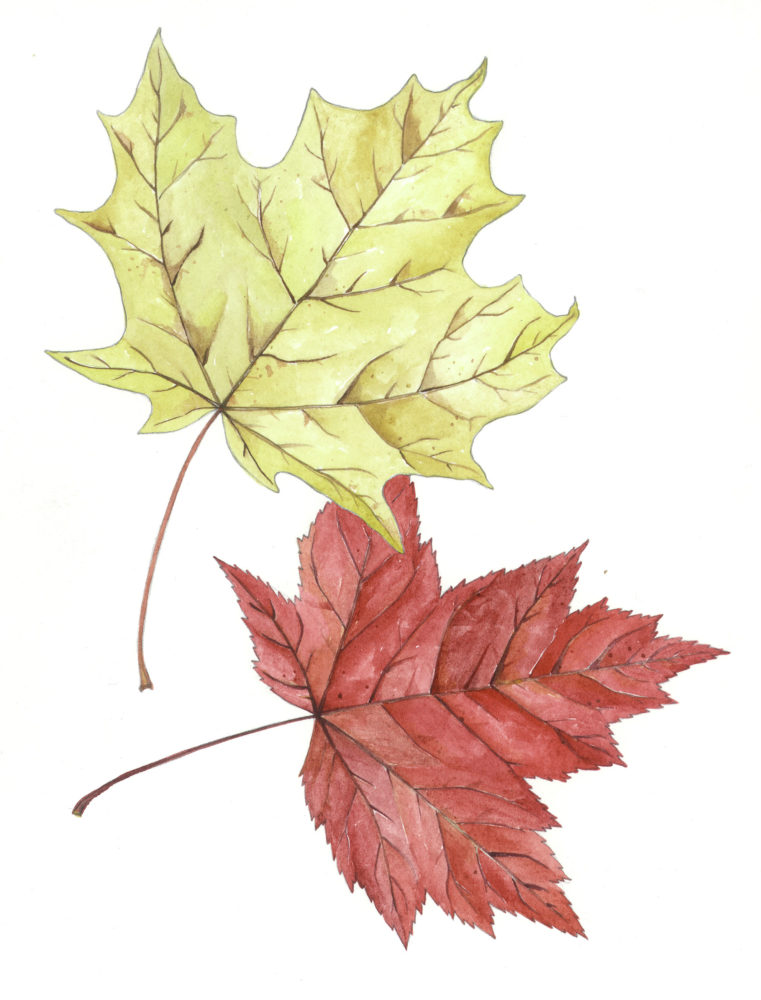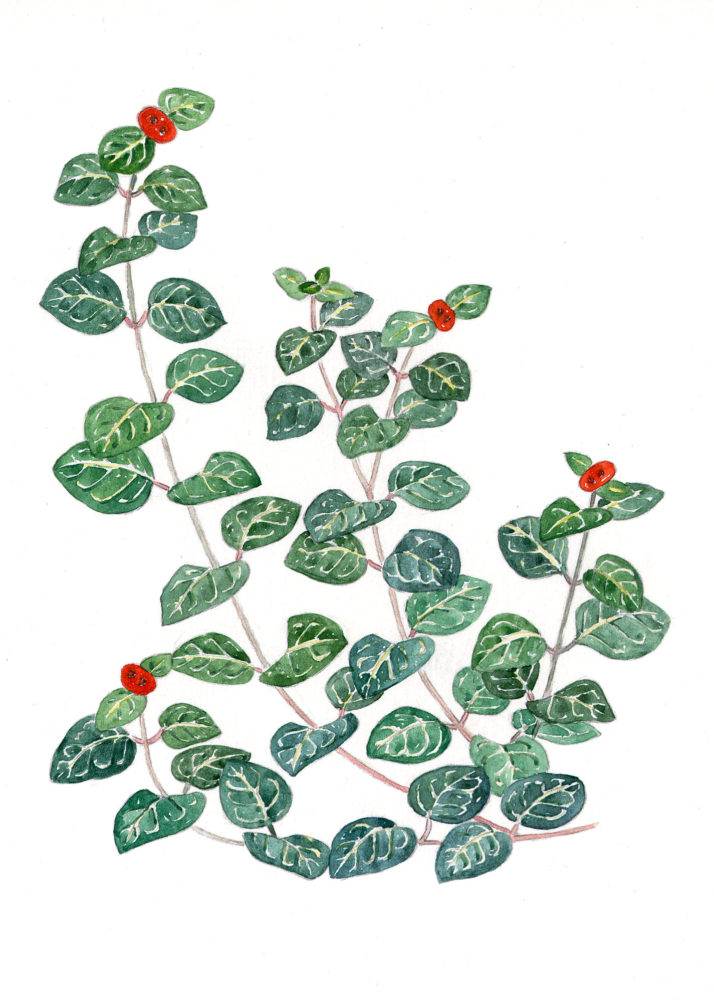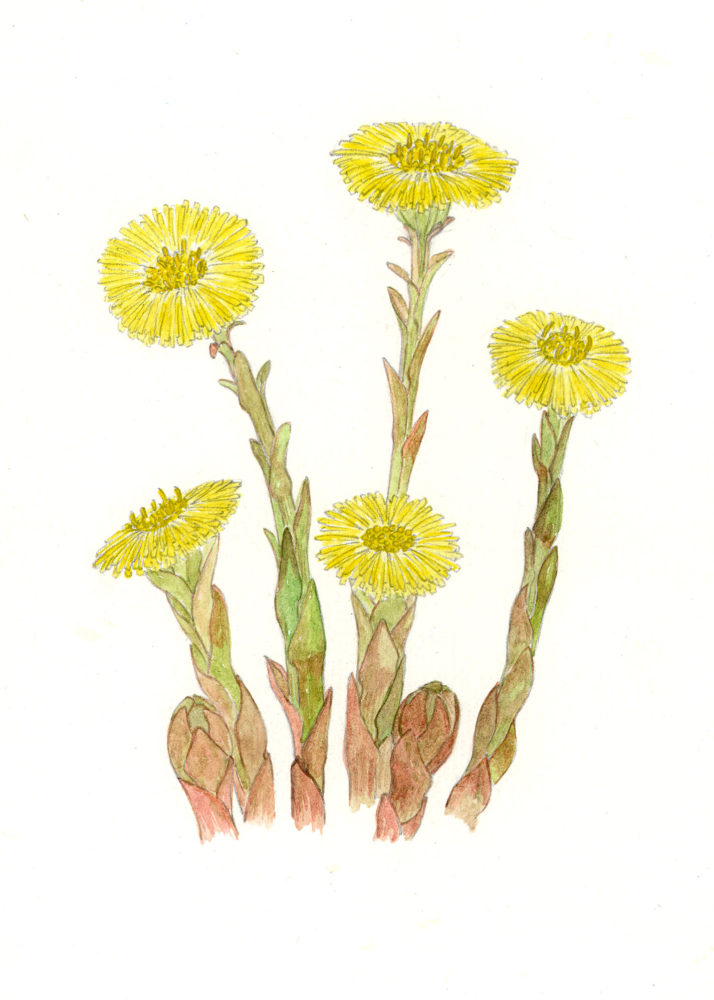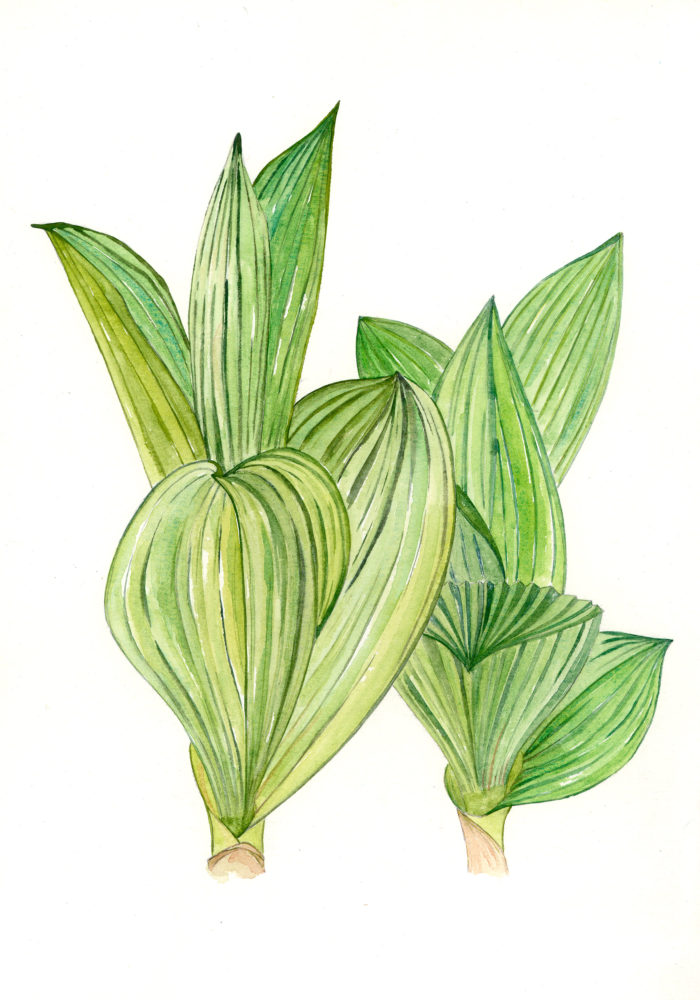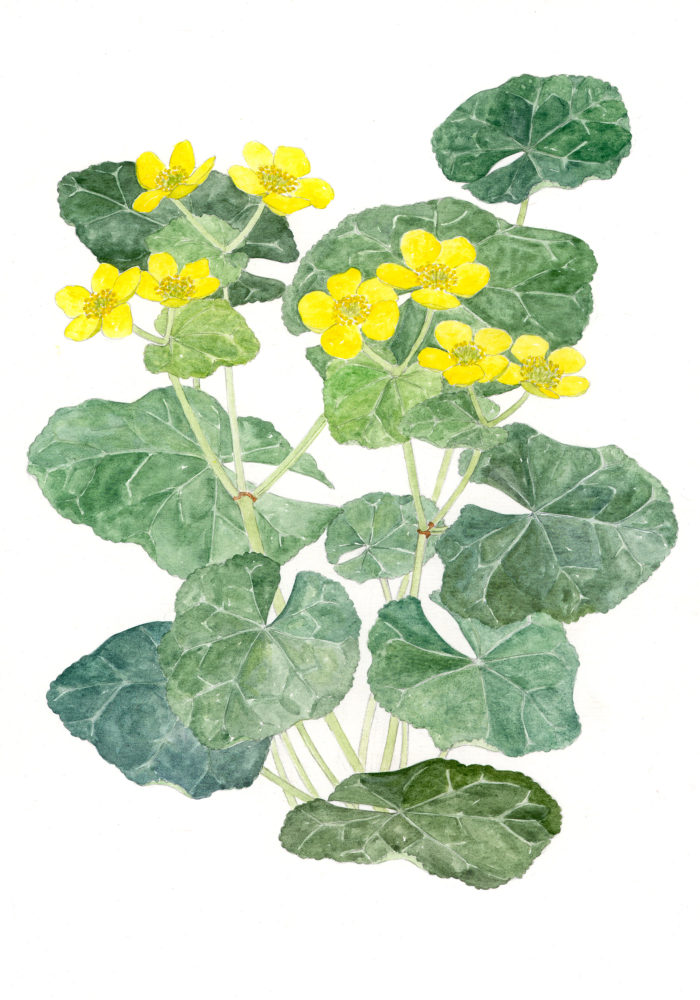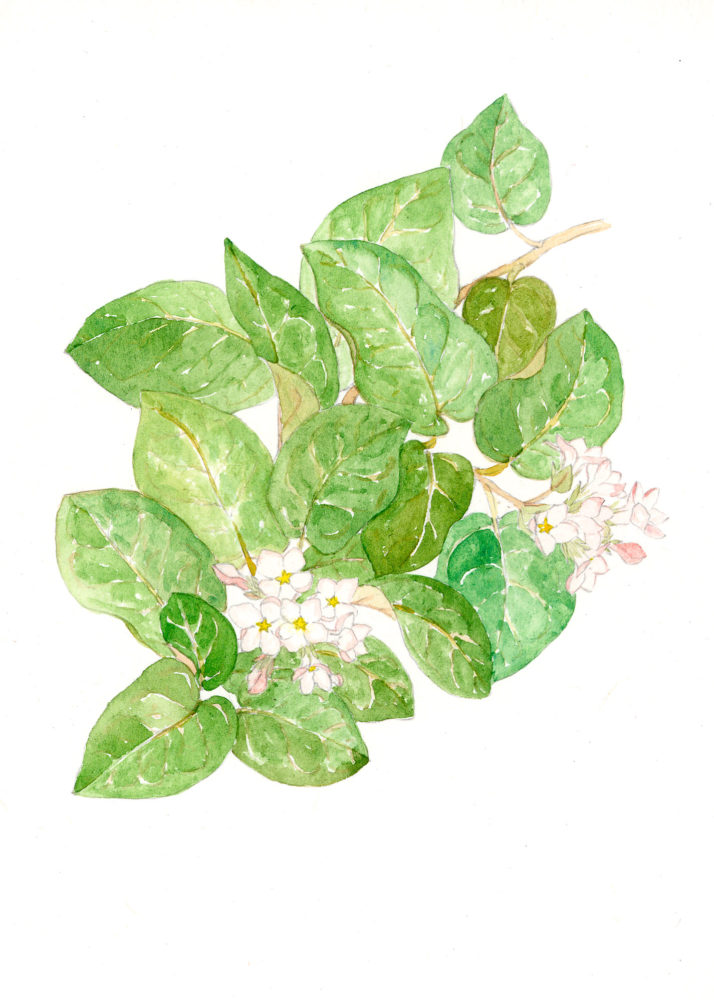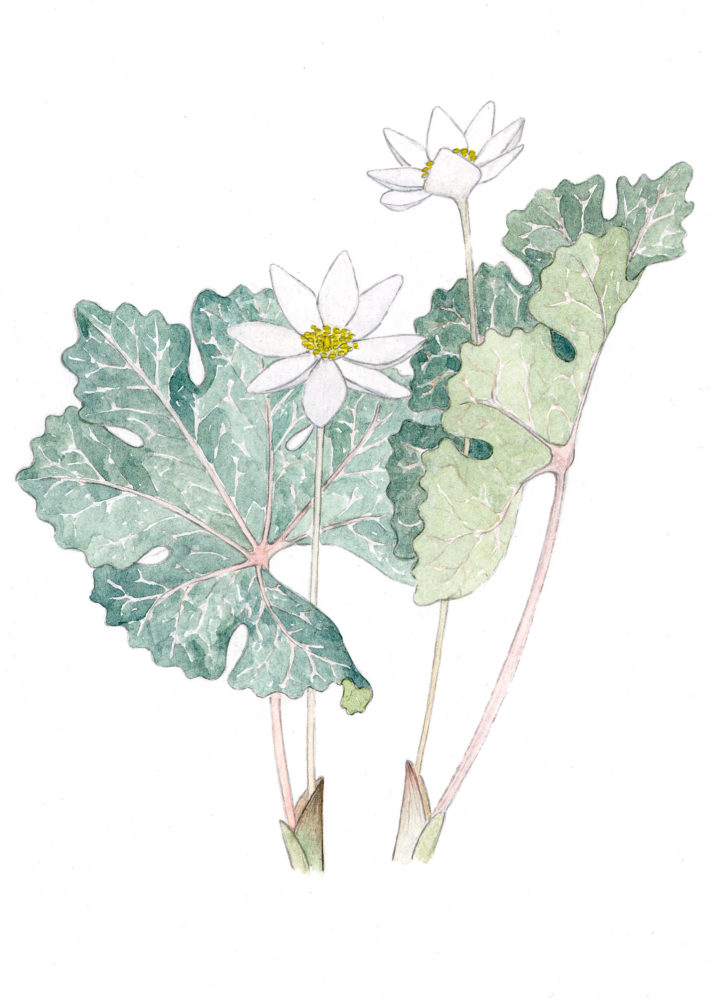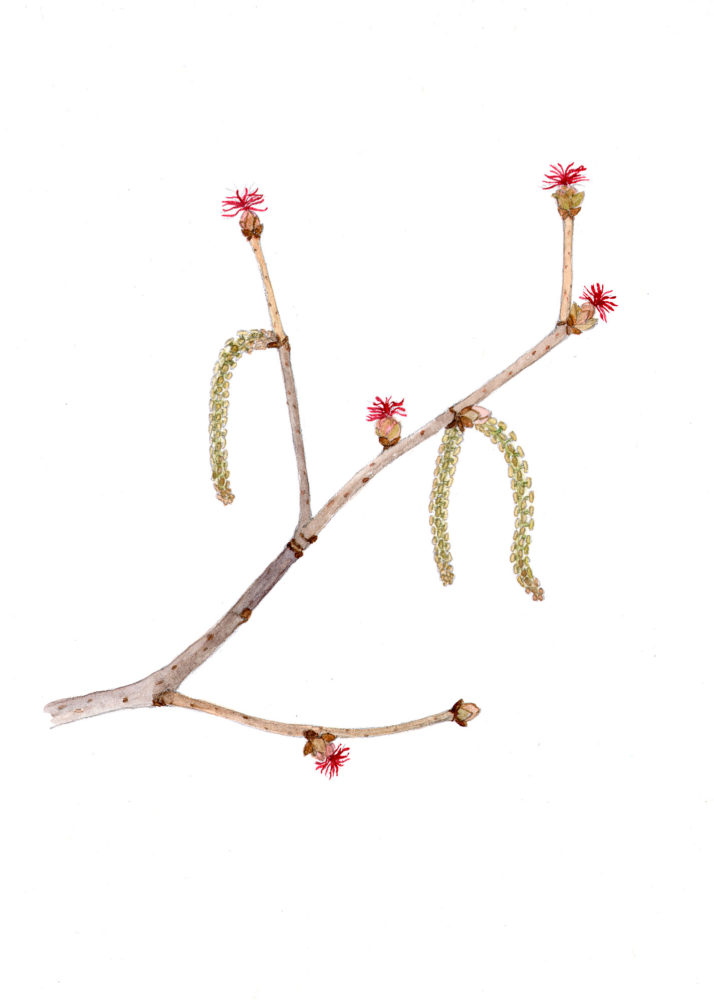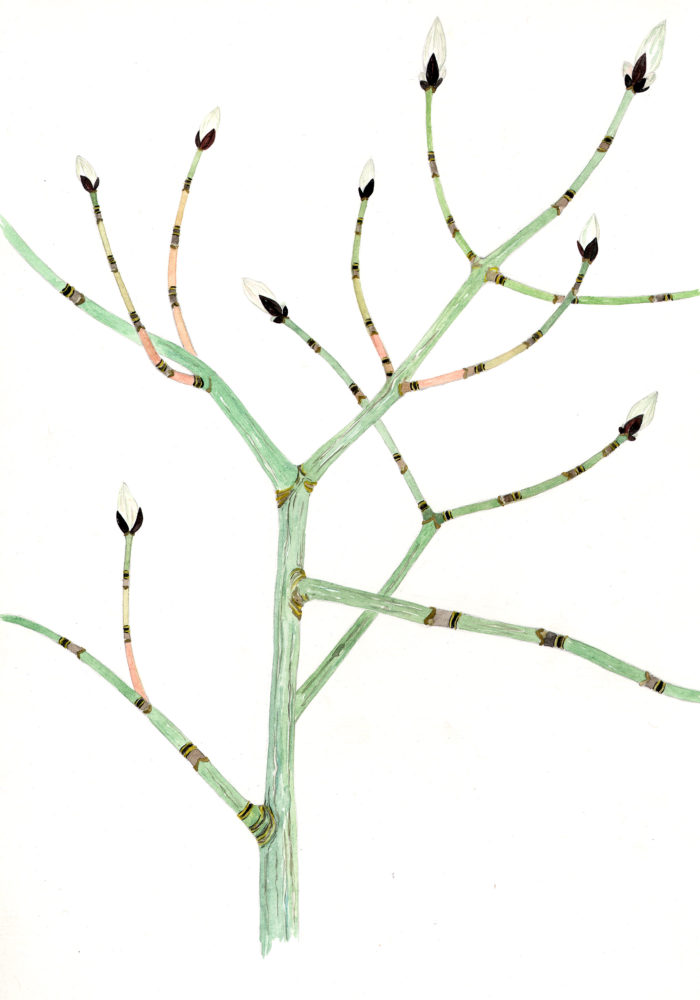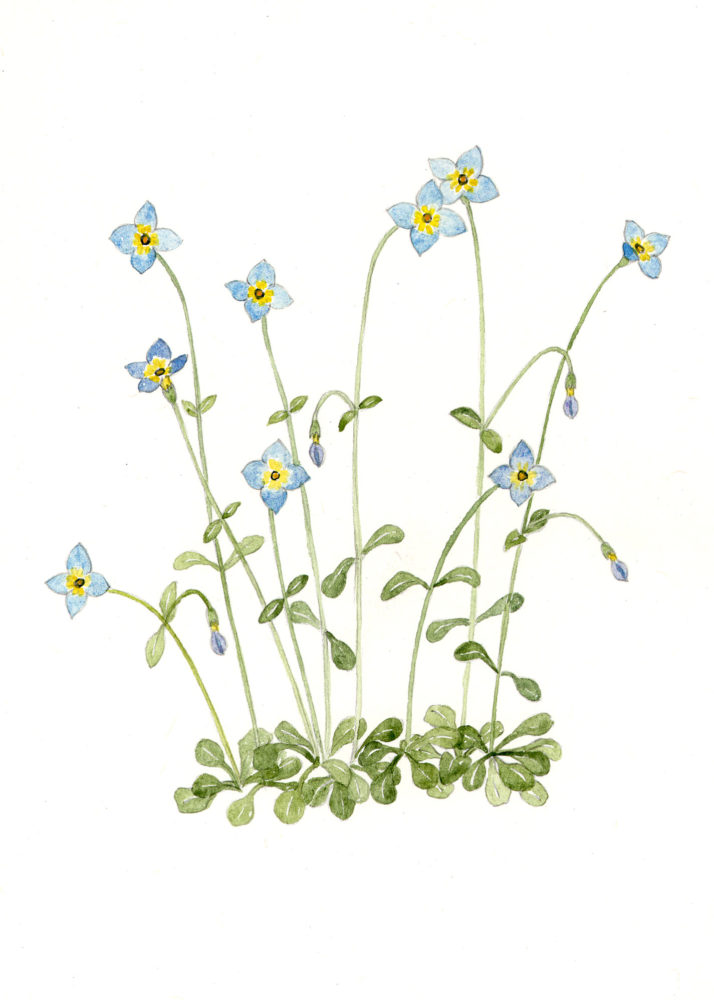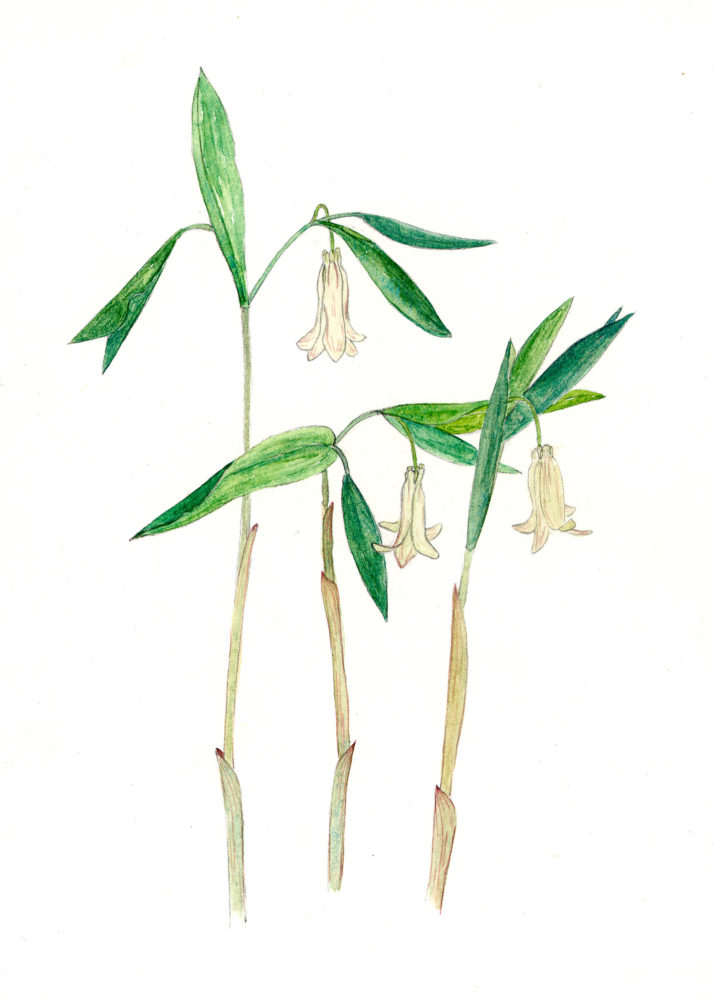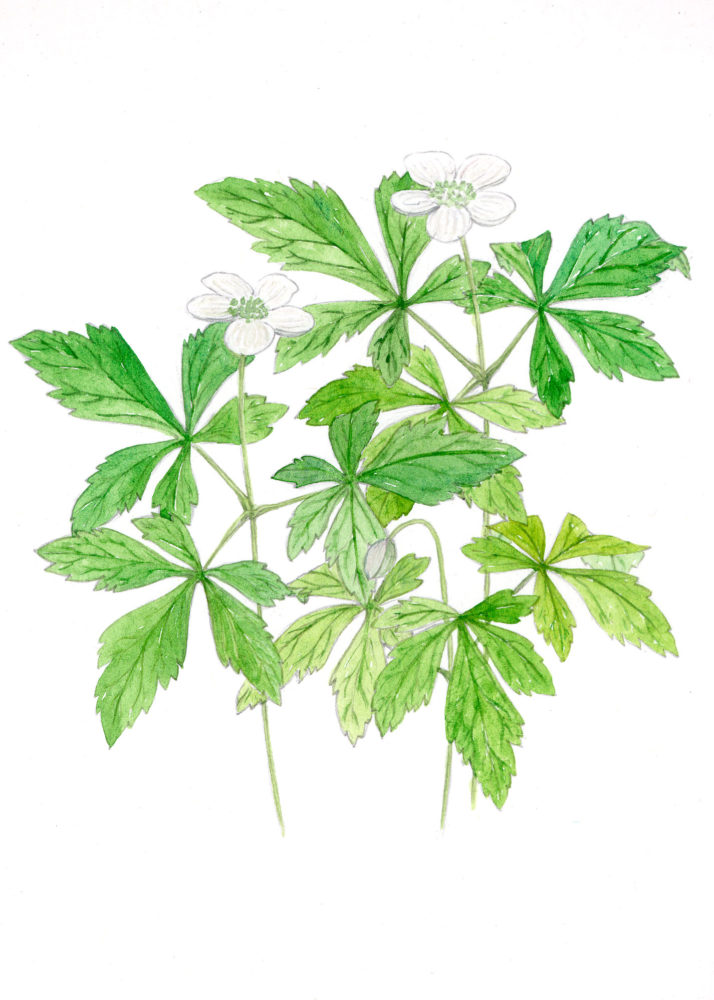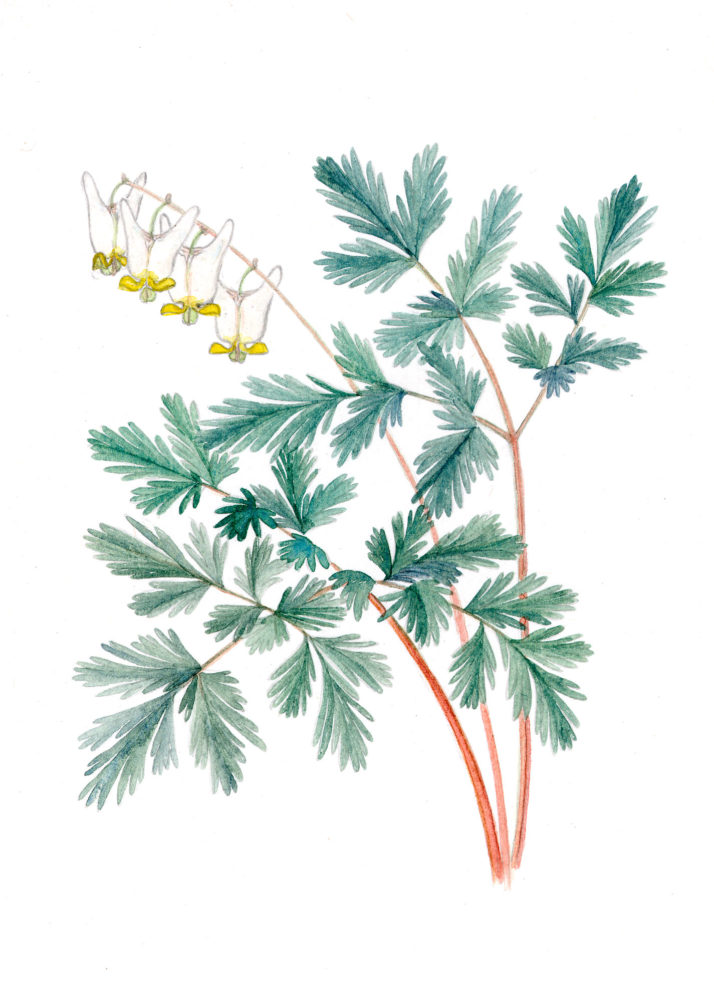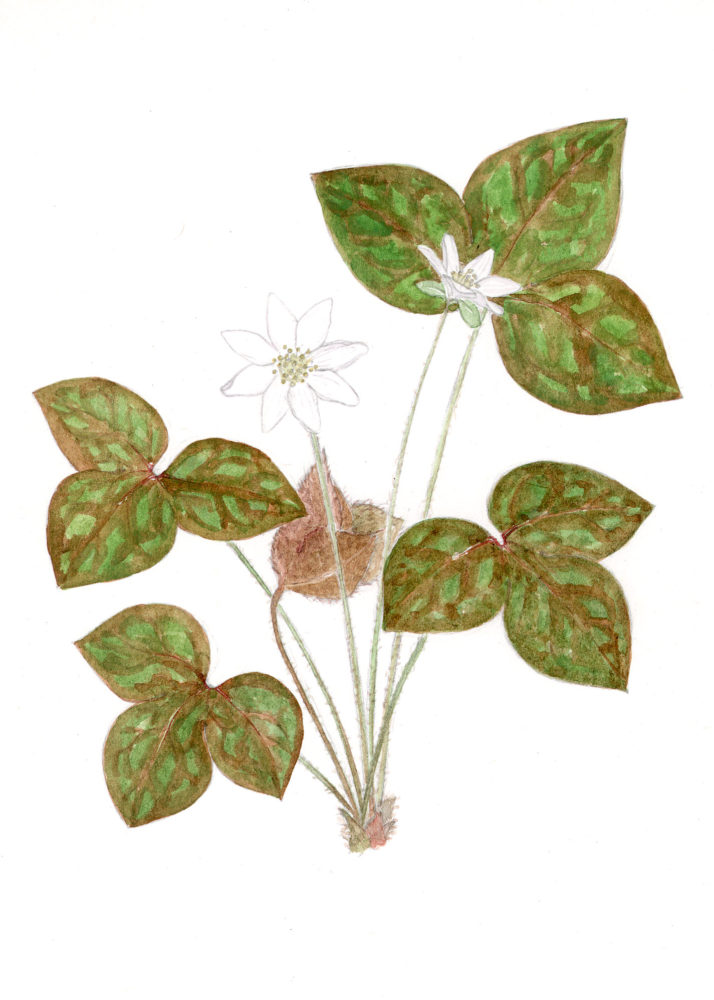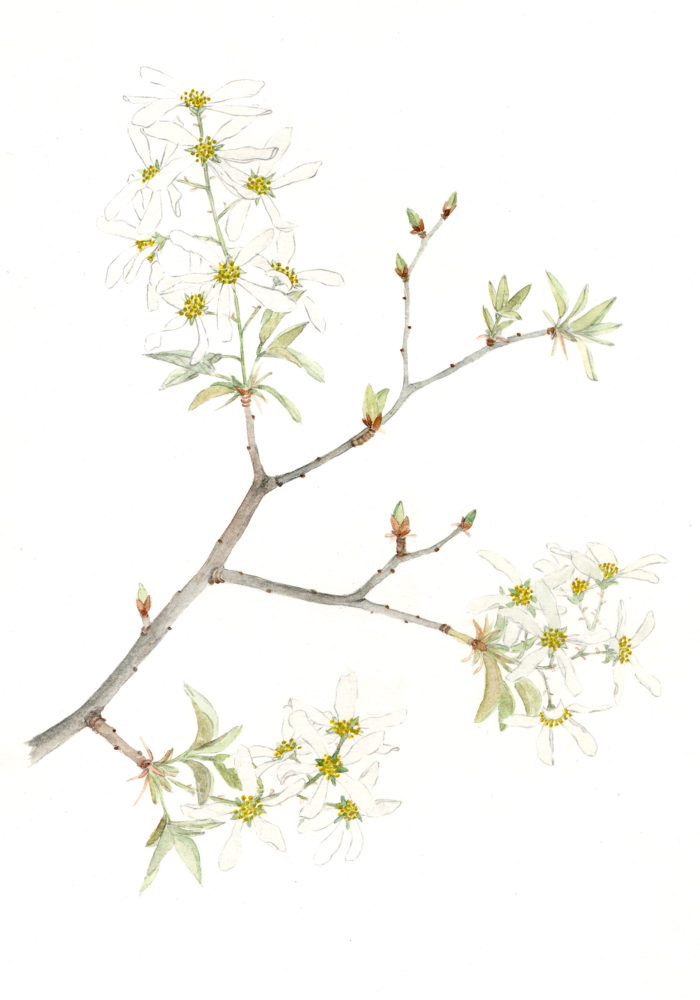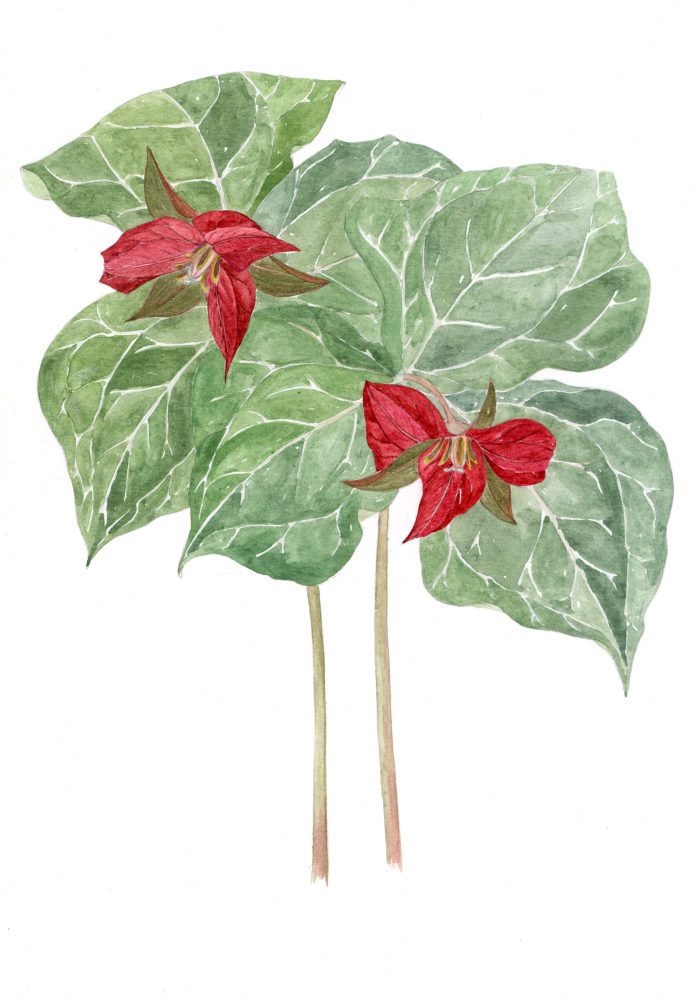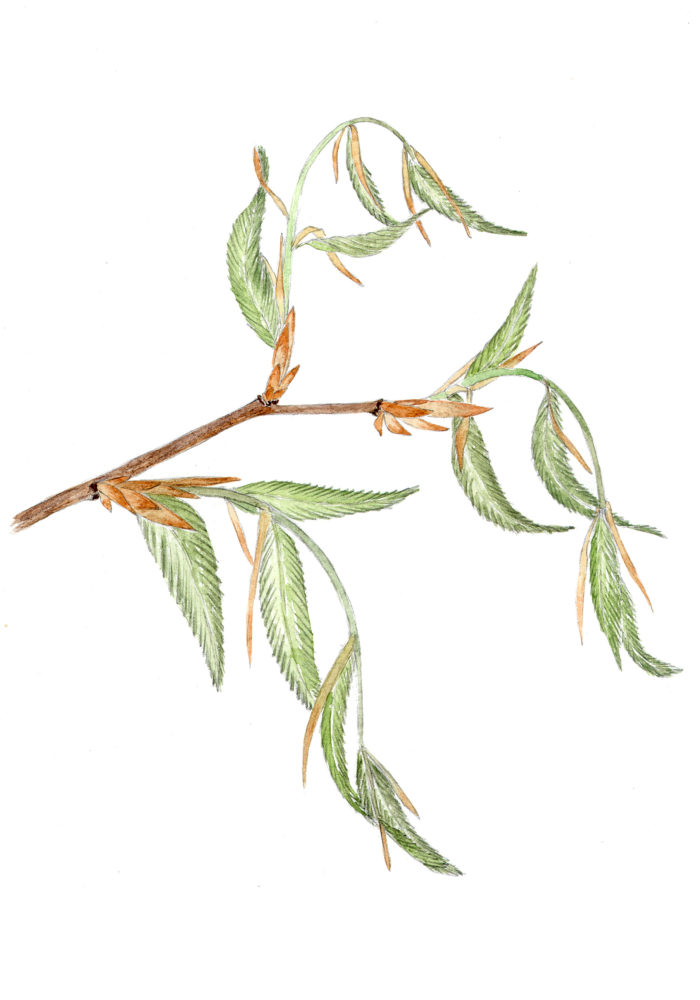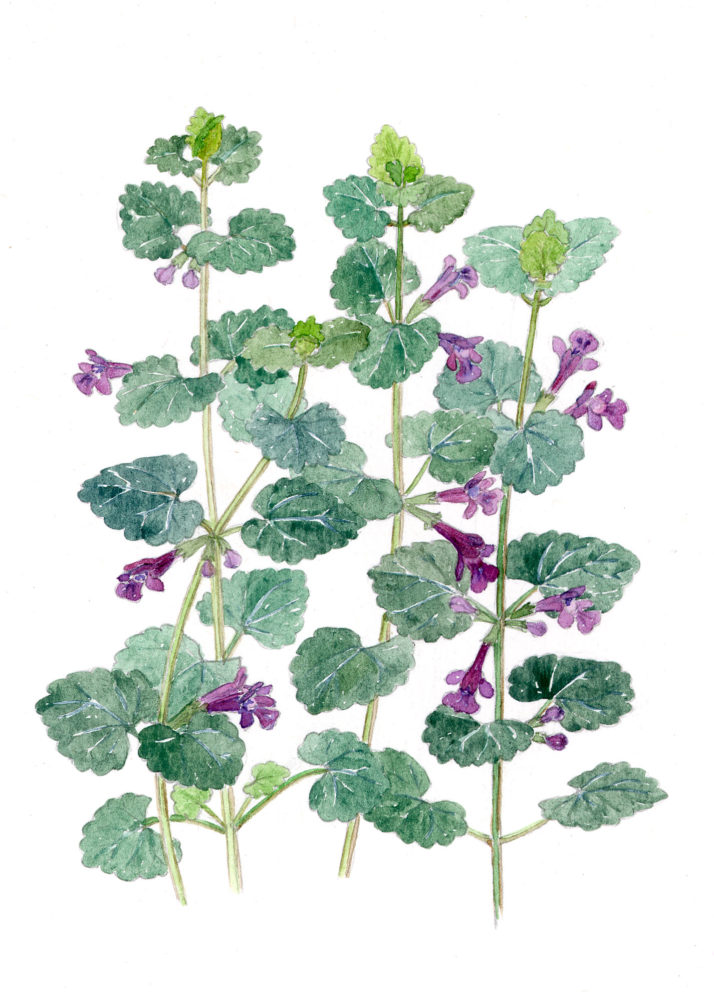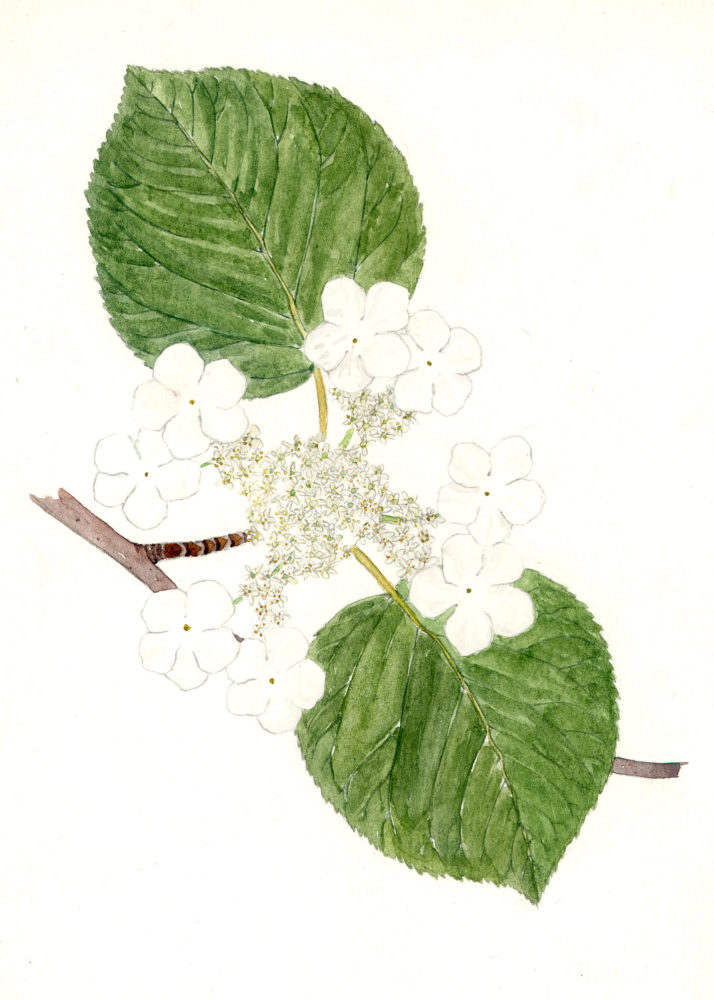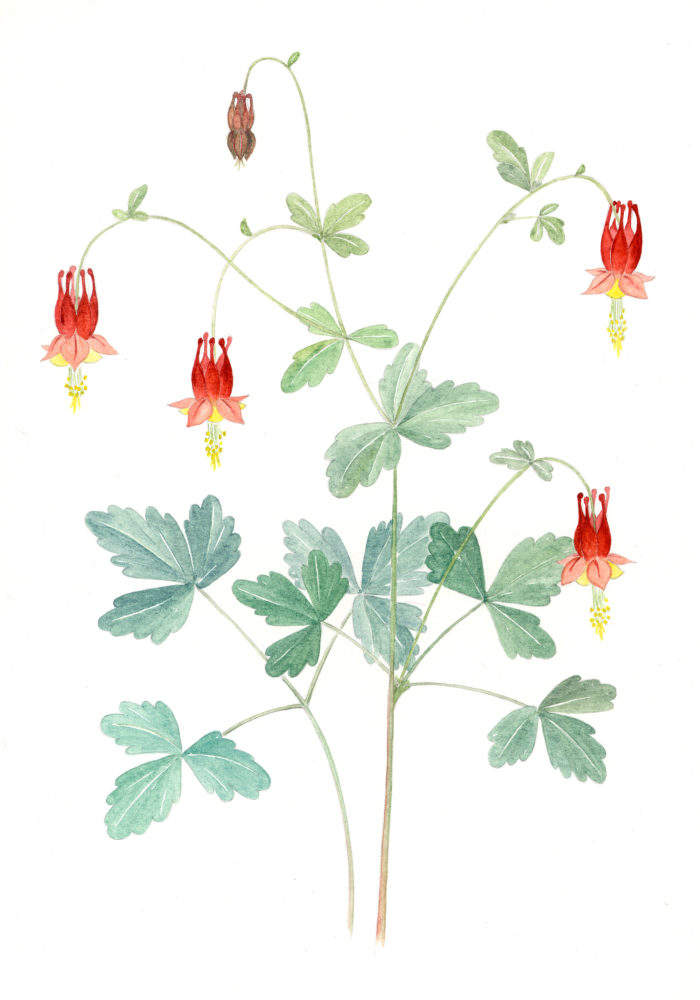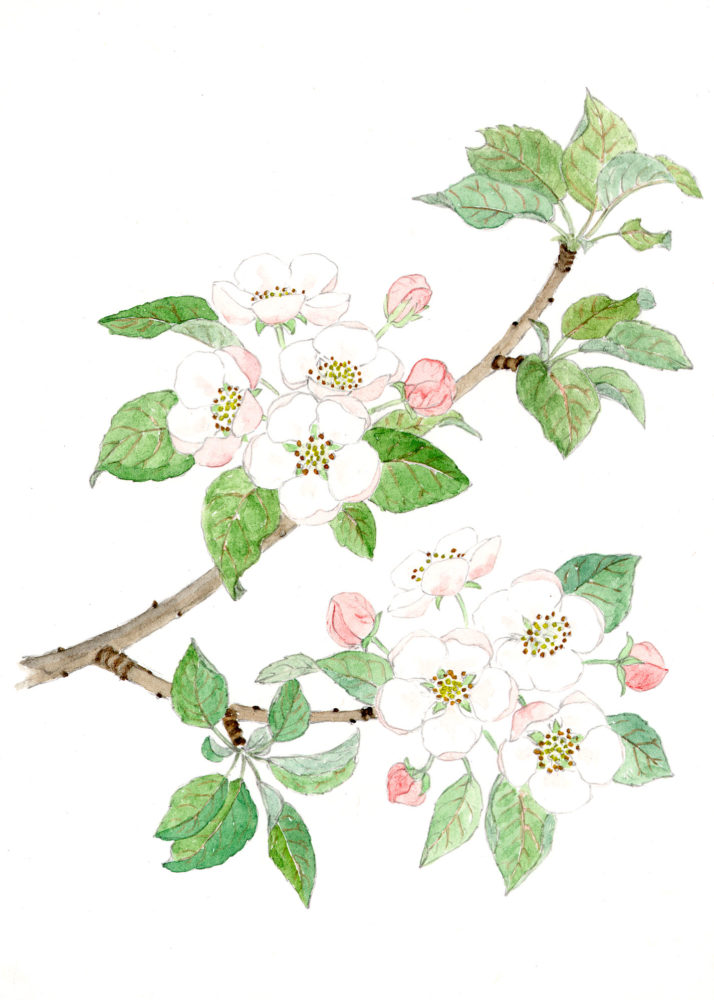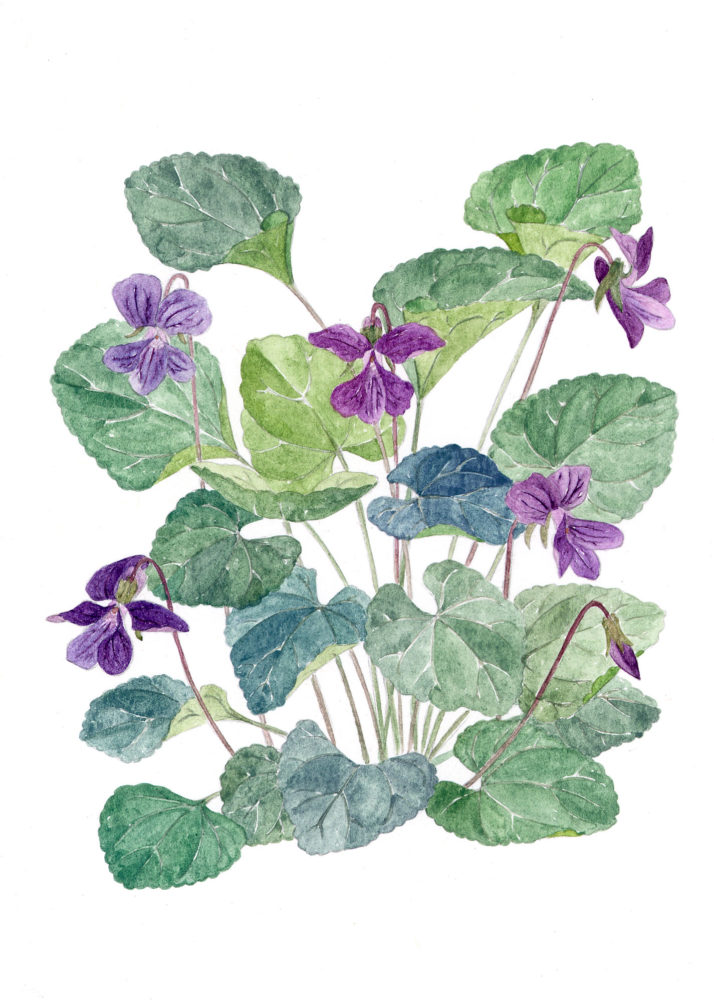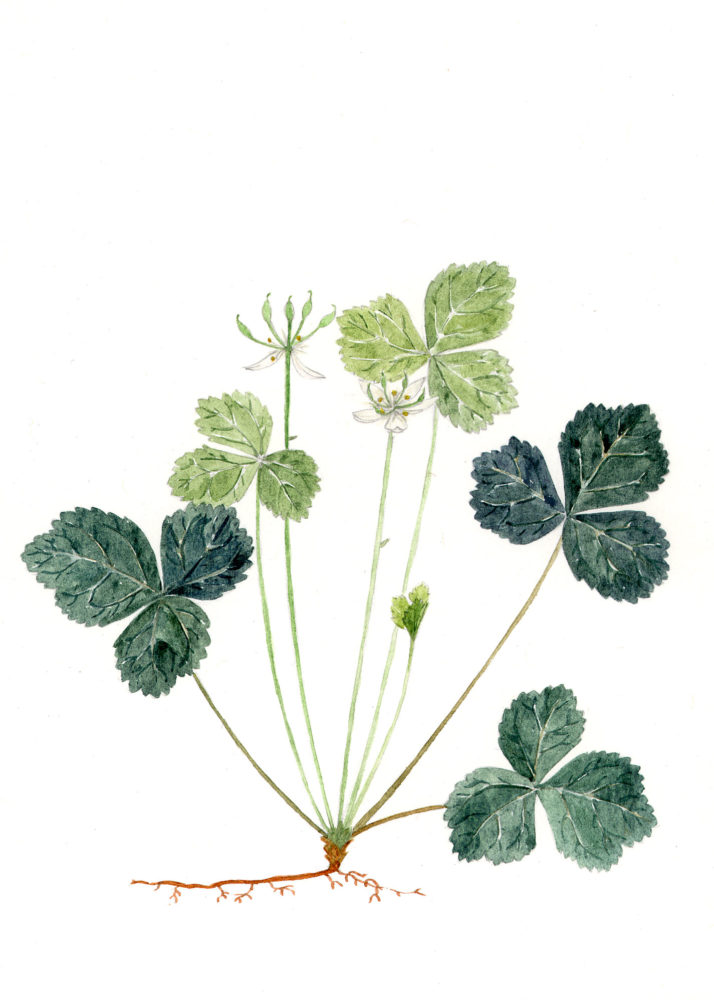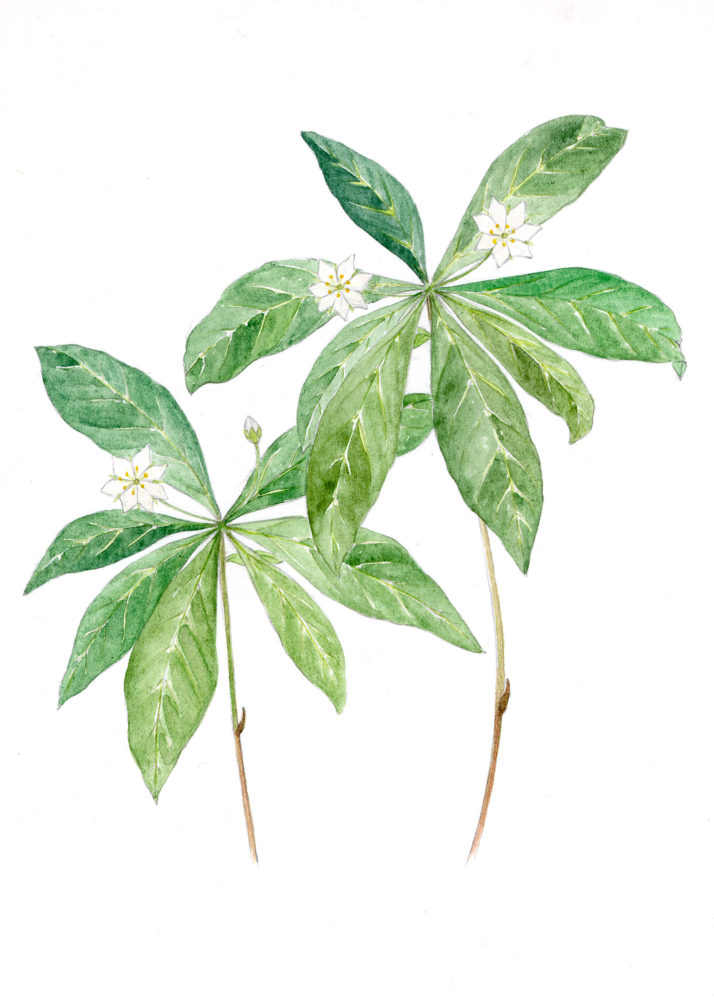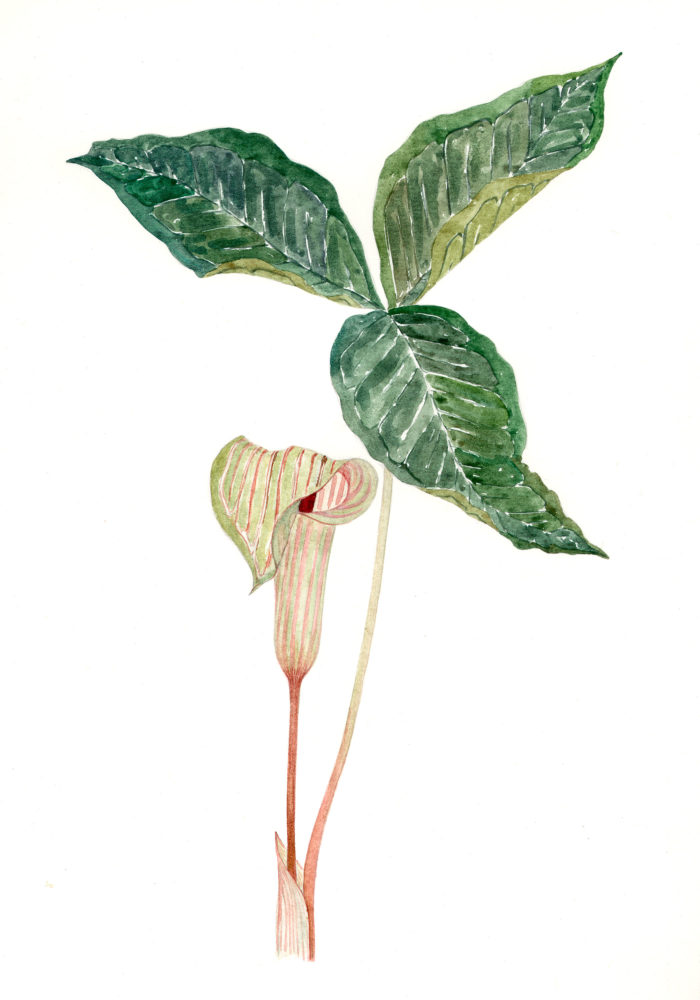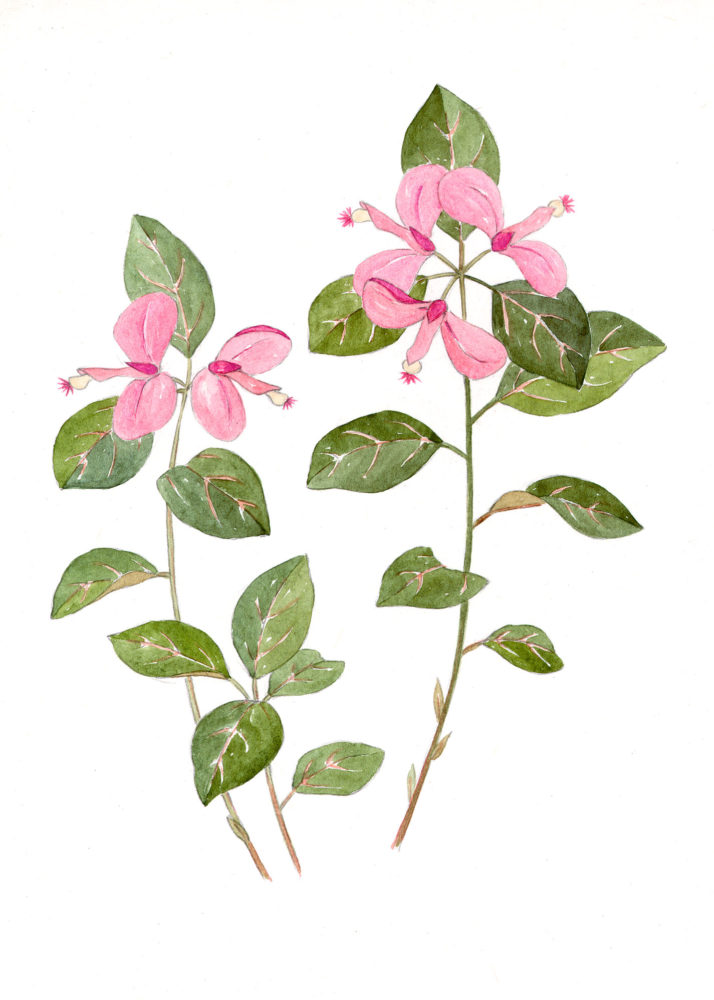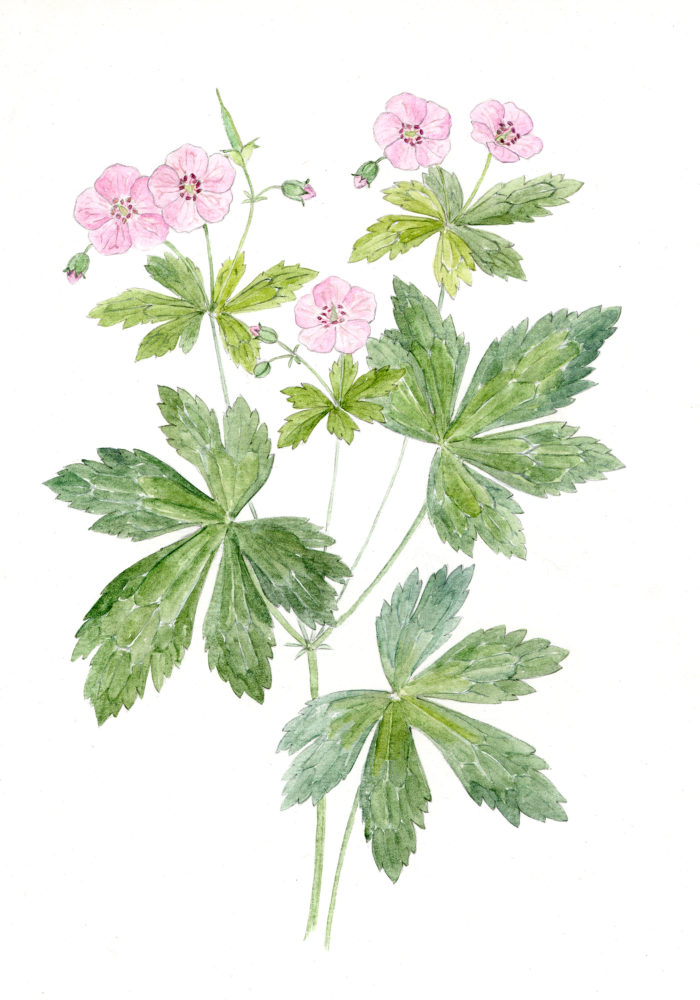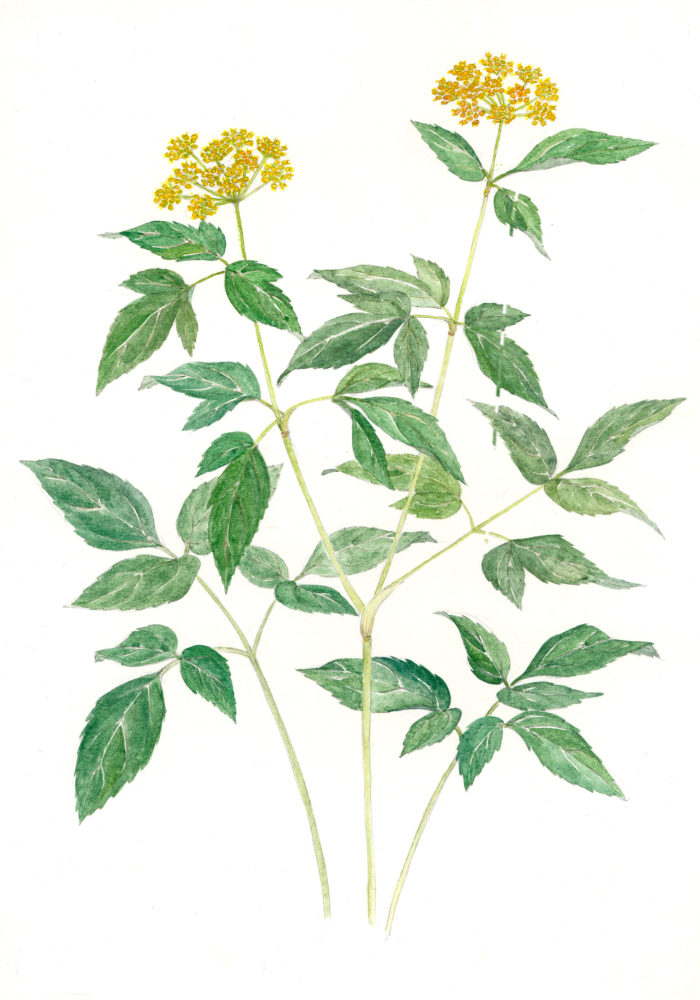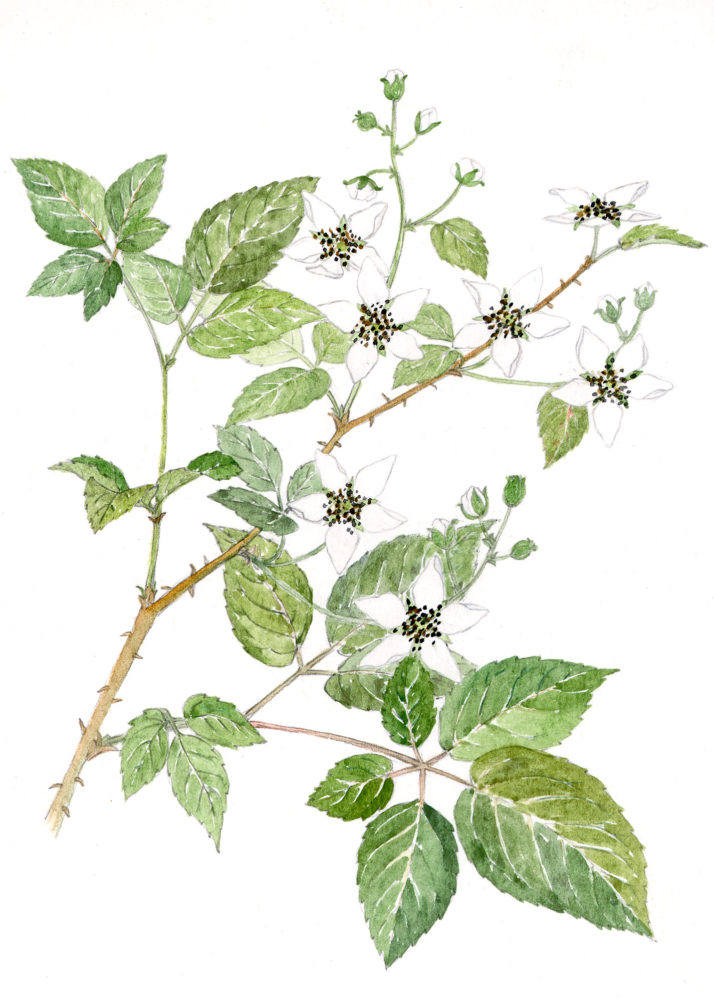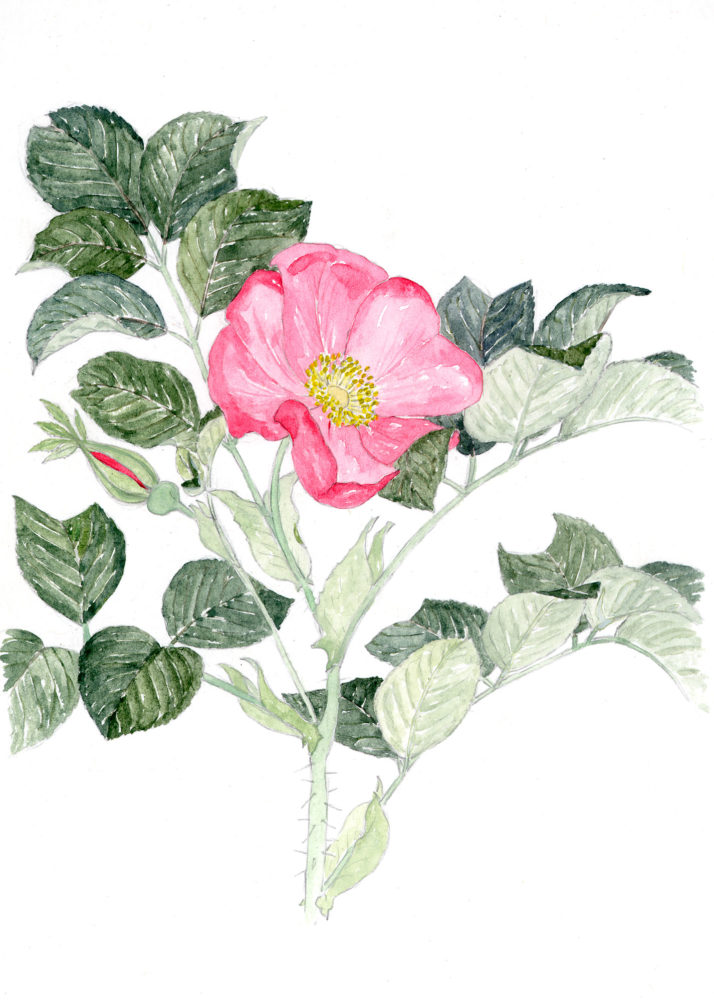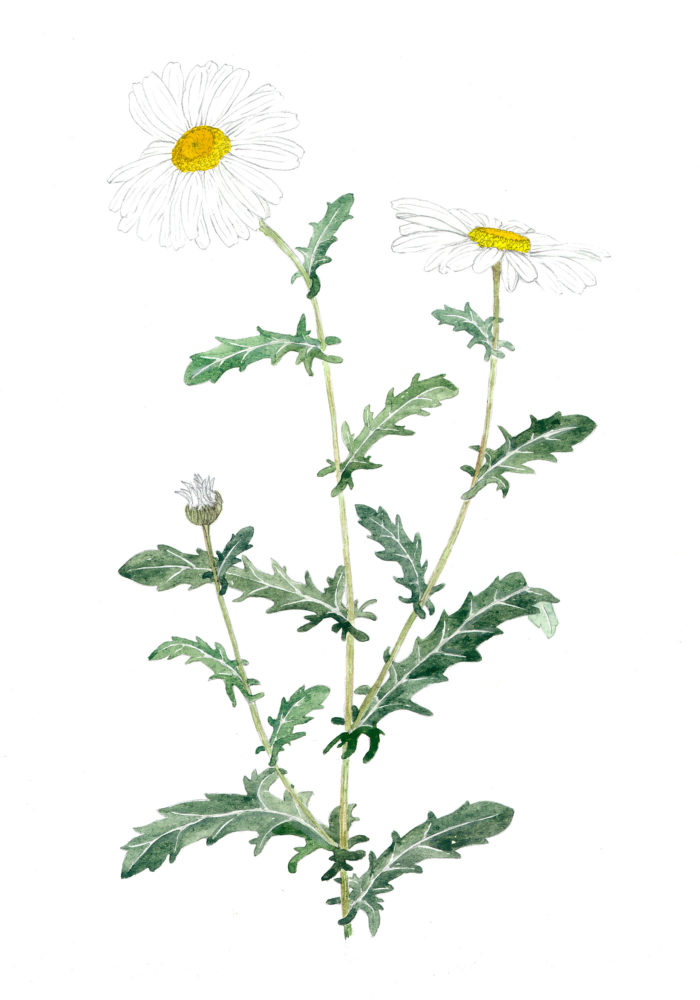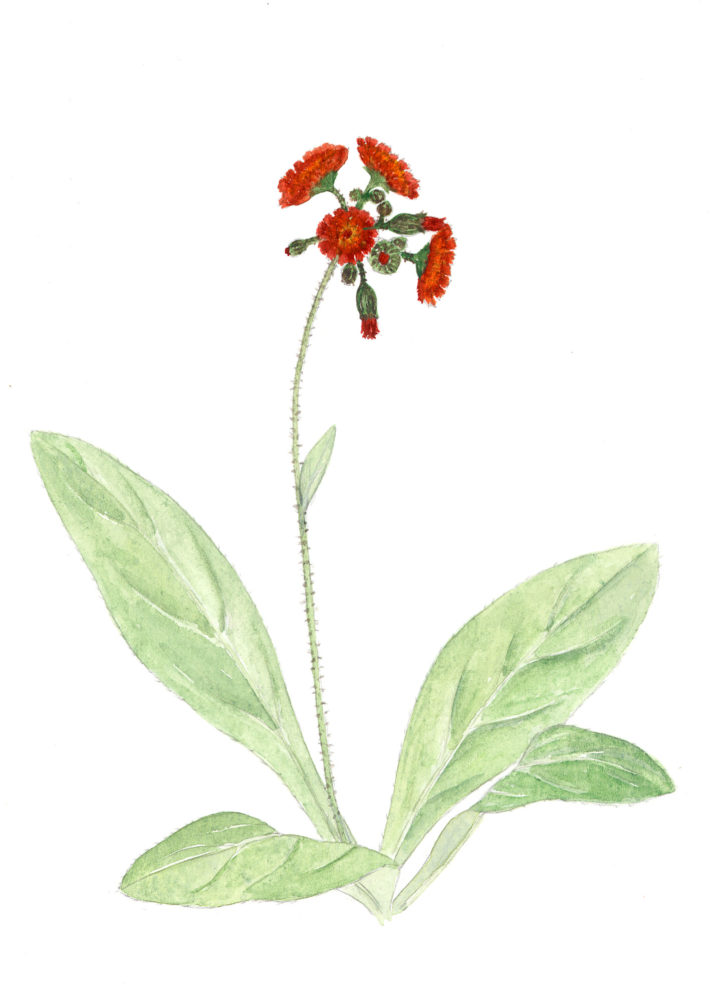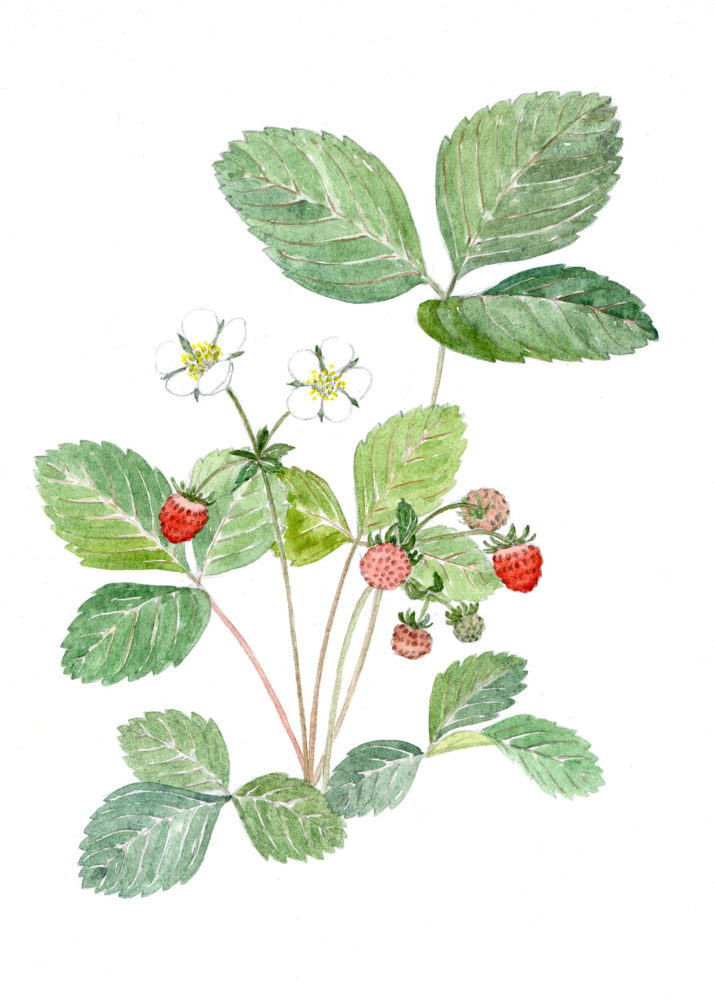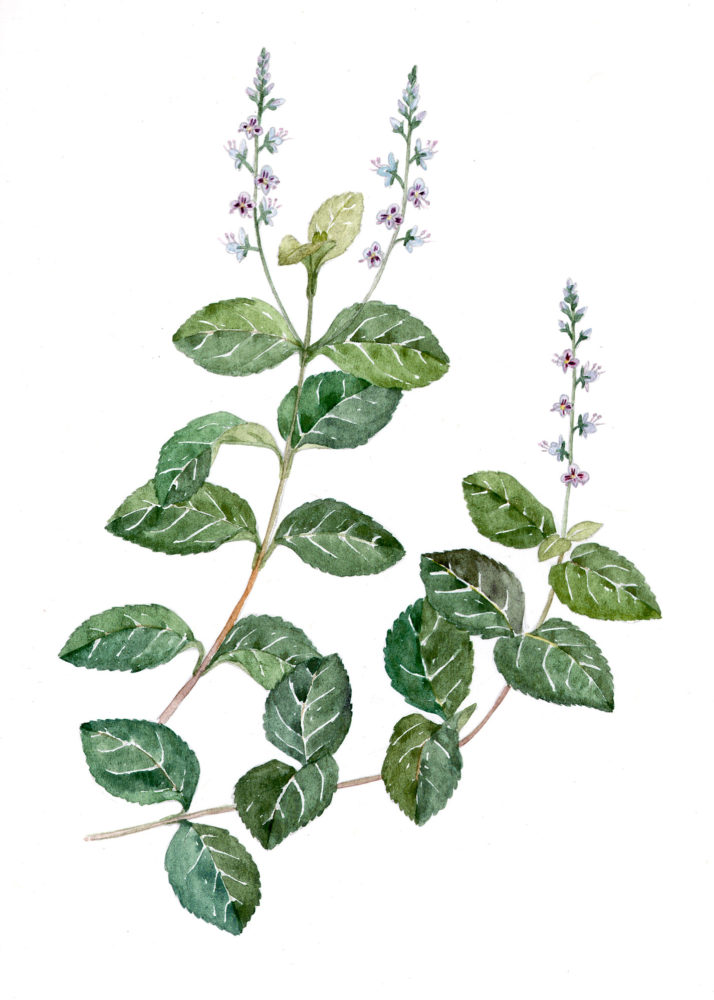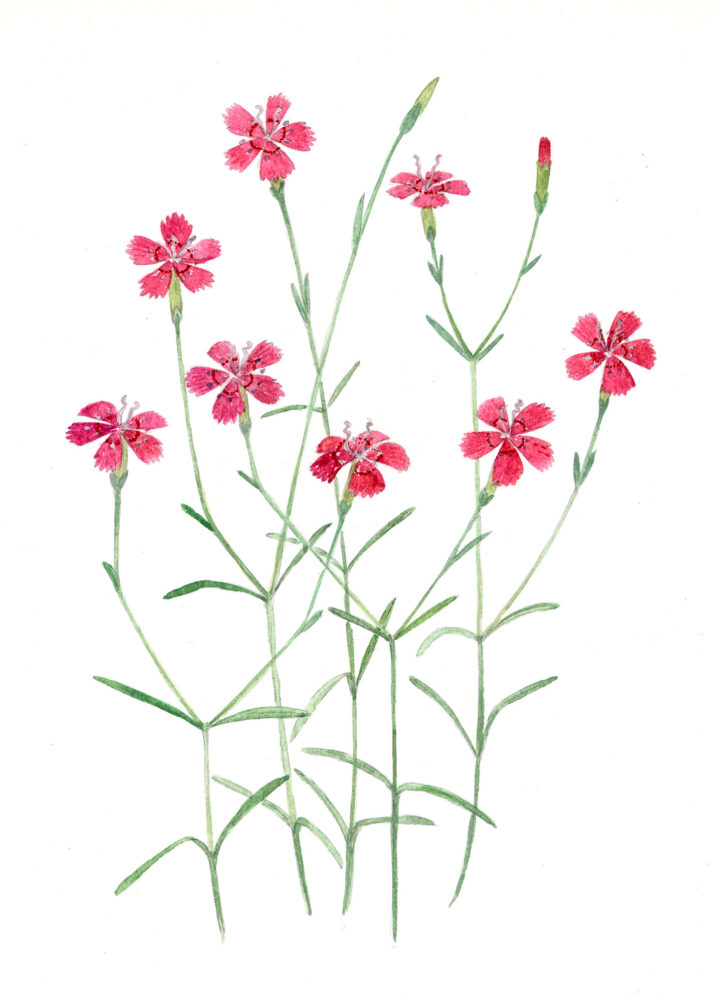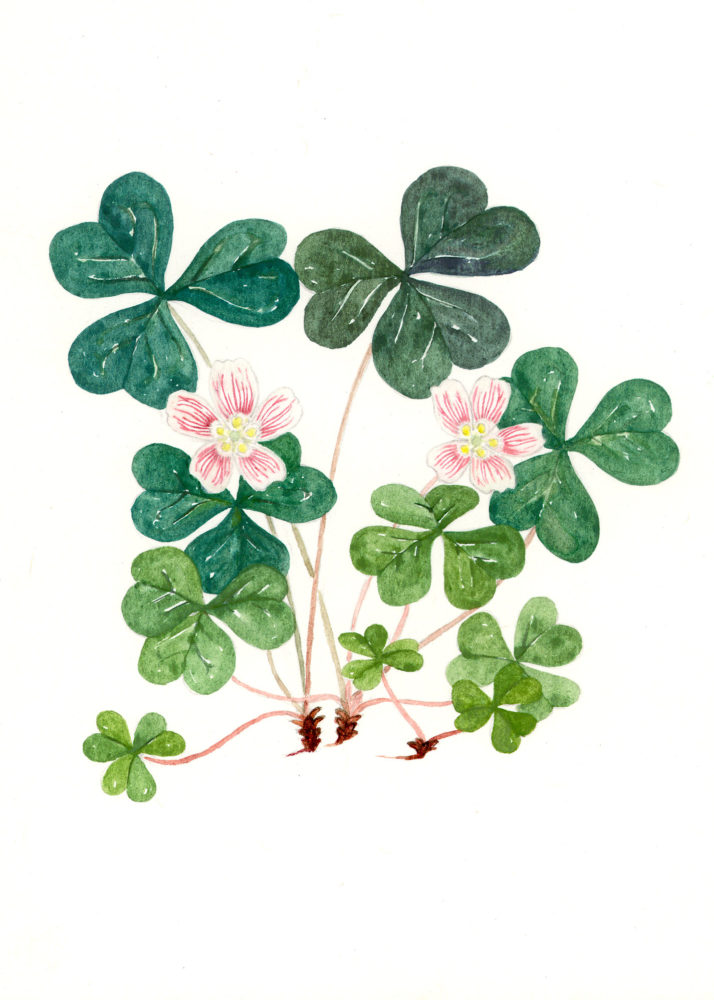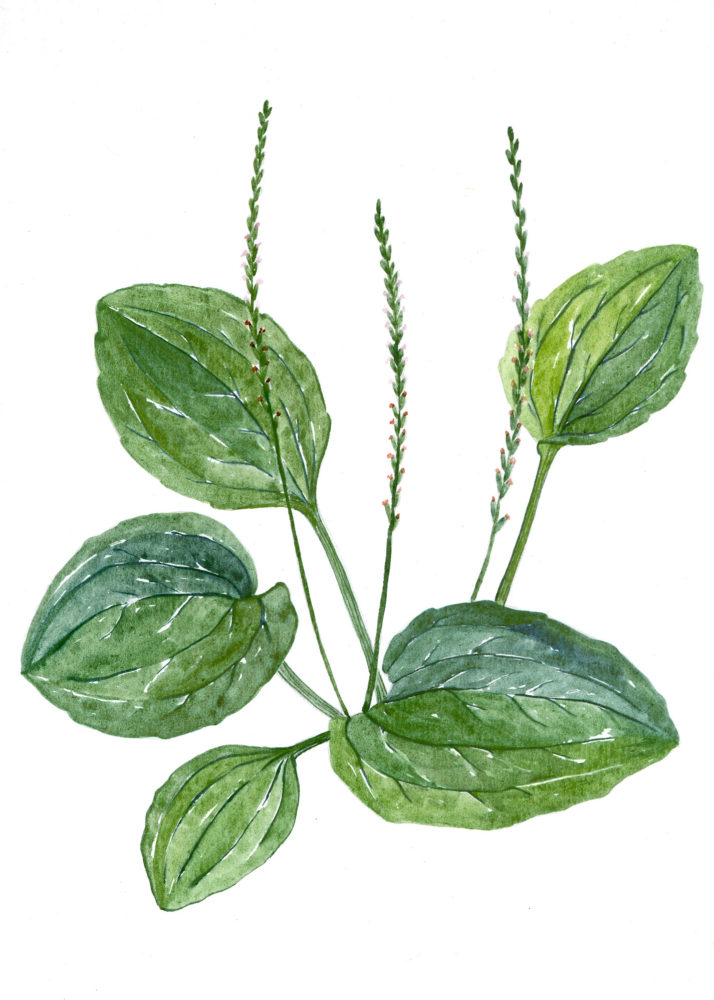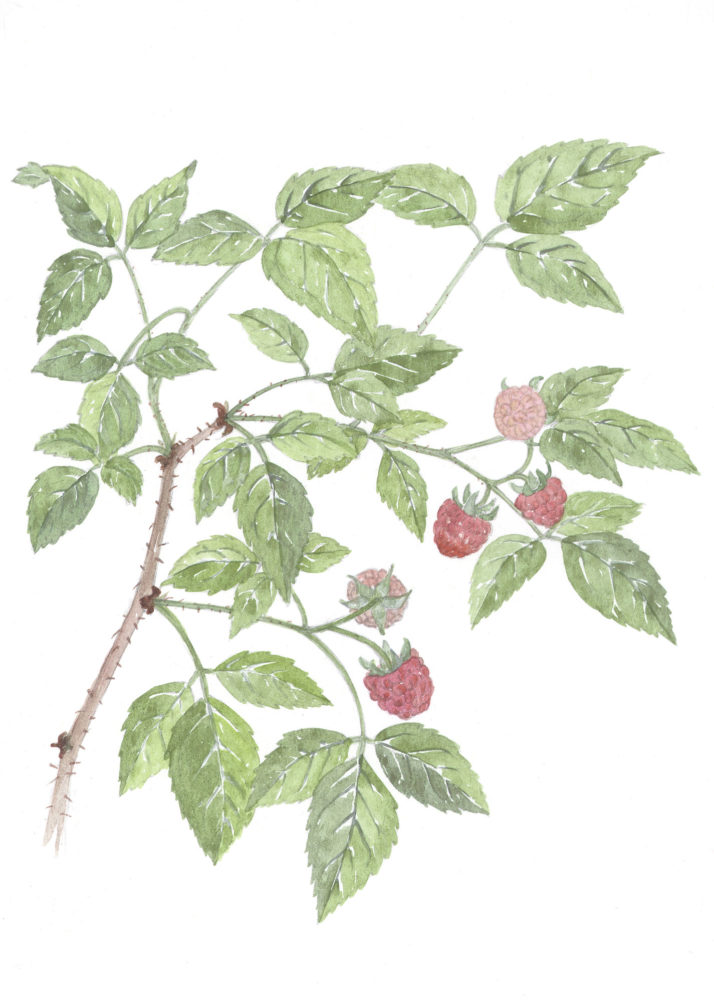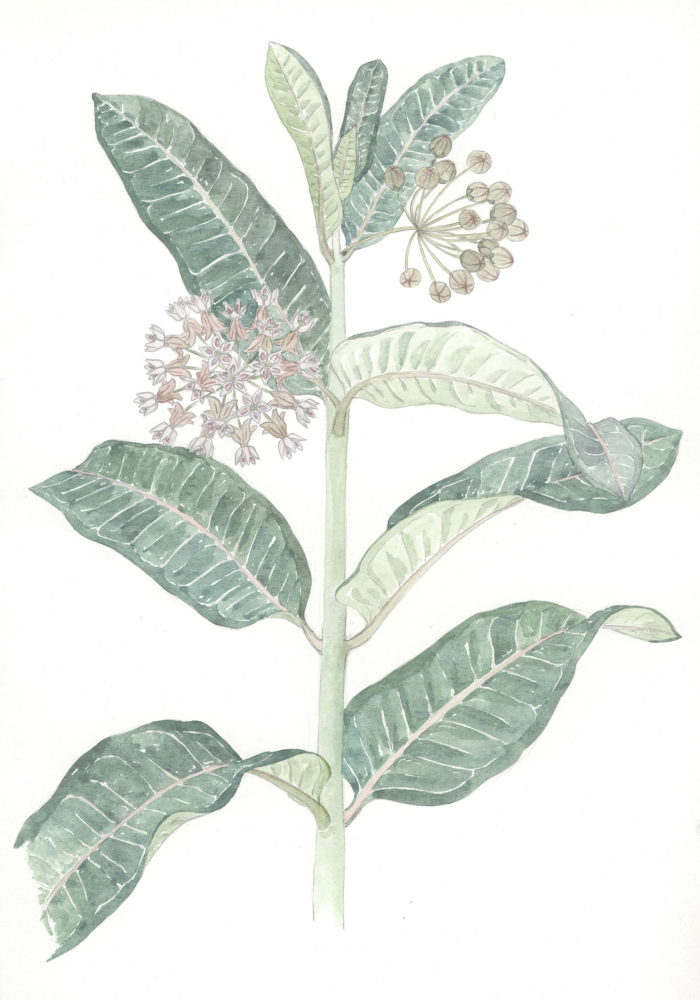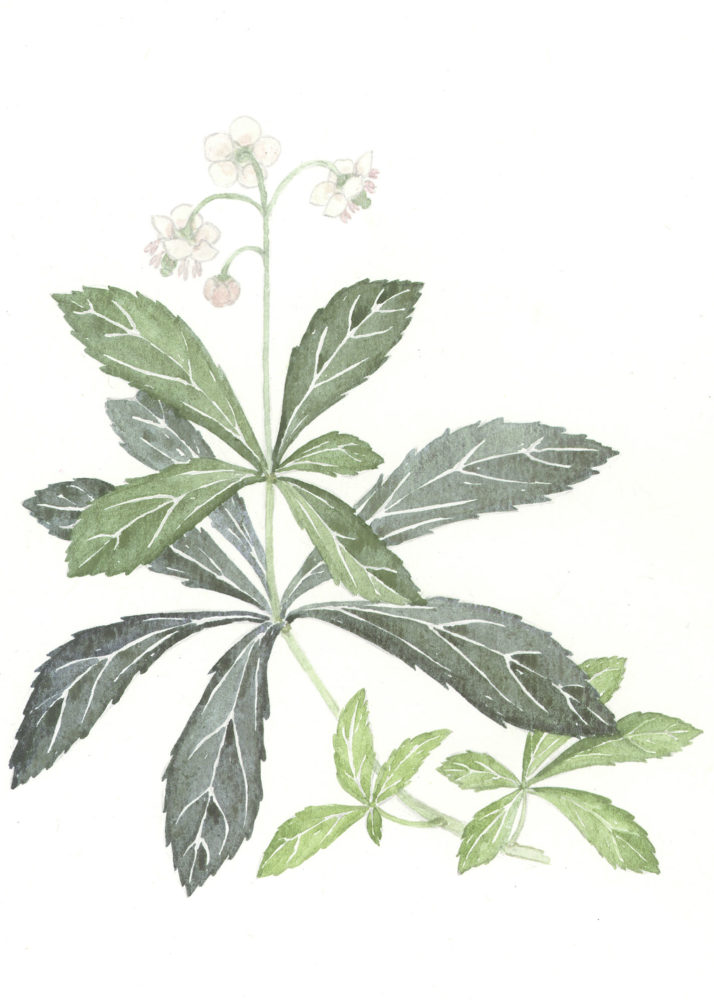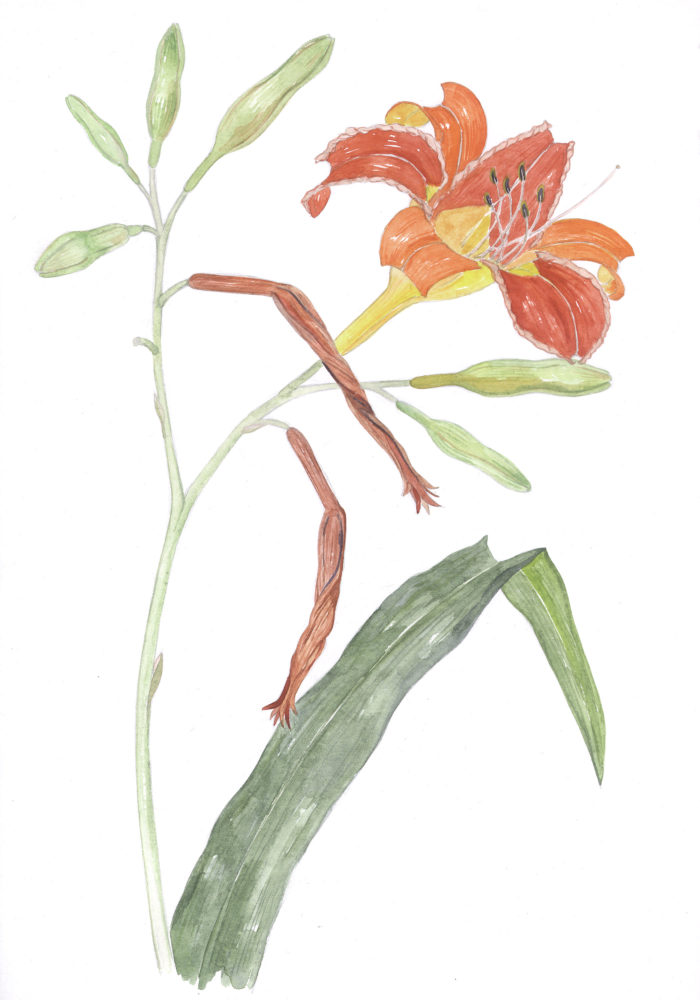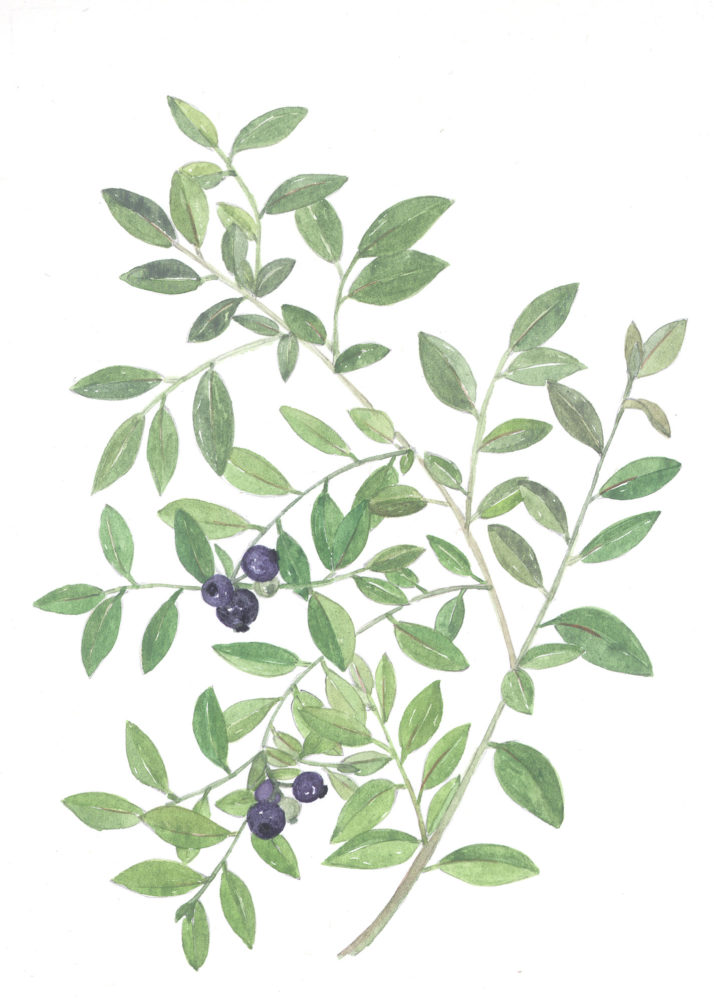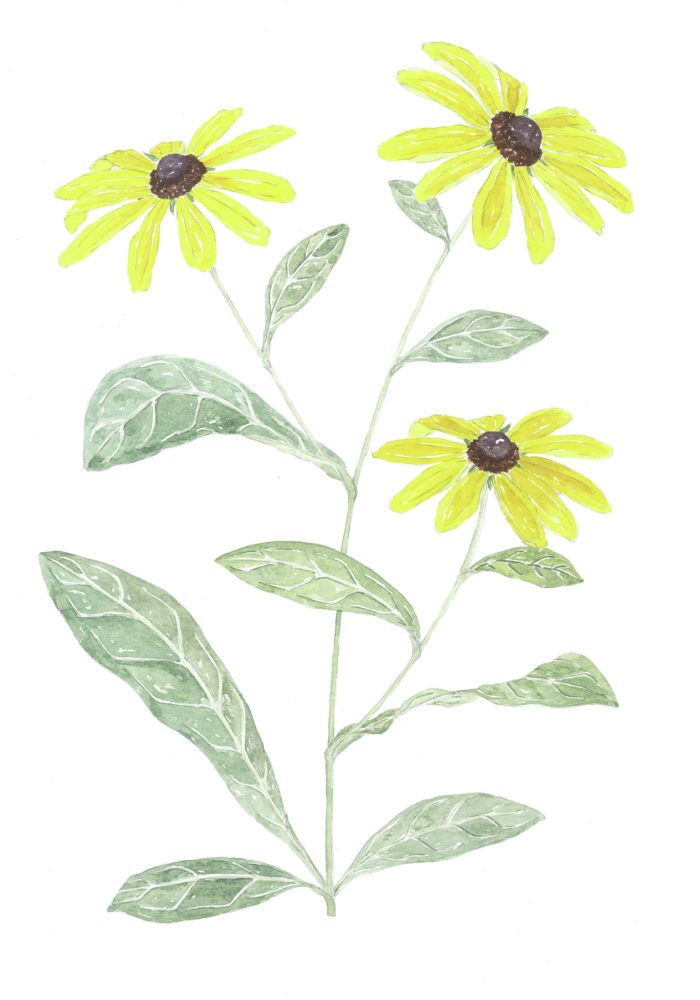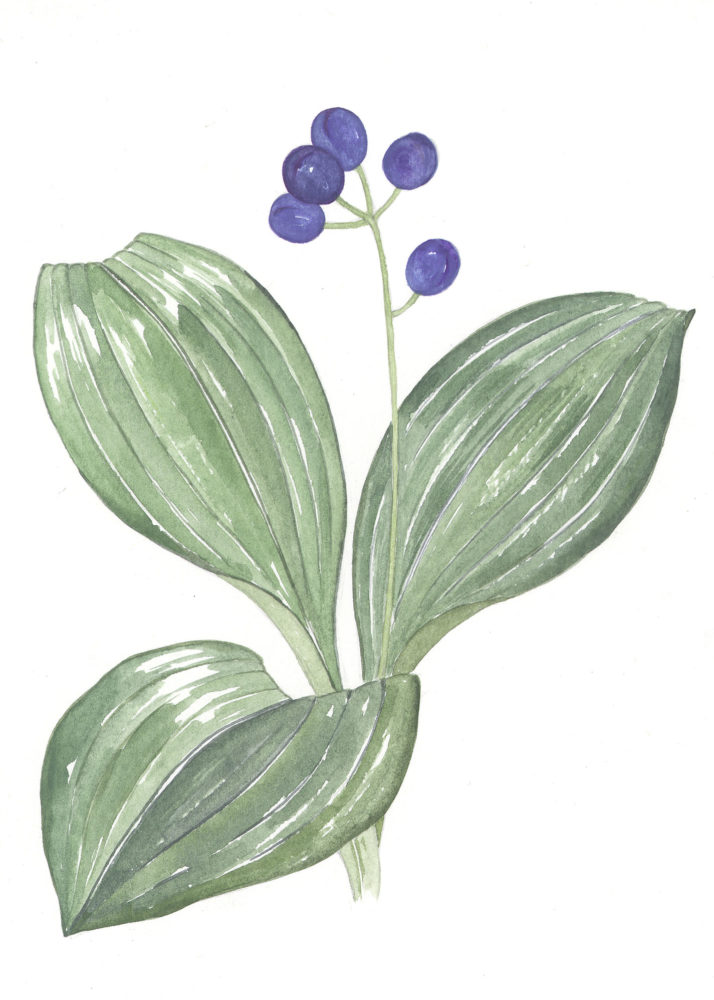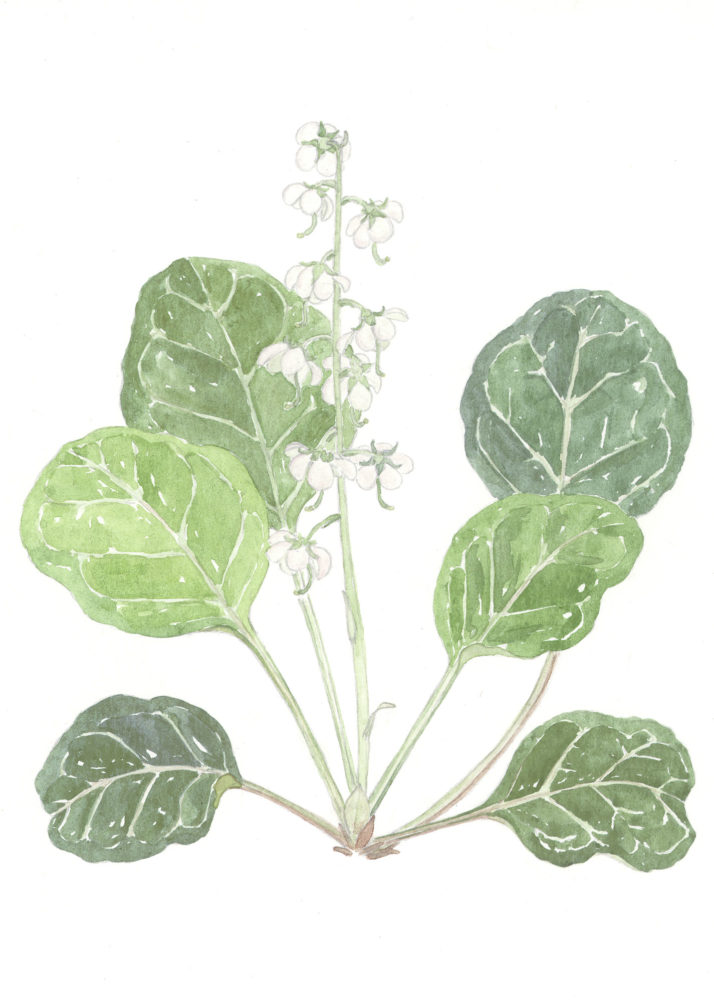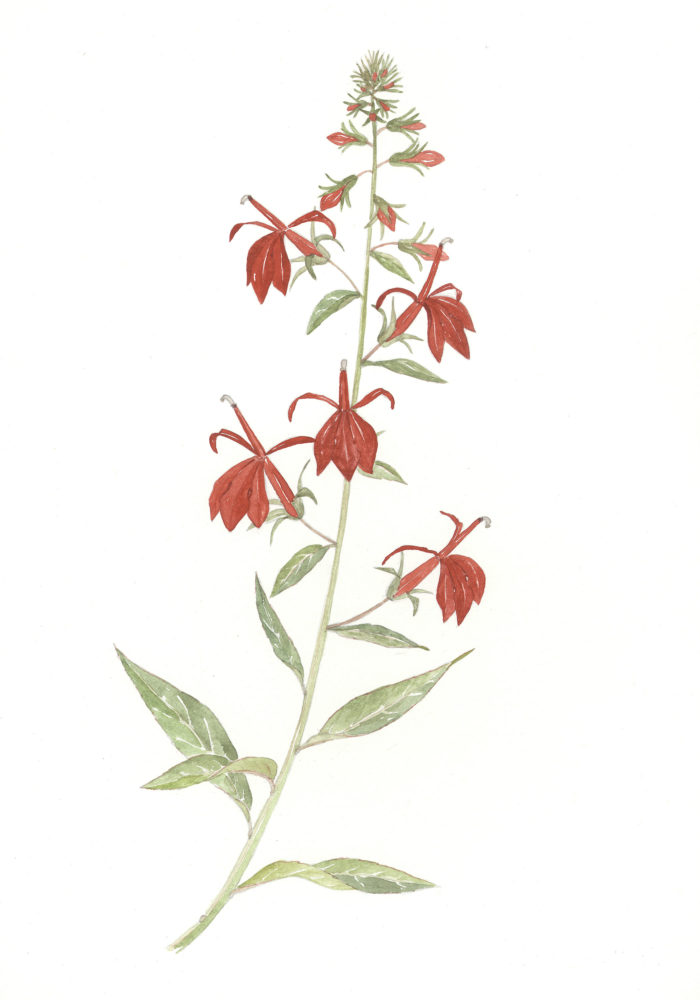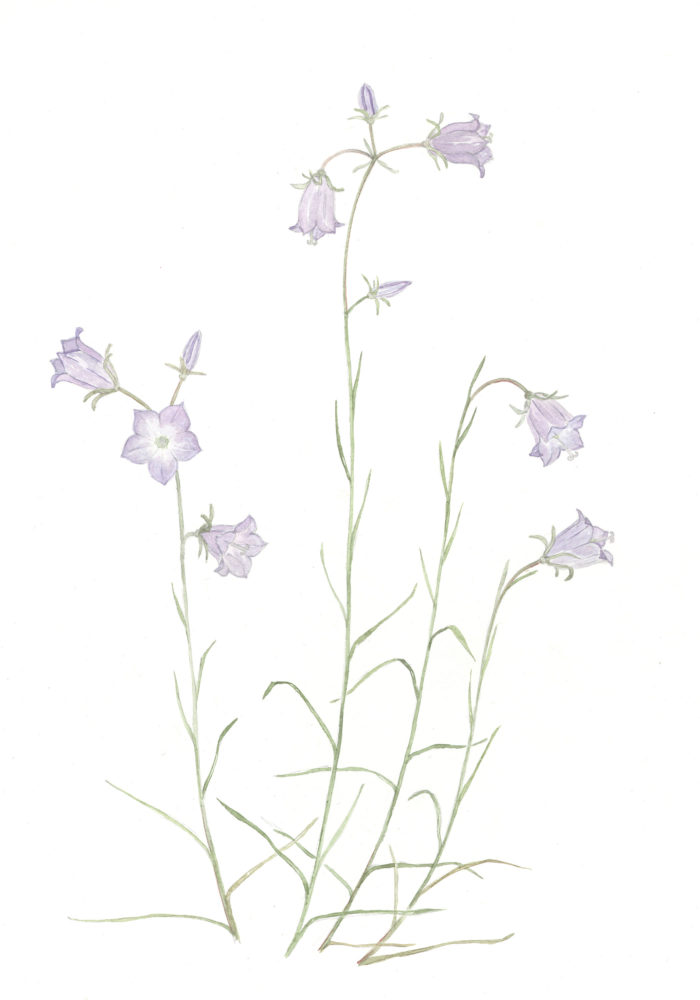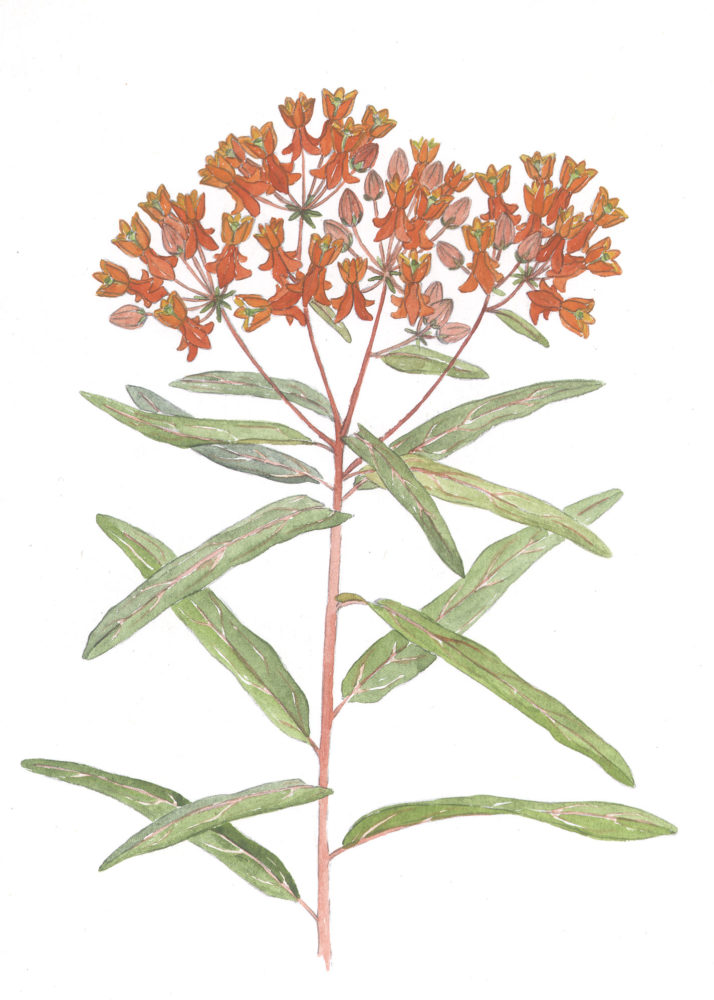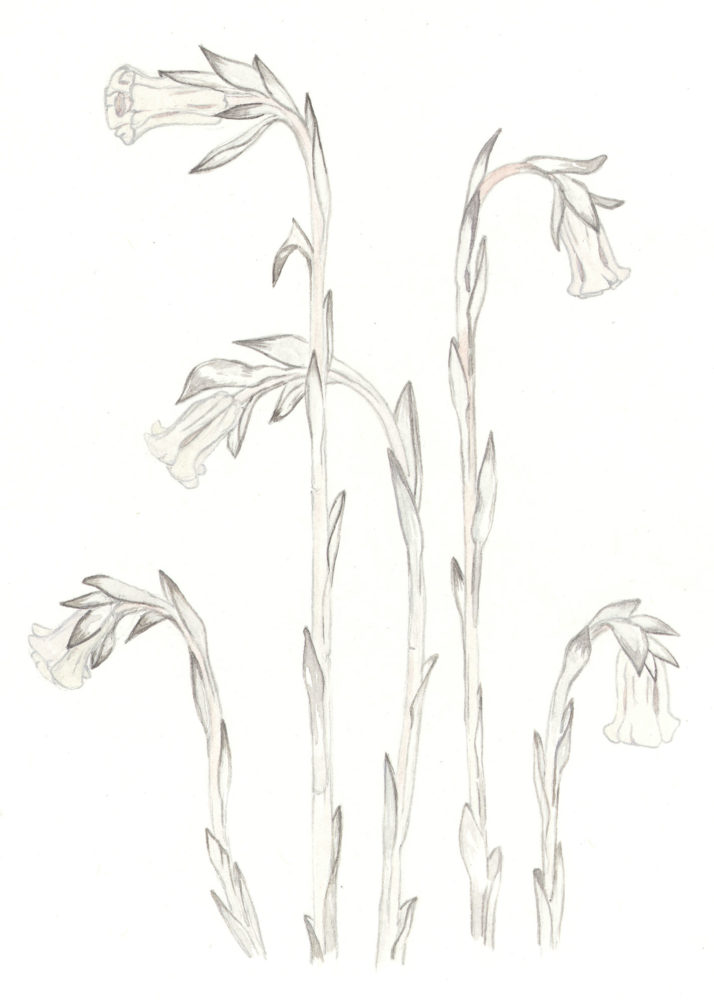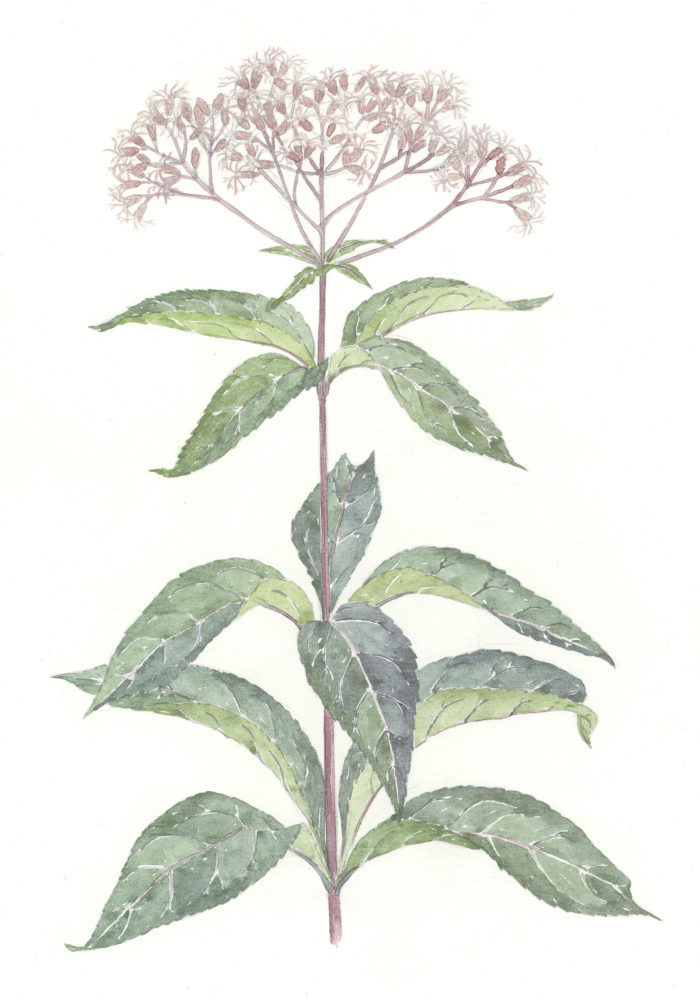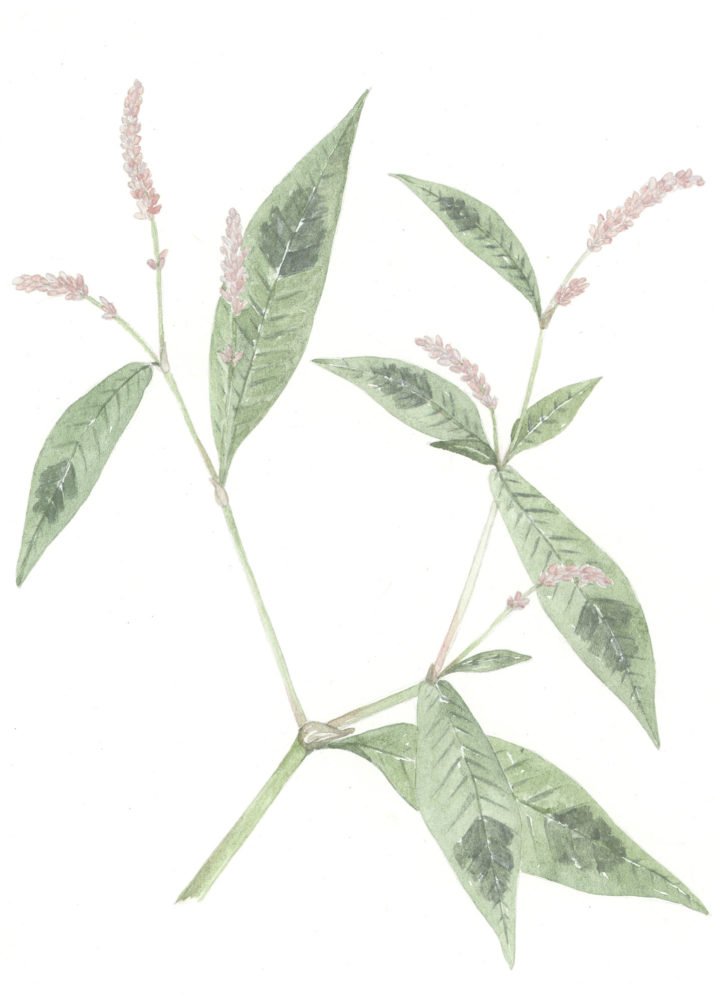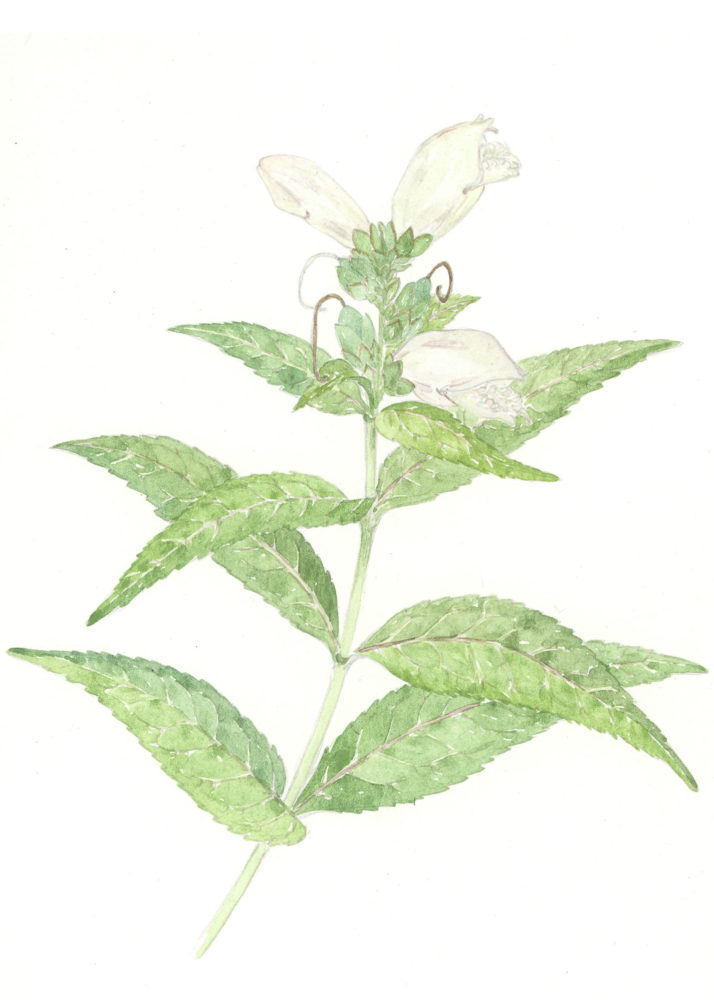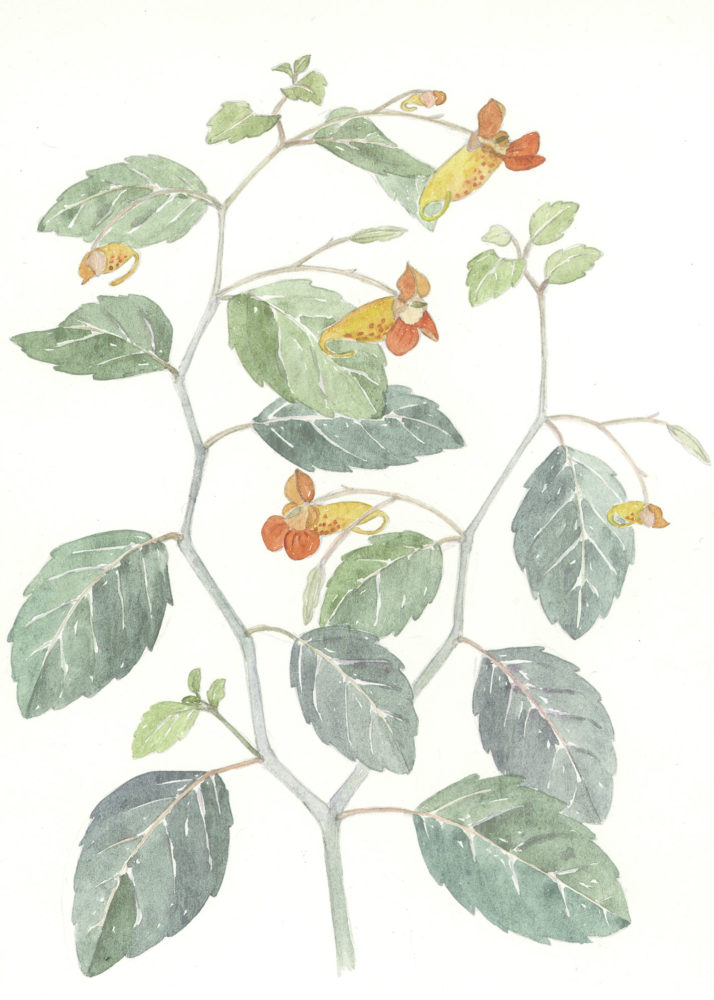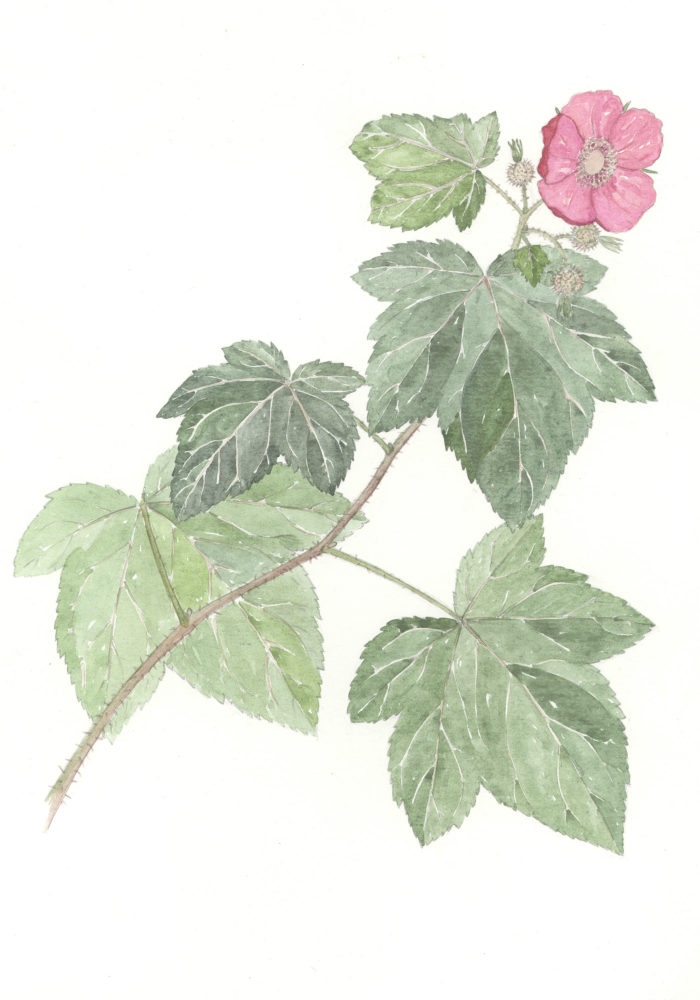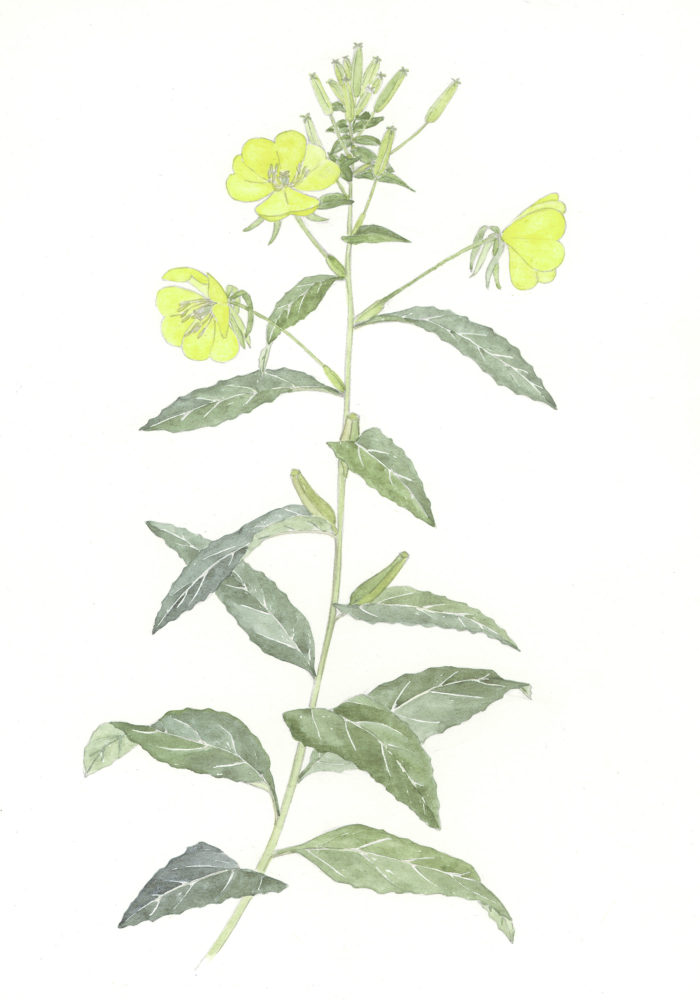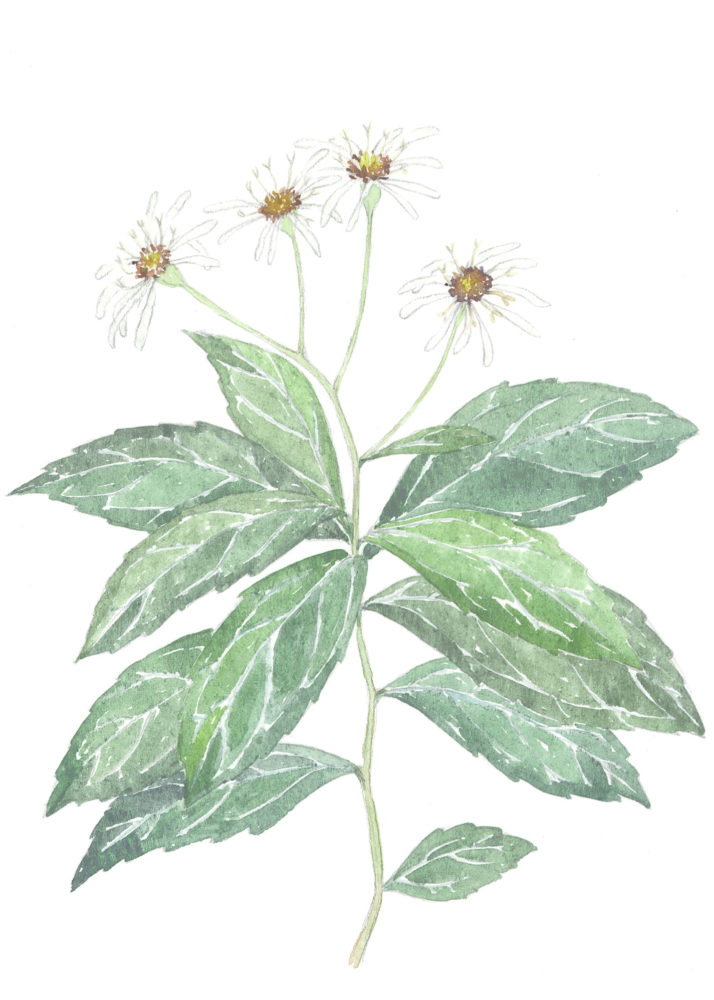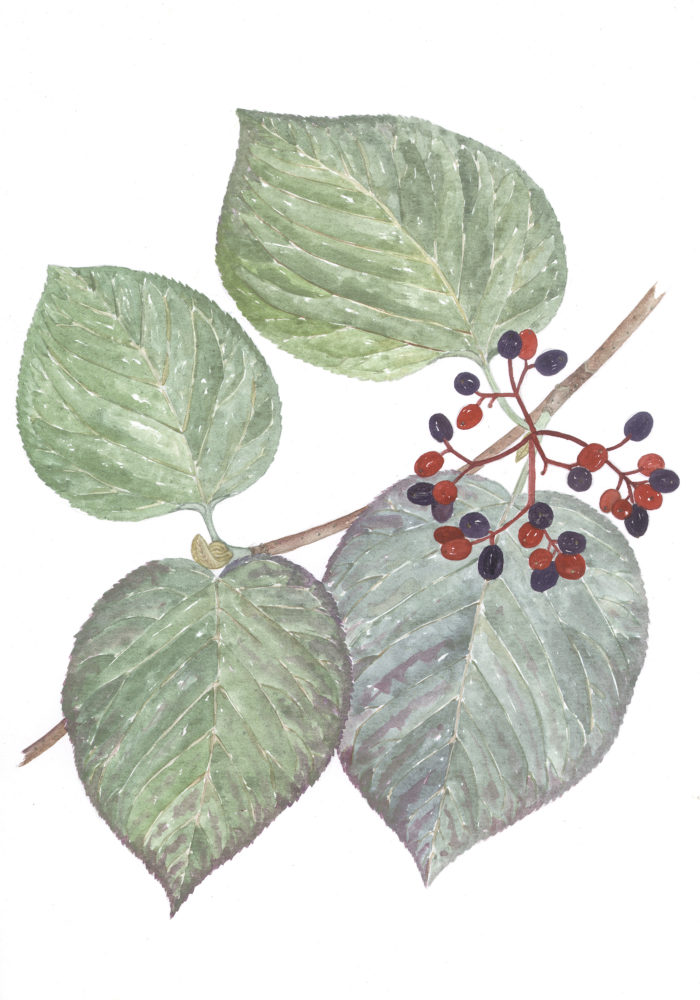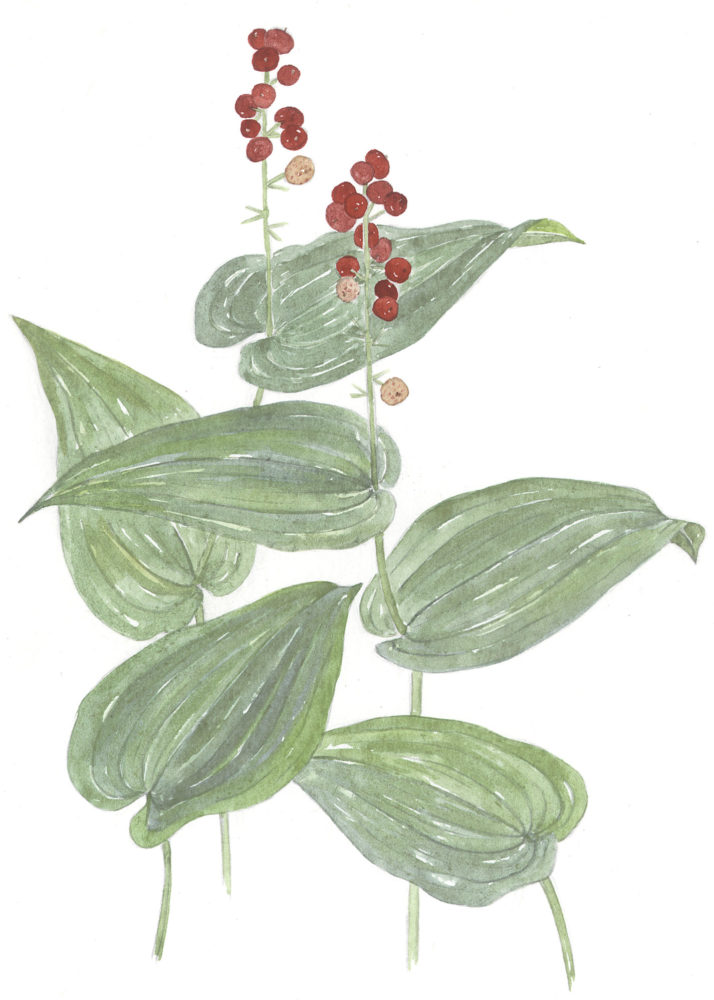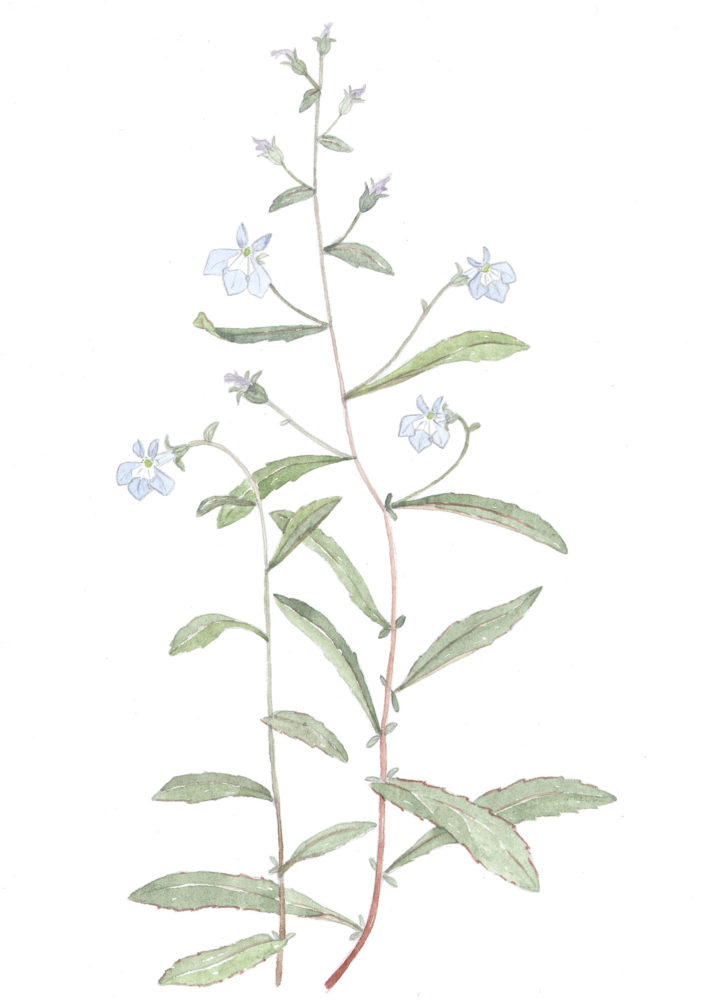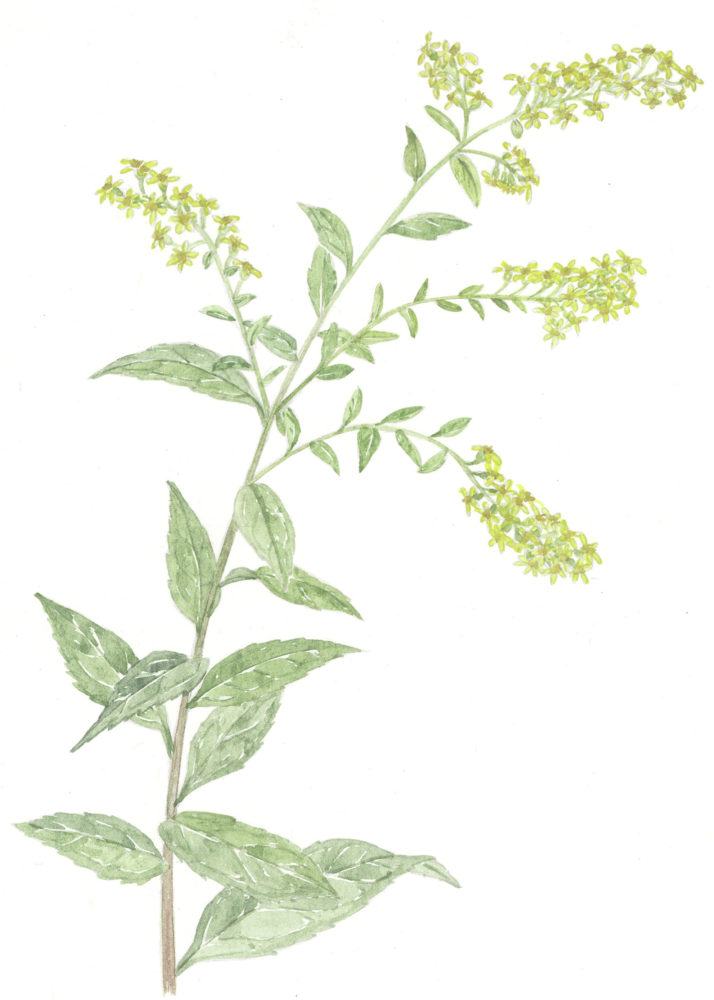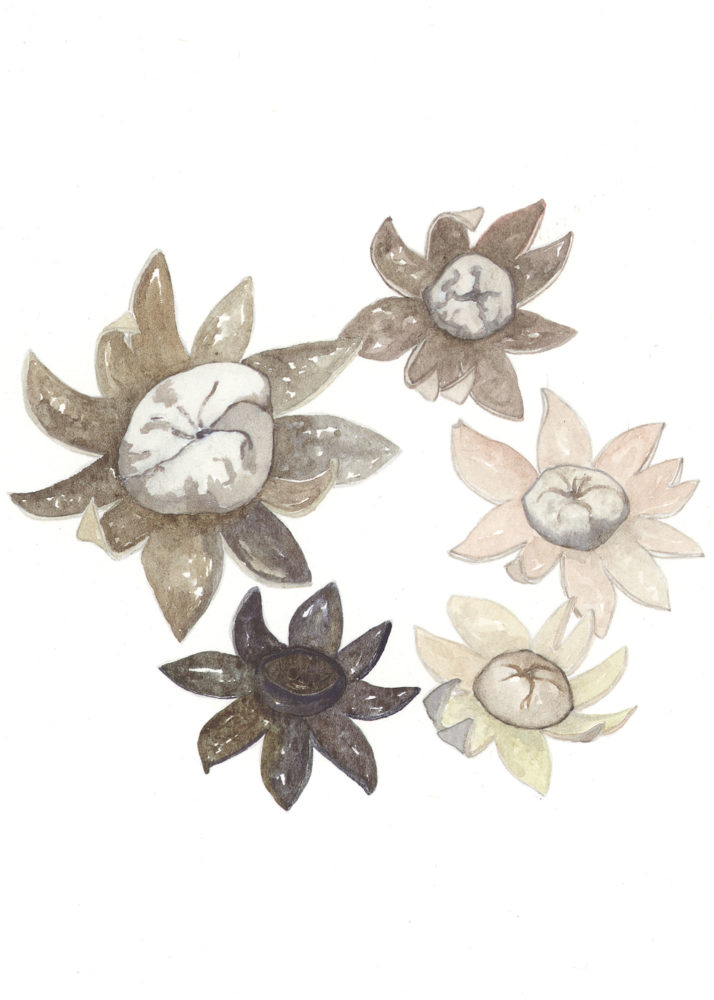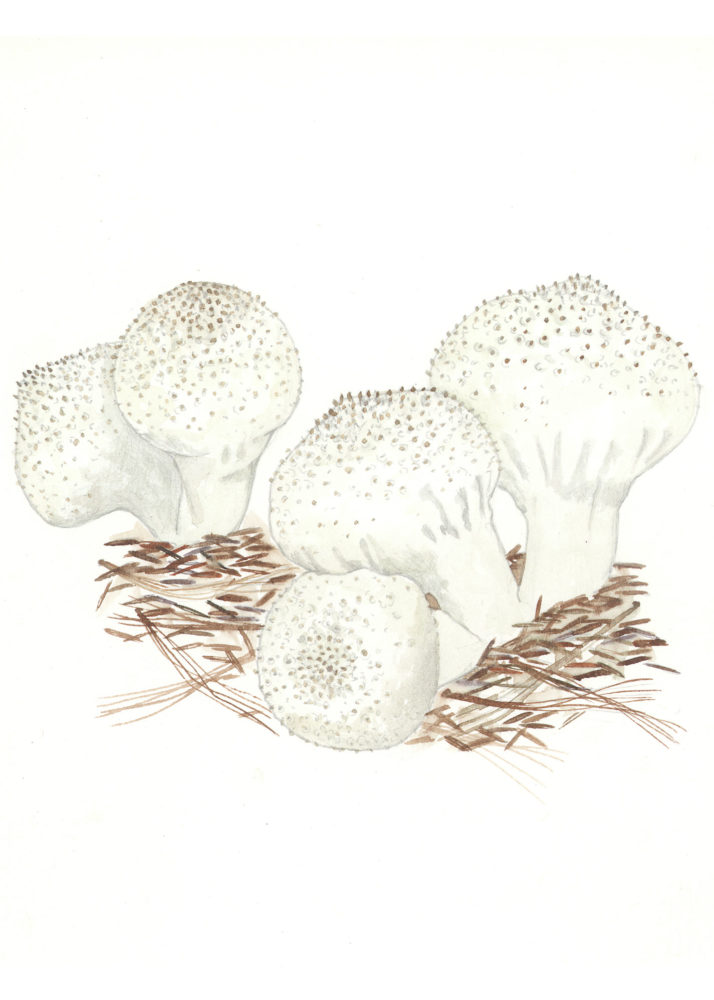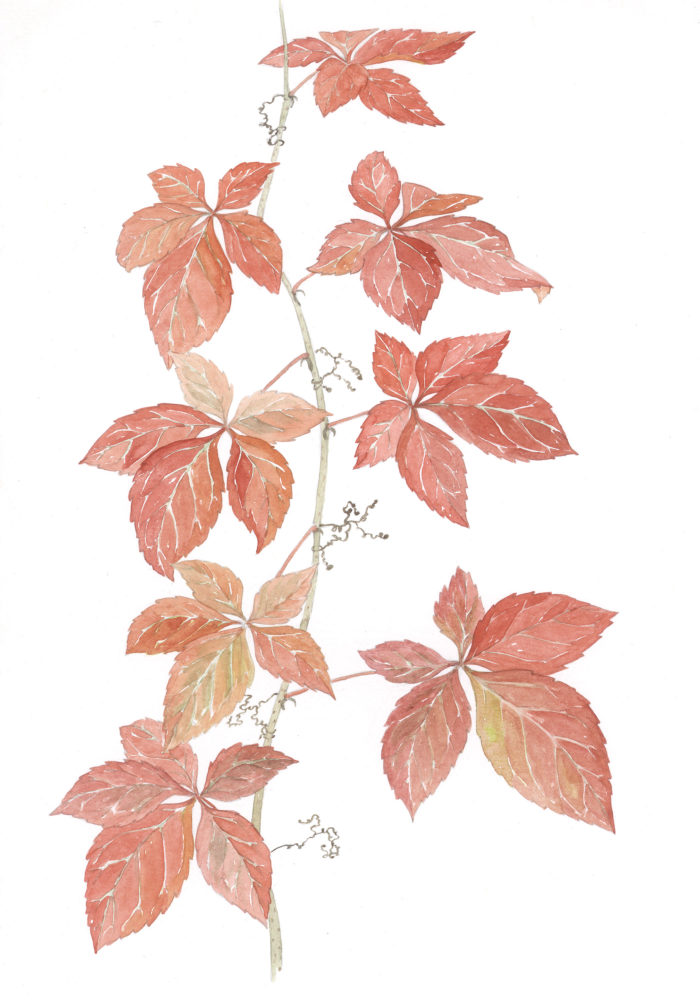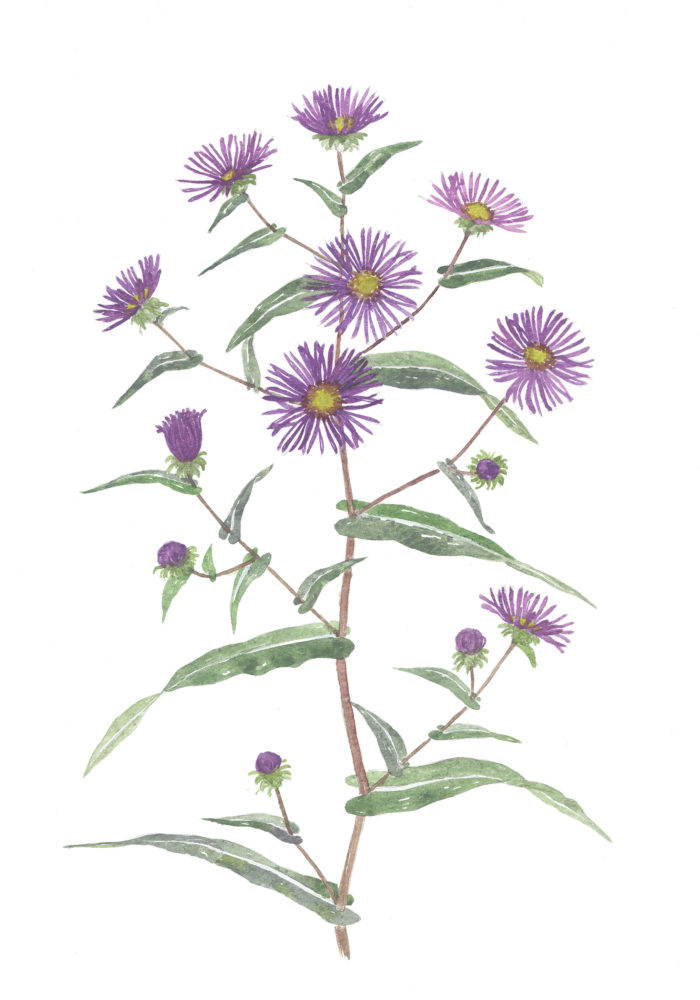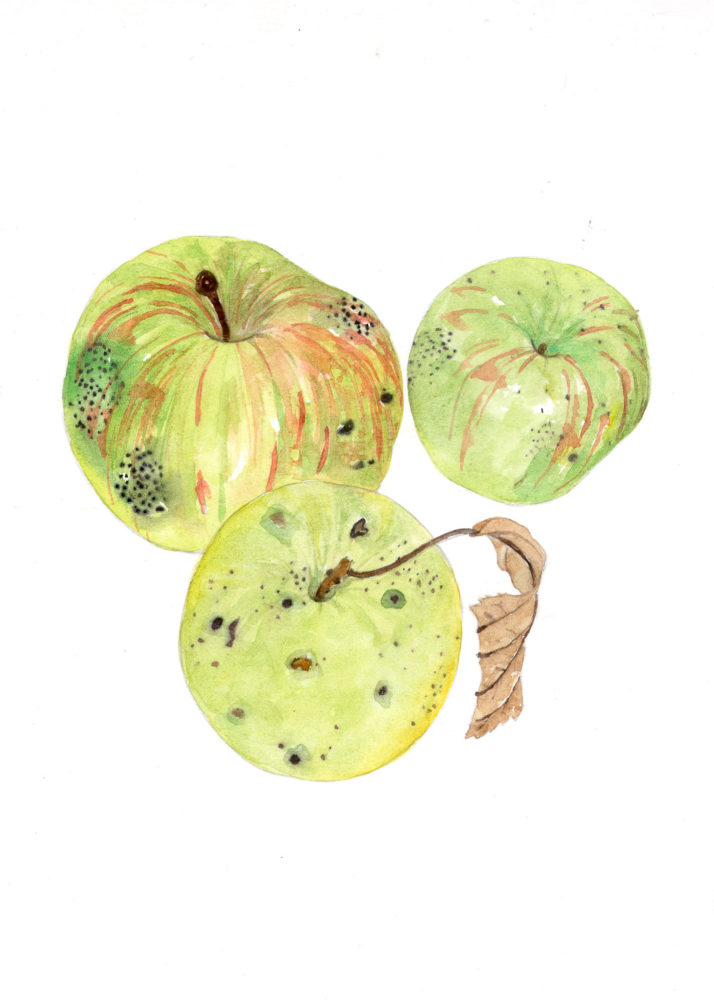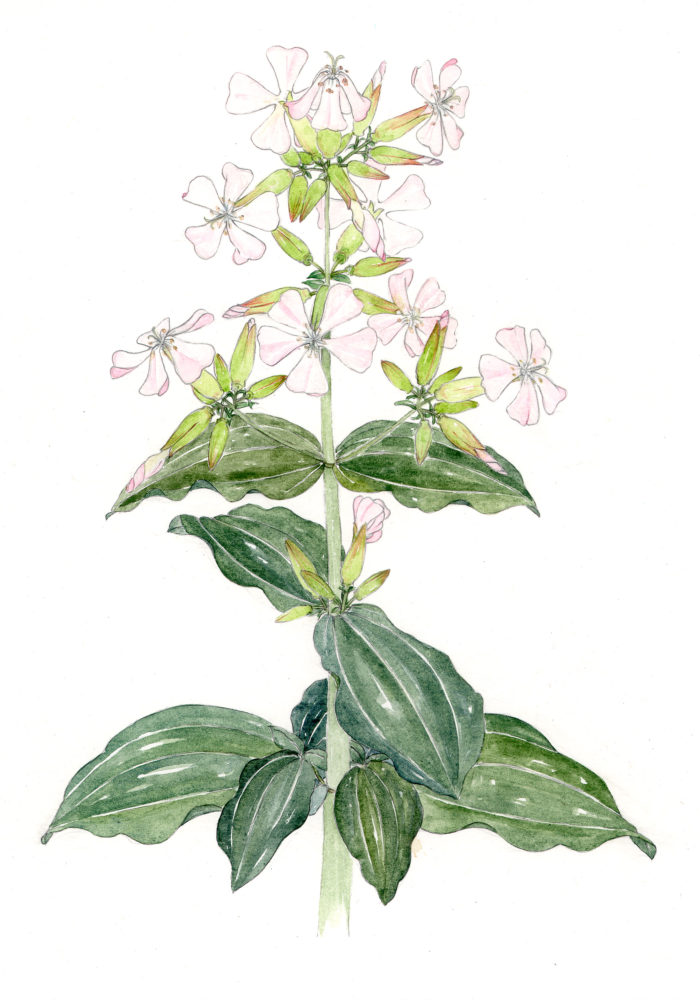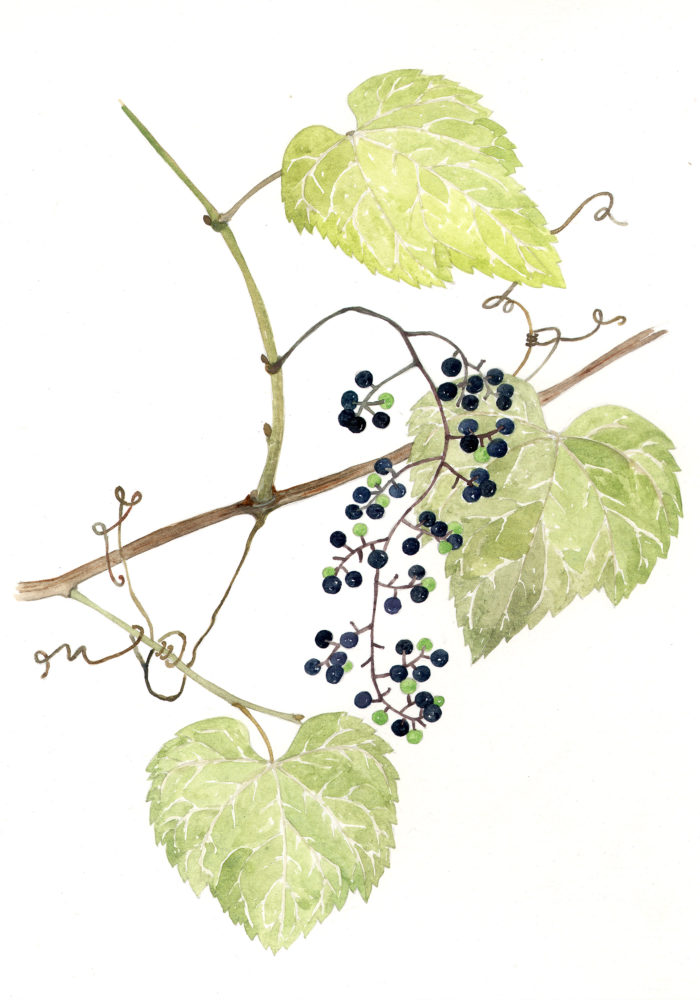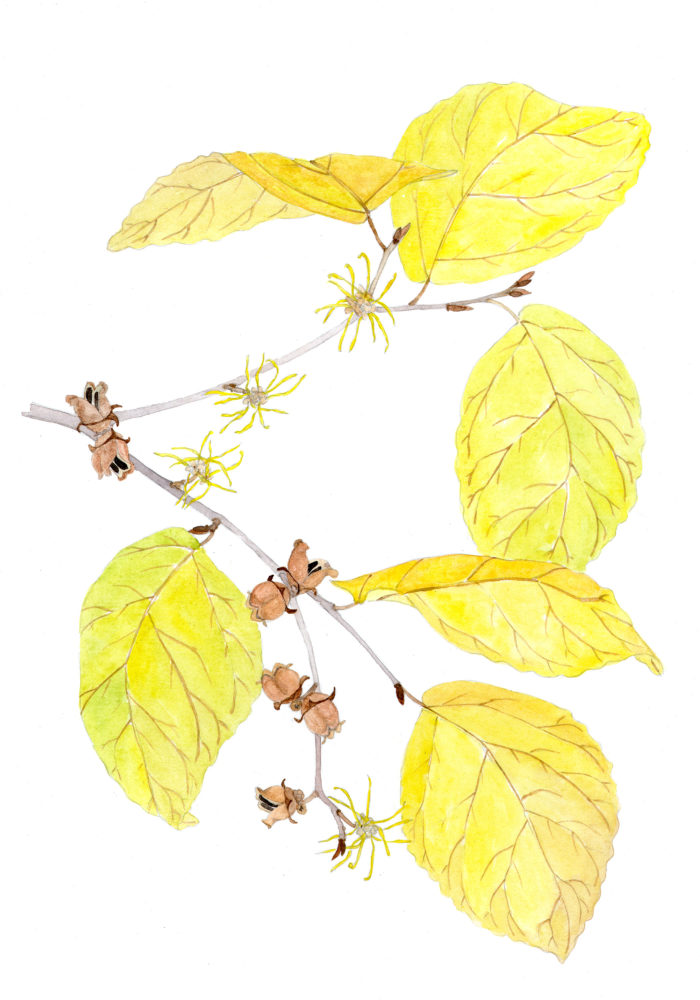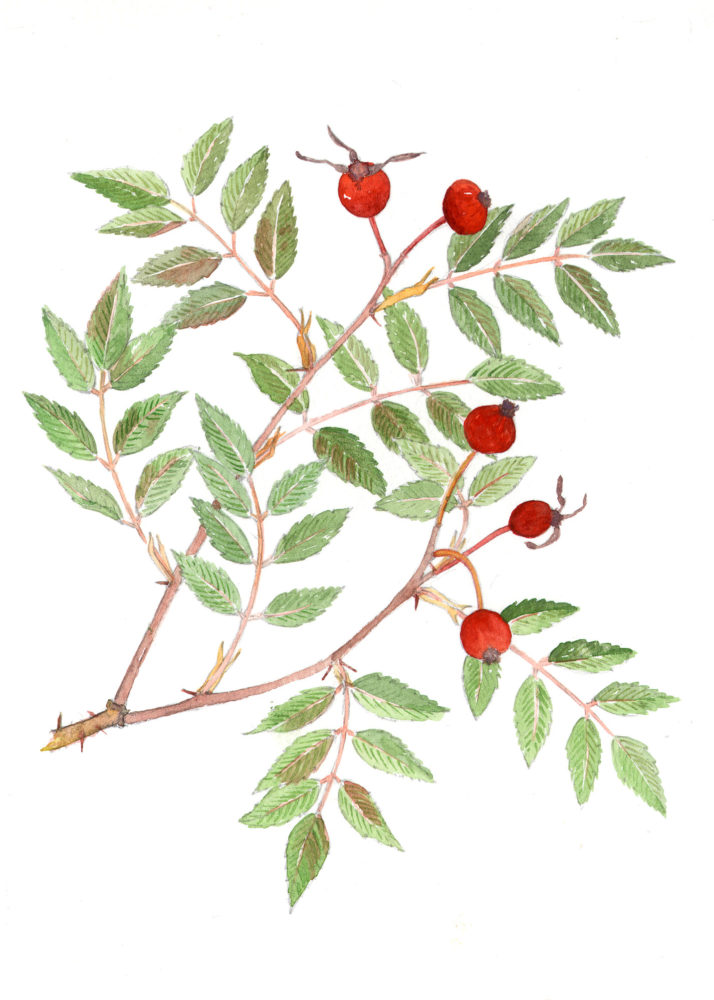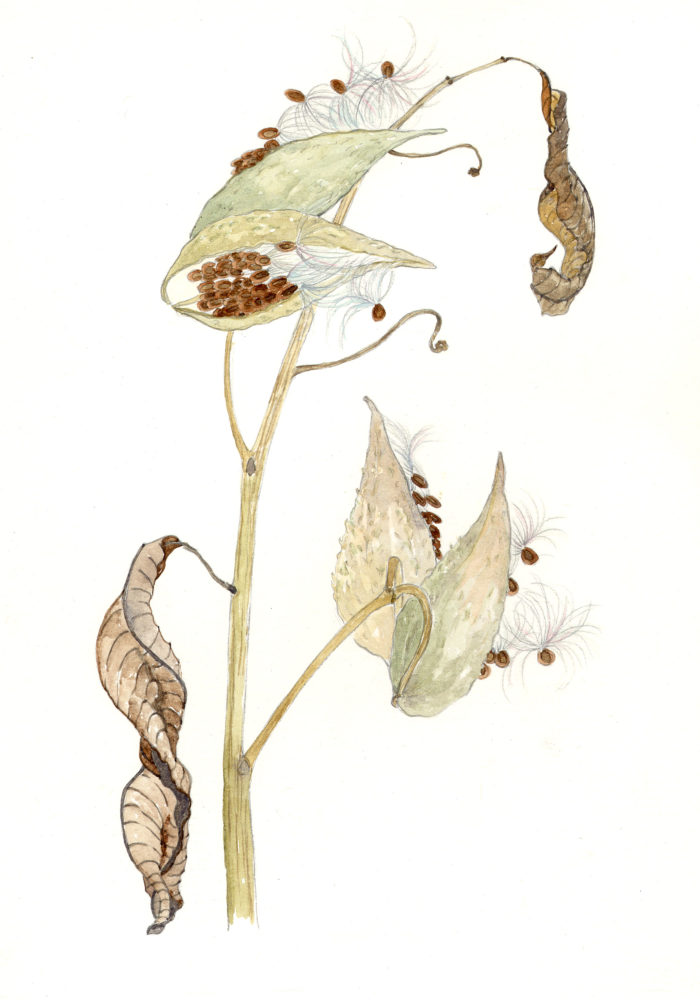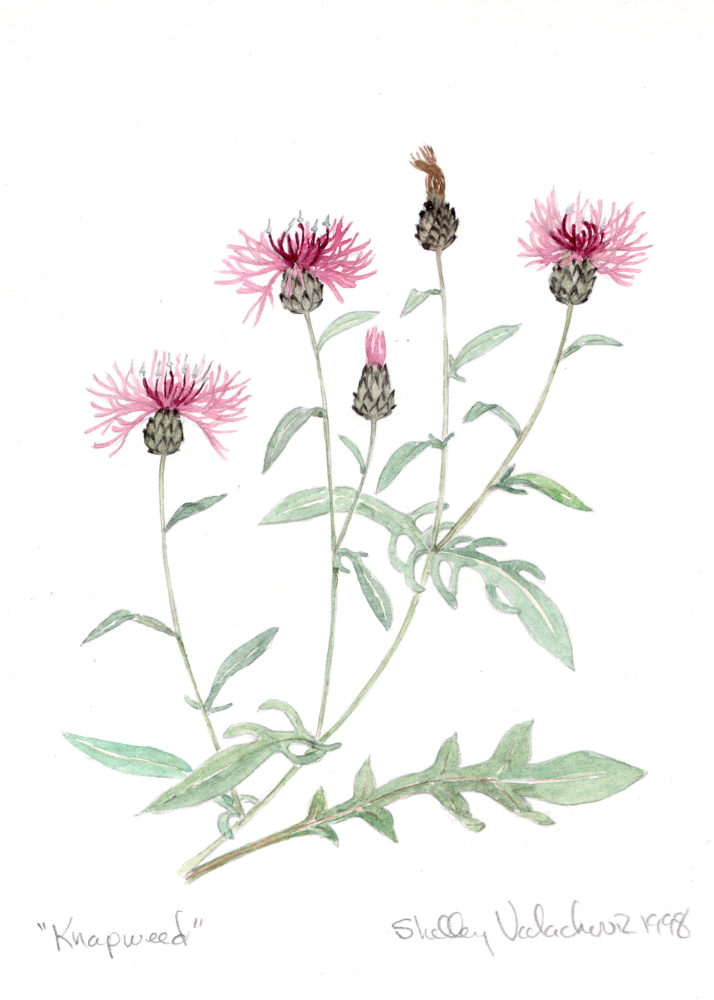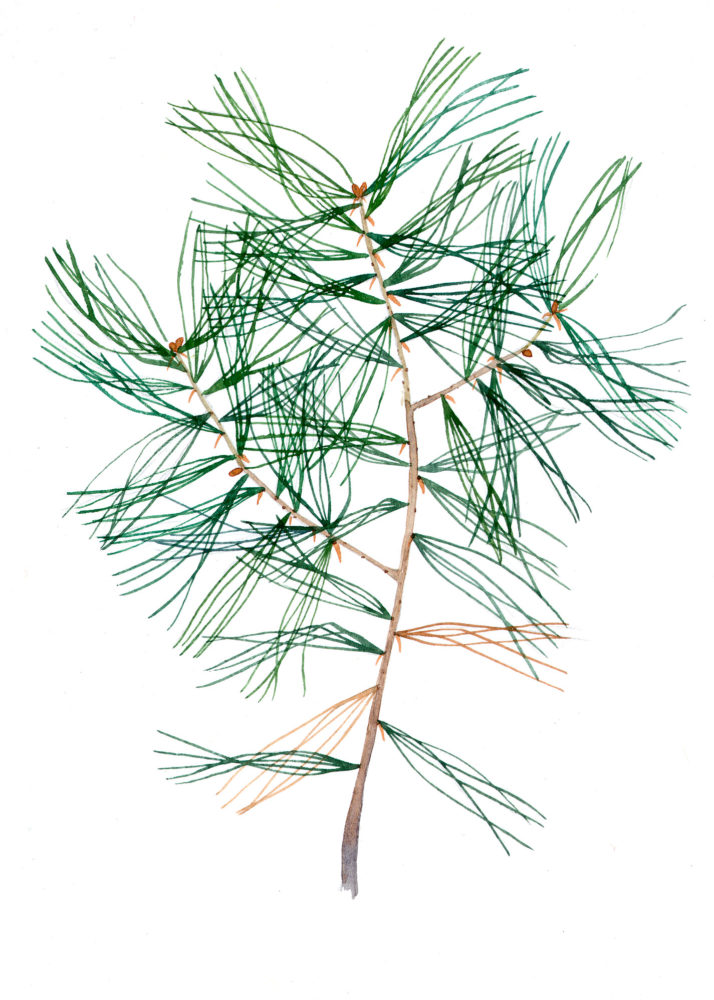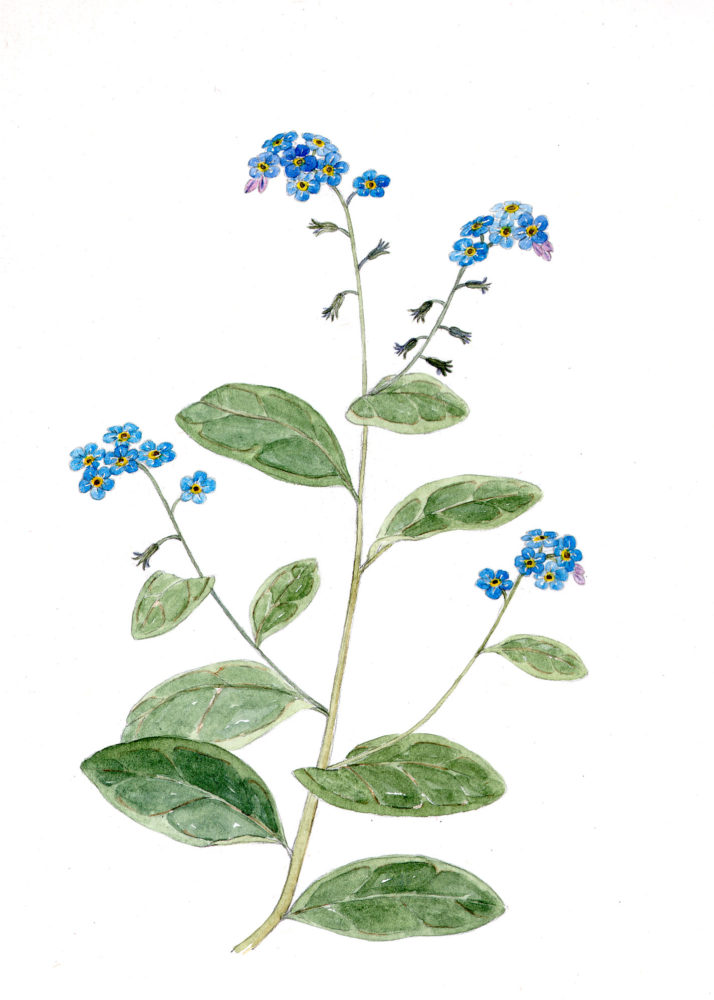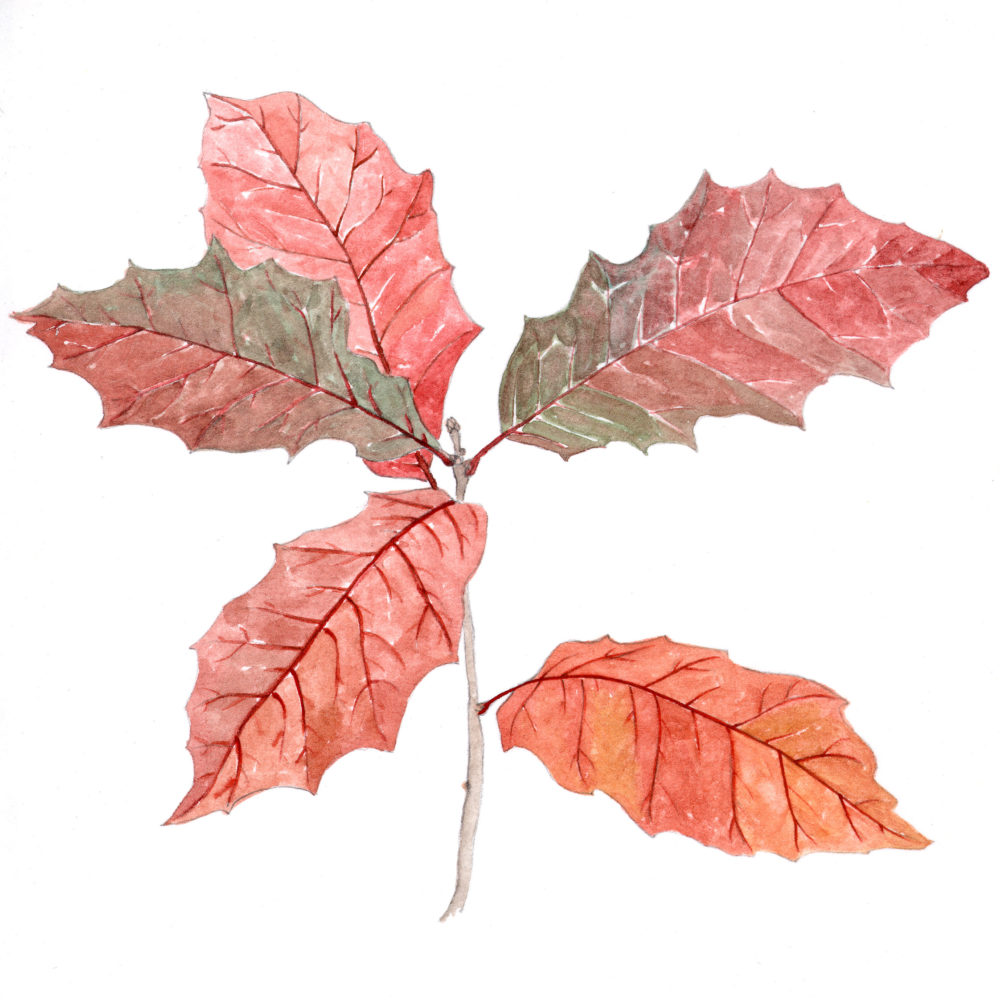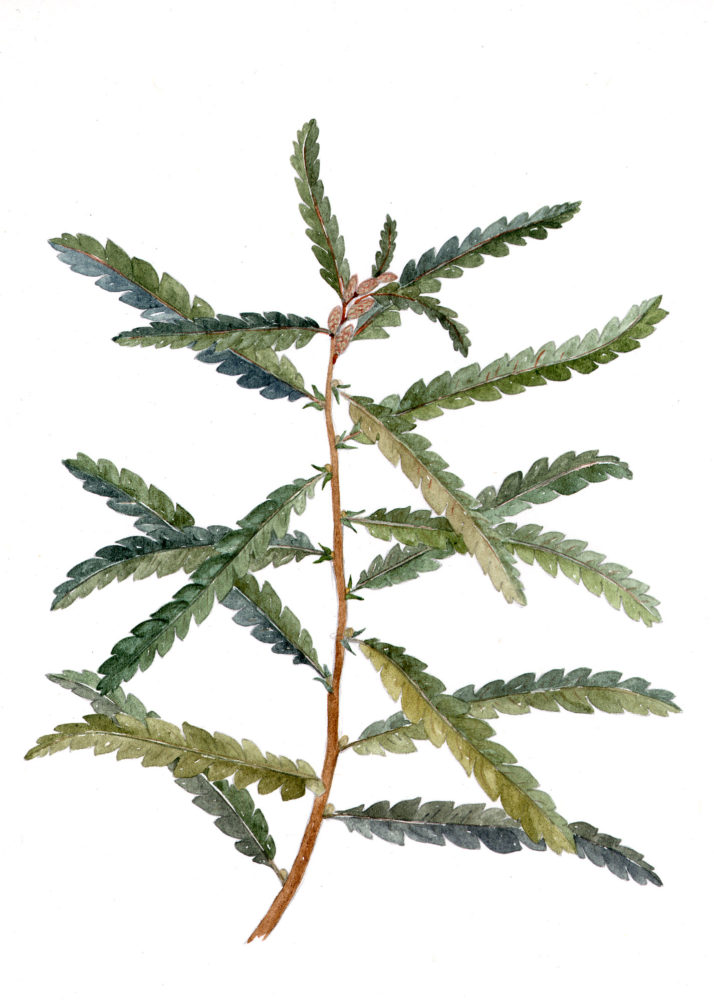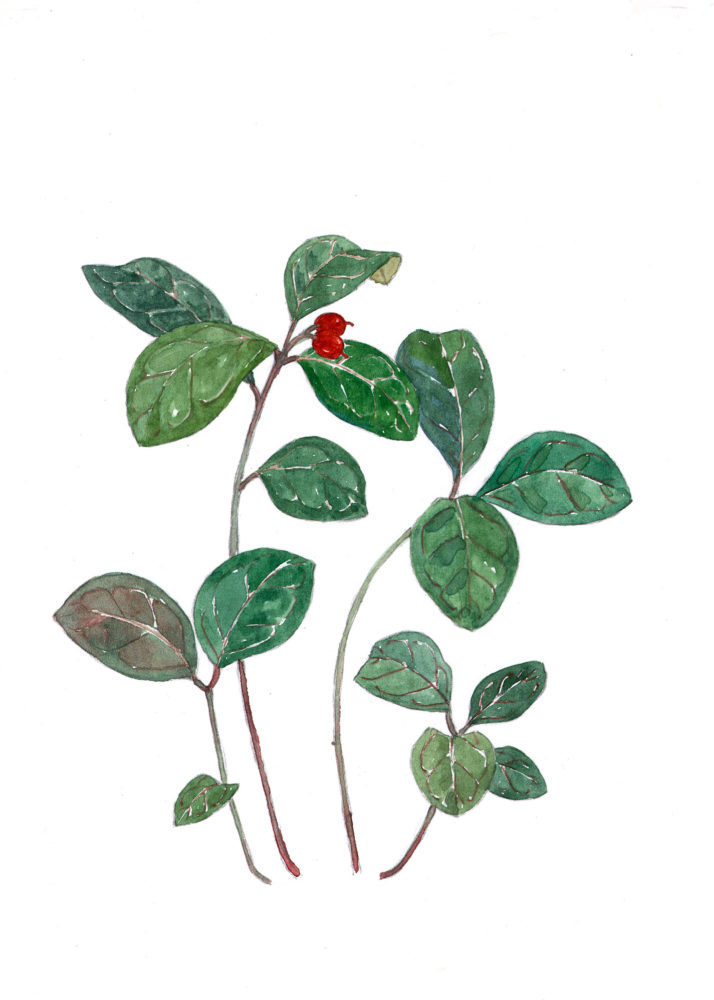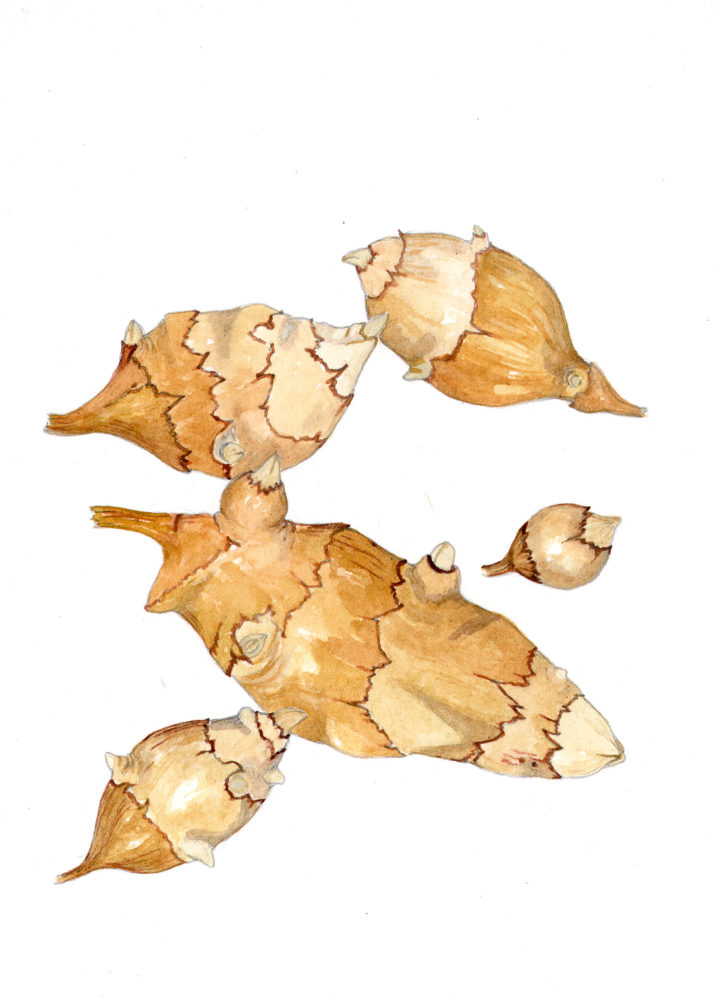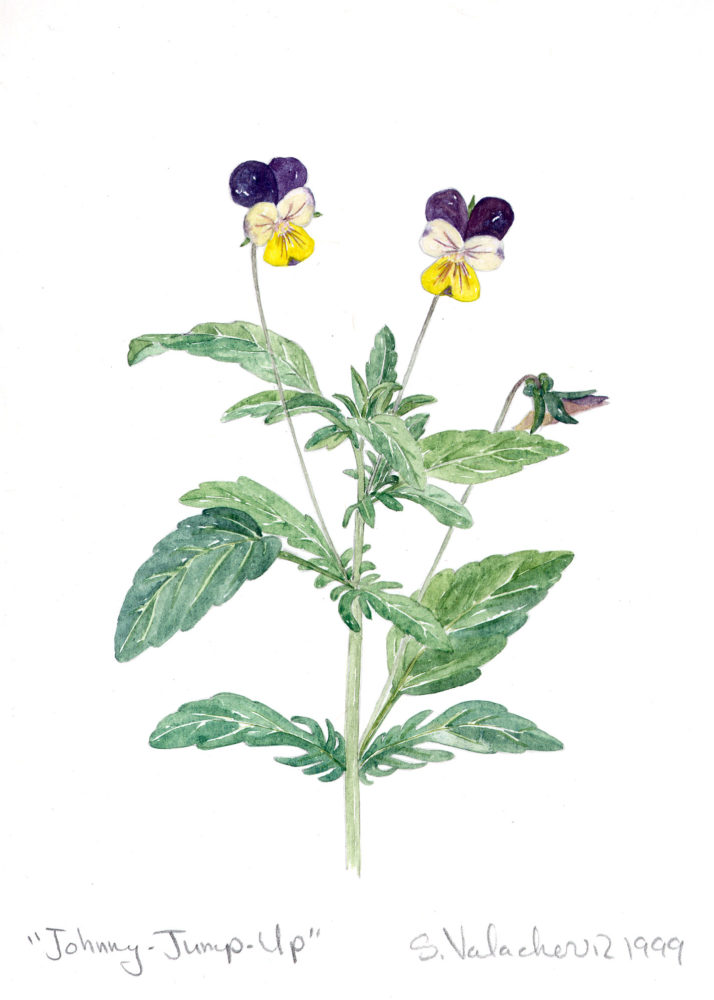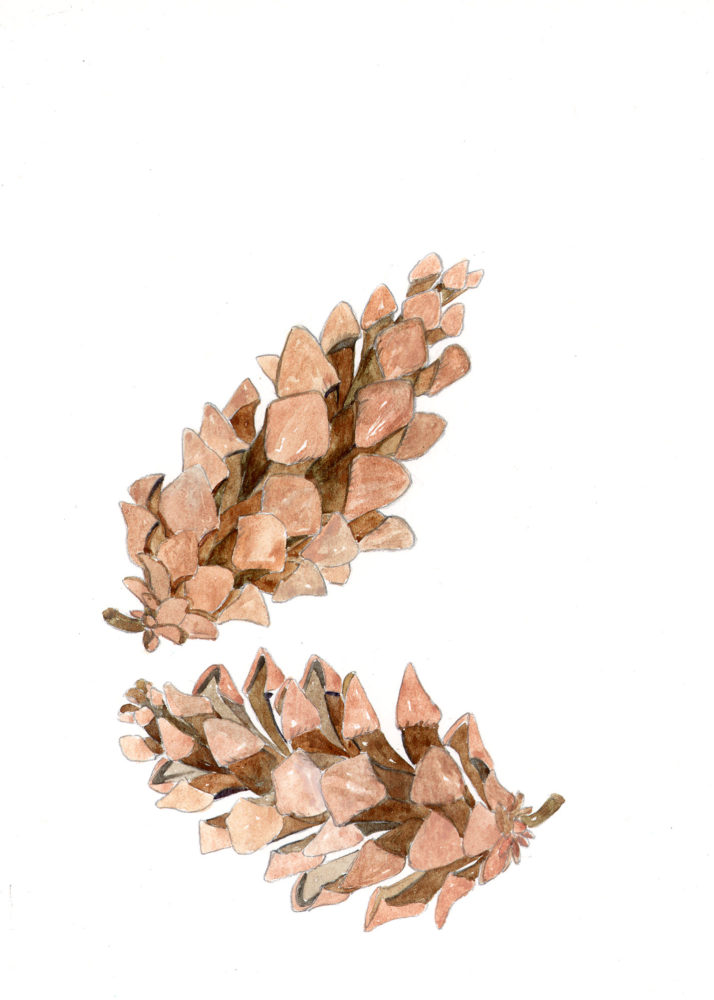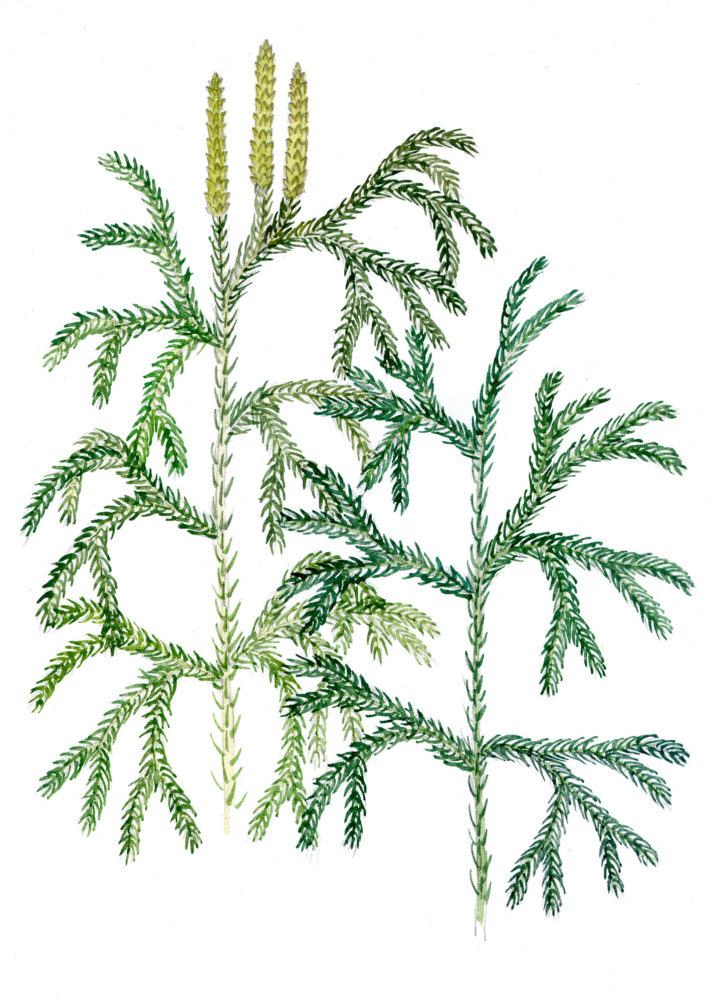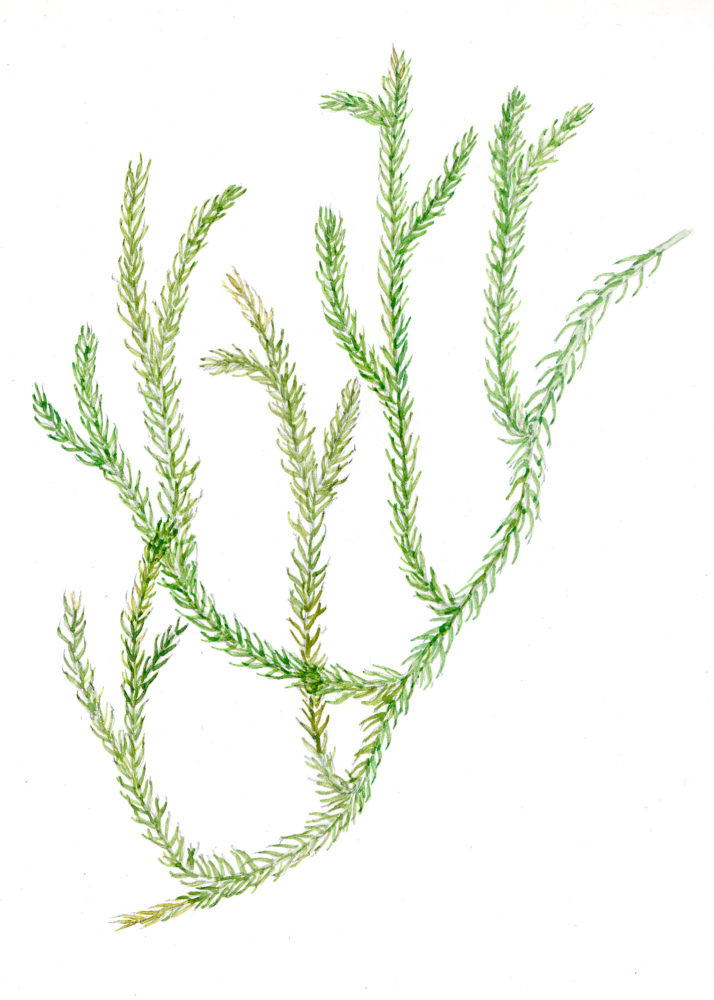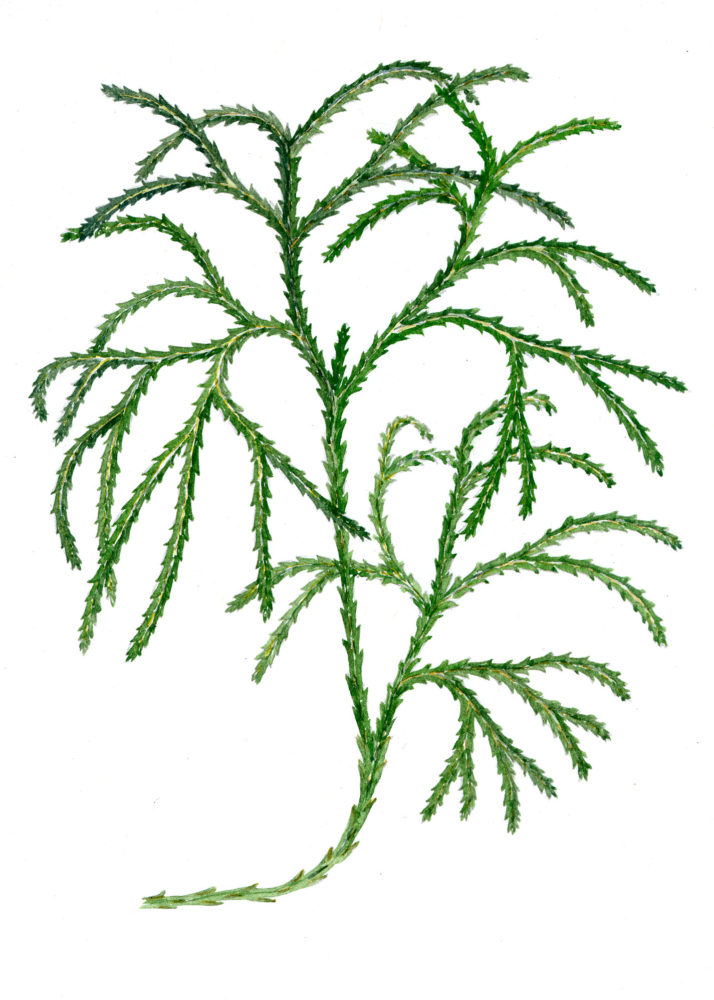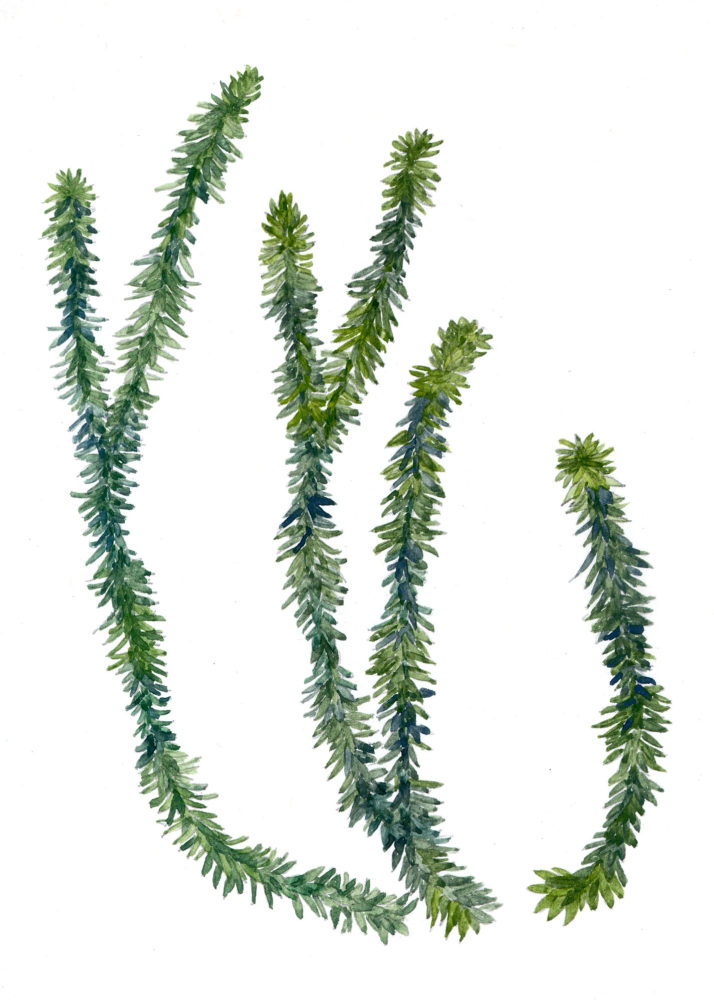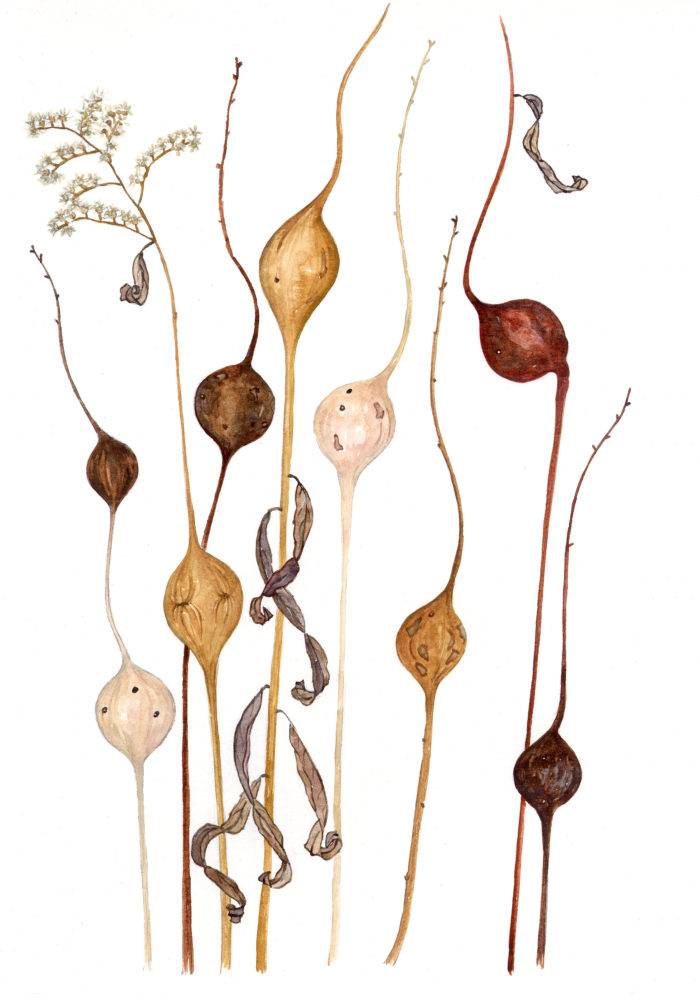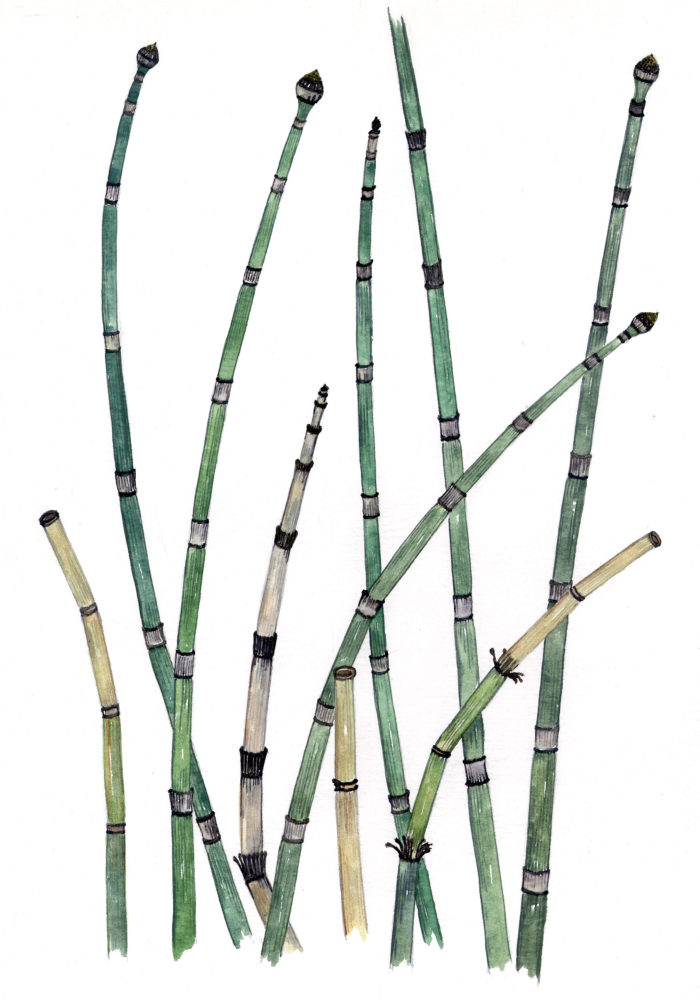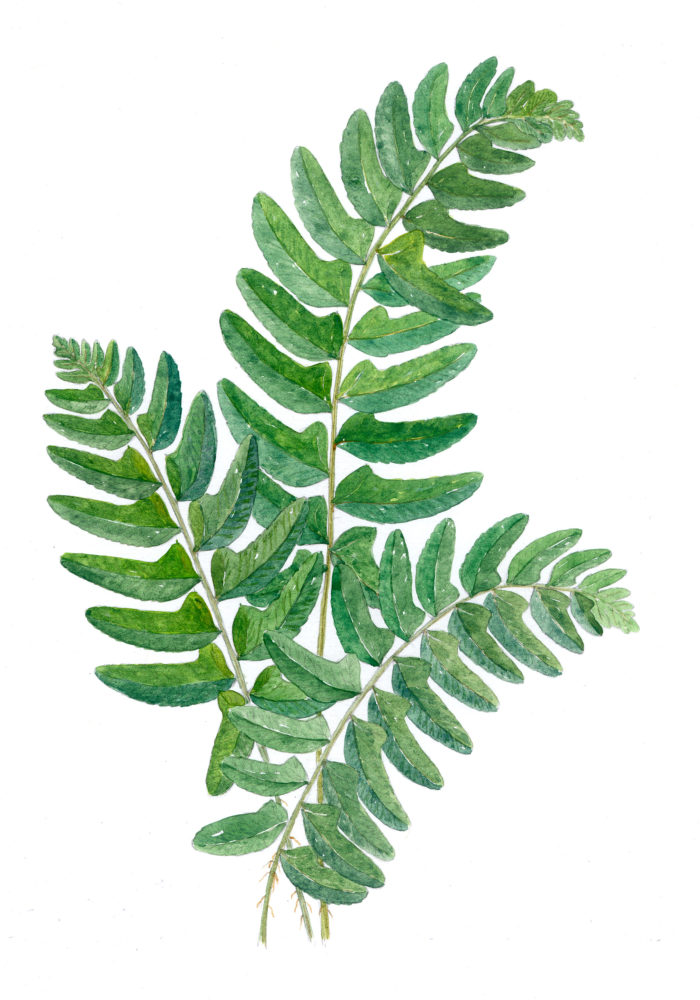A Year In The Woods- An Artist’s Journal
Illustrated and written by Shelley Valachovic © 2000
JANUARY
January 1st HEMLOCK
The new year started out blustery with gusty winds downing branches large and small, right and left, including the brittle, frozen tips of the hemlock branches. These tips of hemlock branches (Tsuga canadensis) bearing their miniature cones were scattered everywhere. Usually, because the cones are borne on the uppermost branches of these very tall trees, I don’t get a good look at them until the mature ones fall or get tossed down by the squirrels. I gathered up a handful of these petite boughs and brought them inside to draw as well as to brew a pot of hemlock tea. This is done easily enough by steeping the bright green needles (young fresh ones are best) or cut up twigs in a pot of boiling water as you would any tea. In addition to tasting good, it is rich in vitamins. Apparently chopped up white pine needles or arbor vitae will work as well.
This is not, by the way, the same hemlock as the infamous poison hemlock of Socrates’ day. That is an entirely different plant; an herb of the parsley family more easily mistaken for Queen Anne’s Lace than the tall forest conifer described here.
Although attractive and evergreen, hemlock boughs are rarely used for garlands or wreaths because the needles fall off in a very short time. This I found out by experience several years back after carefully constructing a twenty four foot garland to hang the length of our house inside above the windows. Within a week or two the needles were scattered all over the place. It was a good thing we had salvaged the old Electrolux that my grandmother was tossing out.
A guest once mentioned that he thought it rather incongruous that we should have a vacuum cleaner here in the woods, but we use it often. It is impossible not to track in all sorts of forest debris, especially in mud season. And of course with the woodstove there is always a mess of wood splinters and bark. Cleaning it up is considerably easier than trying to keep it out in the first place.
January 2nd TOAST
Last night (the first night of the new year) the mercury dipped to 20 degrees below zero again. Even though we now have a brand new car battery, or perhaps because we do, we took precautions to ensure that it does not freeze again. We ran an outdoor extension cord with a light bulb attached in one of those cage-like fixtures that mechanics use, and placed it under the hood of the car right up next to the battery. This is an old trick I learned as a teenager on overnight ski trips to Vermont with my family. It works.
We have to protect the house and ourselves as well, so on cold nights like this we generally find a good book and try to stay up as late as possible. The reasoning behind this is that once we go to sleep there’s nobody there to keep feeding the fire. We decided in addition to a good book, a bottle of our homemade dandelion wine, “Sunshine in a Bottle,” was in order. We toasted Baron William Thomson Kelvin and Gabriel Daniel Fahrenheit. We would have toasted Mr. Celsius too, but apparently there isn’t one. The 1943 edition of the Funk & Wagnalls that we use defines celsius as “the centigrade thermometer or scale; common but erroneous use.” The 1997 World Almanac begs to differ. They state on page 605 that “Although the term centigrade is still frequently used, the International Committee on Weights and Measures and the National Institute of Standards and Technology have recommended since 1948 that this scale be called Celsius.” In either case, no mention of a Mr. Celsius was made.
January 3rd STRANGE SNOW
Being wintertime, naturally the snow keeps falling down and piling up, but what fell out of the sky today was particularly strange. I’m familiar with snow (all kinds; wet, dry, light, heavy, slow or fast), sleet, and freezing rain, but this was none of the above. “Ice pellets” is what we finally called it. It accumulated to the depth of about two or three inches with the weight and texture of lose sand or sugar. Early in the morning we could brush or kick it around as you would sand on the beach, perhaps a little lighter, more like plastic bits of industrial waste. “I knew they would figure out a way to get rid of it someday,” was Pete’s rather stoic comment. By one o’clock it had melded into one solid mass. It was still well below freezing, so it didn’t melt, but rather fused somehow, like plastic. Sealed over with freezing rain later in the day, it remains.
January 4th PINE SEEDLINGS
How can I describe this? Today we “chunked” the driveway, “skinned” the car, and “chiseled” paths to the outhouse and woodpile. The snow, or whatever it is, is not so deep yet as to have buried the myriad little pine seedlings, and they are striking against their glazey bright white background.
The hemlock seedlings (not a true pine, but rather a conifer of the genus Tsuga) are the most prolific, this being primarily a hemlock forest after all. Next in order come the white pine seedlings (Pinus strobus).The one pictured here here has been weighted down and bent over by the recent snow. Feeling sorry for these helpless seedlings, I used to try and rescue them by pulling them out of the crust. This more often than not results in a lot of broken needles as well as a broken stem. It’s better to just wait until spring when they spring back on their own as the snow melts.
One lone pine tree can produce an incomprehensible number of offspring, and we have here in our woods several grandaddy sized specimens. White pine needles are long and thin (needle-like) and grow in bundles of five. All of the true pines (those of the genus Pinus) likewise have needles that grow in bundles. Pitch pine needles grow in bundles of three; red pines in bundles of two; and so forth.
In addition, there are several red spruce seedlings (Picea rubens) along the back path to the woodpile and I’ve often wondered how these got here. I haven’t noticed a mature red spruce in the immediate area, but then again there are a lot of woods here, some privately owned, that I have not trespassed. Red spruce is very common throughout the Adirondacks, however, so they were probably planted by the squirrels and chipmunks. Spruce needles are short and uniform; they grow singly along the stem in a spiral pattern like the bristles of a bottle brush. They are square in cross section and can be rolled like a wooden matchstick between your thumb and forefinger. This is a good way to distinguish a spruce tree from a fir tree, as balsam fir needles are also short, but they are flat.
January 5th STARVING ARTIST
We drove into town today to stock up on groceries. A thin coating of ice remained on all of the tree branches as well as on the dried weeds sticking out of the snowbanks. It was just enough to make them all shiny & shimmery like silver mylar, but not so much as to wreak havoc on the powerlines, roadways, and other manifestations of civilization. Needless to say, it was a very pretty drive.
At the grocery store I realized with a start that I was indeed getting my “fix” of plant life by looking at the produce. I was excited to find such mundane vegetables as fresh spinach, lettuce, and celery, and spent a rather inappropriate amount of time ogling the pears. There were five different varieties, each one more elegant looking than the next. I selected a couple of each kind. I thought I might try and draw them.
We also bought some chestnuts to roast “on an open fire”, and some fresh smelts which we will fry up crisp on that same outdoor fire. It’s not really practical to fry indoors as we can’t get the woodstove hot enough, or rather we can, but if we did so we would have to open all the windows and probably go out side anyway. A small house heats up fast; an advantage most of the time.
January 9th GERONIMO!
It began snowing hard late yesterday afternoon, and by morning there was over a foot of heavy, wet snow on the ground. The boughs of the larger pines were bent to the ground and the hemlocks were transformed into hunched over, somewhat sinister looking monsters. Forget the driveway, it’s time to shovel off the roof – and right now. This may sound like a chore, but it’s actually a really fun job. We donned our snowsuits. Mine is a black snowmobile suit with a big red scorpion (hey, my sign) on the back. I bought it at a thrift store for a quarter one hot summer day thinking, “you never know.” Pete’s is an orange flight suit a concerned friend had given us probably thinking, “they’re gonna freeze up there!”
The job itself takes the two of us about an hour to complete. I usually shovel or push the snow from the top, while Pete shovels or brushes it off from below. Covered with snow, the roof is by nature and design both slippery and steep, but I’ve only fallen off once. It’s not that high up, and you land in a snowbank anyway, so I really didn’t mind the fall. In fact as I remember it was kind of fun. Once I started started sliding, rather than fight it and end up with a twisted ankle or worse, I just went with it, yelling to Pete to “look out below.”
January 10th THE FROZEN CREEK
Roof and driveway all cleared, we took the time today to shovel the steps down to the creek because we needed to get water. The bank down to the creek is very steep at this point, so to facilitate our coming and going we built a stairway years ago. This is not your ordinary staircase, but rather a combination of well placed roots (courtesy mother nature) and a number of risers formed by two stakes pounded into the ground crossed by a log and backfilled with the dirt and duff from just above it. It doesn’t make it any less steep, but it does give us a foothold.
Once we got down to the creek we had to dig a hole in the ice with an axe to fill our buckets. Excited that the creek was finally frozen over, and with lots of fresh snow on top of it, we hauled the water back up to the house and got our skis. As the crow flies it’s only a quarter of a mile or so down to the Hudson River, but with all the twists and turns the creek takes, it’s appreciably longer. The Hudson itself was not frozen completely across, just along the sides. We skied along the bank for another mile or so, but since we had gotten off to a late start the sun was already beginning to set. We turned around and headed back. We saw deer and fox tracks and I wondered if these were made by the same fox as the one we saw up at our neighbors’, or perhaps there are more foxes? Coyotes, maybe.
January 13th SNOWED-IN
We stayed indoors by the fire today, and enjoyed the snowed-in effect. It was just plain too darn cold to be outside. We read books, baked bread, Pete made a big pot of chili, and I drew pears. Tonight it is forecast to go down to 20 degrees below zero, so again we hooked up the lightbulb under the car hood.
January 19th THE FROZEN PIPE
A problem has occurred. We drove to the spring two miles up the road from the laundromat today for drinking water and were surprised to find that it wasn’t running. Actually, the spring itself was running, but the pipe had become clogged and frozen, and was also buried in the snow. The pool where the water collects is too shallow to fill our jugs in, so after digging around and poking at things without success, we let this one go until springtime and headed out the Harristown Road to where there is another spring. The drive is at least five miles longer, but the scenery was well worth it, the trees all decked out in their lacy white winter attire. The pipe attached to this spring comes from under the ground where it can’t clog up with sticks or stones or leaf debris in the fall. The water trickles into a large concrete cistern and then overflows into the ditch. The snowplow had partially buried the cistern, but we were able to dig it out, bail out the water to a level low enough that we could get the jugs under the pipe and patiently fill them. This pipe is much smaller than the clogged pipe at the original spring, so the water runs extremely slowly, but it does run.
The whole adventure took an hour longer than we figured, and the whole time we were being watched (as well as barked at) by two St. Bernards who apparently thought the cistern was their private water bowl. They finally lost interest in us about two jugs shy of the finish and fell asleep on the snowbank. Just then a pick-up truck passed by and they woke up and started barking all over again. My guess is that they were having the time of their lives – what with so much to bark at on that sparsely traveled stretch of back road.
January 20th JANUARY THAW
The winter cold spell has snapped, and it looks like we’re about to get a January thaw. Although somewhat unpredictable in its length and timing, the January thaw happens every year without fail. We took advantage of the milder weather and cut back the huge snowbanks along the driveway, especially out by the road. It’s nice and sunny out there, so we took our time and did a really good job. We recut the steps down to the creek and took a couple of folding chairs and some books. When it’s sunny and 45 degrees in midwinter, you don’t waste time indoors.
The creek ice is beginning to melt, however. It rained last night, so between the rain and snow melt the water level rose and the creek water is now flowing freely both under the ice and in sections, over it. The ice is still fairly thick (eight inches or more) in most places and anchored to the creek bottom in huge “plates”. There are a few possibilities here. If the weather continues mild for a few more days and we get a big rainfall on top of it, the creek will most likely break-up prematurely and we’ll have to start all over from scratch. But if it doesn’t get too warm, the anchor ice should stay intact. With water flowing slowly over the top, it could freeze up flat and clear – perfect for ice-skating.
January 21st BLUE SPRUCE
The warm days and cold nights have turned whatever snow we have left (and it’s quite a lot, actually) into a solid crusty mass. This crust is fun to walk on. Much like wearing snowshoes I would guess, without the cumbersome trappings, and with the added adventure of occasionally breaking through the crust up to your knees.
After traipsing around a bit I settled down to sketch the blue spruce (Picea pungens) which we had planted several years ago. Blue spruce is not native to the Adirondacks, but it is a popular ornamental conifer, and seems to be comfortable enough here to reproduce. Like all spruces, it has short thick needles that are square in cross-section. The needles of this species are a distinctive blue-green color, giving the tree an overall bluish cast, from which it gets its name.
The specimen we have here was given to us as a seedling. It was back when we first moved here and we were at the local hardware/garden supply/ feed store getting some garden supplies. It was Arbor Day and the cashier was handing out these little seedlings to all the customers. I’ve noticed several other blue spruces in front of houses along the road into town that appear to be about the same age as our tree, and I like to imagine that they went to the same store on Arbor Day too.
January 24th ICE JAM
The past three days have continued unseasonably warm with rain on and off. Last night the rain came down heavy. The creek has been getting gradually louder. About noon today I noticed a distinct rise in the volume of the already rather loud roar, and so we went down to take a look. Sure enough, the anchor ice was beginning to break free. Once the anchor ice begins to give way the rather slow process of a complete ice break up is irreversible.
This is, for us, one of the most exciting events of the year. Forgetting everything else, we stayed there to watch as the large plates or chunks of ice broke free and headed downstream. These inevitably got caught up or “jammed” further on down. Meanwhile, slabs of ice the size of ping-pong tables which had broken free further upstream were now coming down to knock into the ice blocks here and jam up. For hours we remained glued to the spot as the creek bucked and roared, picking up momentum and rising steadily before our eyes. A pick-up truck stopped on the street and the driver yelled to us, “watch out, she’s broke up there!” nodding in the direction upstream from where he had come. No sooner said than done, we heard a near-deafening roar and heading downstream from around the bend was a three foot high, forty foot wide wall of water, all mixed up with chunks of ice, branches and other debris. We were safely up on the bank about twenty feet above the creek. (Actually I was half way down the steps trying to get a better view, but climbed quickly up the bank when I heard it coming.) There were not only branches, but whole trees afloat. And a bowling ball! I’m not making this up, Pete saw it too, as did the fellow in the pick-up. After about fifteen minutes or so the onslaught slowed and the water started to recede, leaving chunks of ice the size of small cars stranded along the far bank. So much for the skating rink.
January 26th HAIR
The level of the creek continues to go down some, and the weather continues to be warm. Today is sunny and 40 degrees so we dug the crusty, melting snow and ice out of the backyard fire ring, started a fire and put a big pot of water on to boil. It was time to wash my hair which, being fairly long, I keep in braids for the winter months. People often ask me, “but how do you wash your hair in the winter?” And so I’ll tell you.
Basically it’s the same process as in the summertime, but you need to be a little more selective about which day you choose to do it. A mild sunny day is best. Once the water is boiled, I fill a deep wash basin which I set on a stump or on a snowbank sculpted for that very purpose. I hang the towel on a nearby branch, and with my shampoo in hand, a cup for pouring, and a jug for rinsing, I wash it much the same as you would in a sink or at the beauty parlor. After it’s rinsed and towel dried, I usually go back indoors and start another fire in the woodstove. In the summer, we can wash and rinse our hair at the pump, and then of course stay outside to dry it in the sun. Usually, though, I prefer hot water in summer as well as in winter. Pete always washes his under the cold pump water right up until the middle or end of October when we have to dismantle it before the hard freeze. He’ll be out there in April too, as soon as the ground thaws. But for now he uses hot water also.
January 29th WINTER RESUMES
A few days ago the weather turned sharply colder, signalling the end of the thaw. The creek has slowly begun to freeze up all over again. Yesterday it snowed on and off all day long, light and fluffy with real snowflakes. By this morning it measured a little over four inches and was a pleasure to shovel. Round two of winter has begun.
FEBRUARY
February 1st BLUE MOON
We woke up this morning to moonlight (last night’s blue moon) flooding in the windows at 6 a.m. The sun came up shortly thereafter and although still cold, it held the promise of a perfect winter day. In the afternoon we went skiing, this time on a nature trail nearby. The trail itself was a bit rutty, so we skied out onto the adjacent lake instead. It was sunny and near 30 degrees, and in a matter of minutes we had worked up a sweat. Shedding earmuffs and jackets, we reached the far end of the lake where a small group of people were quietly ice-fishing. We skied back along the other side of the lake in and out of the shadows of the huge virgin white pines.
February 2nd GROUNDHOG DAY
Several years back I had read somewhere that as of Groundhog Day you should have a least half of your total wood supply left. At the time I thought this was a bit overestimated, the coldest months being behind us. But over the years, experience has taught me that this is right on the mark. And if you have considerably less than half left, you had better set out and find a dead tree, or call up the local woodcutter and get more. So today being Groundhog Day, we went out and took inventory of the woodpile. As it was, we seemed to be in pretty good shape, and it looked like we might even have some left over to start next year’s pile. We usually try to get started on that chore in March or April, right after the maple sap is all boiled down to syrup.
Actually, it’s best to cut a tree which you plan to use for firewood in the dead of winter when the sap is down. It not only seasons better, but it is easier to split. It’s difficult though, and dangerous, trying to get around a tree in the deep snow. If the snow isn’t too deep, however, we’ll try to cut down at least one tree before I tap the maples. That way Pete can stay busy splitting wood (which he prefers to do) while I boil the sap. With more mild temperatures and light rain again today, it looks like we’ll probably get the chance to do just that.
February 3rd CREEK, CREAK
The creek had hardly begun to refreeze, but with yesterday’s rain, it broke again. This time we heard it from the house. I hadn’t been expecting it, so by the time we raced down to the bank, the torrent was past. The ice was not so thick this time, so the effect was nowhere near as dramatic. Also, seeing it after the fact is kind of a let down. Much like getting to a parade after it’s already started. The anticipation is half the fun.
February 6th A RACKET
The entire week has been picture perfect and mild to boot. I myself would prefer a bit more snow to ski on, but I’m not complaining. The birds, blue jays especially, and squirrels have been having a heyday. On mild days like these, they seem to materialize out of nowhere. The blue jays have been attacking the compost pile, attracted to the eggshells and orange peels and the one persistent maraschino cherry that I had pulled off a fruit cake.
As it turns out, most animals in the Adirondacks don’t actually hibernate. Instead they just hole up in varying degrees of semi-activity. Their metabolisms are reduced so that they need less food and can conserve energy. The set-up is different for each individual species. The chipmunks, who store more than enough food to get through the winter in their underground homes, come out on nice days just to have a look around. Mice and moles tunnel in the snow when they can’t get through the frozen ground. Squirrels are probably the most active of all, except in the most severe weather.
Squirrels breed both in the spring and in the fall, so there were lots of little ones from last fall’s brood out there today, as well as plenty of moms and dads. The trees are so thick here that they can run from the branch of one tree to the branch of another and never have to come down. They could probably make it all the way into town and back (if they had reason to go there) at about thirty feet above ground. The squirrels and jays together make quite a racket.
February 7th CAT-TAILS
The sunny mild days have allowed the snow to crust up once again inviting a walk in the winter woods. I hiked out through the back to where some cat-tails (Typha spp.) have recently established themselves in what in summer is a rather swampy area.
Cat-tails are so common and well known that they hardly need a description. There are two species in our area, common (T. latifolia) and narrow-leaved (T. angustifolia), the difference being in the width of the leaves. While both have long, slender, ribbon-like leaves, the common cat-tail has leaves up to an inch wide, while the narrow-leaved variety has leaves up to only a half inch wide. There are also differences in their flower structures, but these are slight.
Both species grow to a height of six feet or more and are easily recognized by their cigar shaped flower spikes. This spike bears a combination of male (staminate) and female (pistillate) flowers, the male flowers on top, pollinating the female flowers just beneath them. It is this pollinated female flower cluster that becomes the “cigar” made up of tiny densely packed rust colored fruits, each attached to the stem by a finely haired stalk. When these fruits mature, the spike explodes, releasing the seeds to be borne away on the wind.
February 10th THIN ICE
I’ve been checking out the creek every day hoping that it will freeze up again, but it doesn’t look promising. A thin layer of surface ice has collected around each one of the many rocks sticking out of the water and it looks like a bunch of fried eggs floating down to New York. I guess we’ll have to find a rink to skate on elsewhere.
There are a plenty of lakes around here, and sometimes communities will plow or otherwise maintain them for skating, especially on their winter carnival weekends. But thin ice poses a threat that in these days of creative justice most communities or towns simply can’t chance. We eventually found a rink high up on a hill, above the recycling center, overlooking Lake George. Being a weekday, we had it all to ourselves. I could have skated for hours, but Pete doesn’t share my enthusiasm for skating. “Next time,” he said, “I’ll bring a book.”
February 11th STAGHORN SUMAC
Contrasting against the background of a clear blue sky and stark white snow, the fuzzy red fruits of the sumac trees are hard to ignore. Sumac is a small tree or shrub that grows along roadsides and waste places. The dark red fruit clusters remain on the plant all winter long. There are three common species; staghorn, smooth and poison. Staghorn sumac(Rhus typhina) has clusters of tightly packed rich dark red fuzzy berries or fruits. The stems are also covered with a thin downy fuzz, like that on deer antlers, giving it its common name. Smooth sumac (R. glabra) has red fruit clusters more loosely packed, and lacks the downy fuzz on the branches as well. Poison sumac (R. vernix) has white berries, so it can hardly be confused with the staghorn or smooth species.
And this is a good thing, because the staghorn sumac, in addition to being pretty in the winter, makes a superb tea in the fall. You could feasibly make this tea in winter, but it would be neither as tasty nor as nutritious owing to the fact that it’s the ascorbic acid (vitamin C) content that gives it the tart and refreshing flavor. The vitamin C, being water soluble, would have no doubt been washed away by the rain and snow by now. Pick these clusters in August or September when they are fresh and brew it as you would sun tea for a refreshing iced sumacade. Three or four fruit clusters mashed or bruised slightly in a quart of water is sufficient. Be sure to strain it well, as there will probably be at least a few bugs in it.
Sumacs are more readily propagated by root runners than by seed, and so you will often find them growing in clusters. The center trees being older and therefore larger are surrounded by shorter trees, in turn surrounded by still shorter trees and so on. This creates a very graceful mound, especially when viewed from a distance. The individual trees themselves are graceful as well in their pattern of branching, but because it grows so fast, the wood is soft and useless, and more often than not it is regarded as a weed or nuisance.
February 17th WEAVING
As in Virgil’s day, when “chilly showers ‘ere shut the farmers’ door . . . the ploughman battered keen the blunted share’s hard teeth,” likewise Pete cleans and sharpens his tools, axes and chainsaw. “His wife the while, her tedious labor soothing with a song, speeds the shrill comb along the warp.” This is indeed the time of year I bring my loom indoors and weave. The soothing song will most likely be a new one of Pete’s that he’s been busy writing and recording.
The loom I use is a Navajo styled frame loom made from four straight branches of the hemlock tree. It measures three and a half by five feet, and when warped will produce a rug that is two feet by three feet, perfect for in front of the hearth, the bed, the kitchen sink (if you have one), or as an indoor mat or bathmat. I warp the loom with a good sturdy cotton postal string; 300 feet will do the job. It takes a couple of broomsticks, two yardsticks and an hour or so to set up the warp and shed. It will take two or three days working a couple of hours in the morning and a couple more in the evening to complete each rug.
The harder part is perhaps preparing the strips of cloth that I use in weaving these recycled rag rugs. I use old clothes, tablecloths, sheets or towels that I get from my sister, brother, friends and neighbors. My brother has two teenage sons, he himself builds houses. Wife and daughter included, this family goes through blue jeans like no other. Twice a year he gives me a large garbage bag full of worn out jeans, ripped and torn, but otherwise clean. After cutting off the waist bands, zippers, and pockets, and splitting the seams, I cut or tear the resulting leg panels into inch wide strips. I can get about two dozen strips from each pair of pants. To this I add some strips from colorful T-shirts or fancy floral prints from a skirt or blouse from my sister. You could say it’s like weaving straw into gold, but unlike the forlorn princess in the Rumpelstiltskin tale I don’t have to give away my firstborn. I can give away the rugs though, and usually do, mostly to the friends and neighbors who supplied me with the fabrics in the first place.
Although this is a job I can do anytime of the year, I usually try to do it in the winter, when other activities are limited. It’s nice to sit in front of the woodstove and calmly weave away the winter hours. It’s an ongoing task and takes a sizeable chunk out of our living space, but when not actually weaving, I can set the loom upright against the wall and out of the way.
February 19th RAGS
This morning I finished my first rug and rewarped the loom to begin another. But first we needed to do laundry and go to the spring for more drinking water. The pipe in the original spring has since thawed, unclogged and is now running freely and fast. We filled up our jugs in no time and returned to fold the laundry. I noticed a few of our own ragged T-shirts and jeans that would probably serve far better in a rug and so I set them aside to weave into the very rug I had started this morning.
February 22nd VENUS & JUPITER
I have fallen into a pattern as rhythmic and as simple as the weaving task I have taken in hand. Each day has been cold but sunny, so I weave rugs all morning. After lunch we go down to the creek to bask in the sun along the near bank for an hour or two. It’s barely 20 degrees, but with the sun shining it feels warm and good on my face. I need to stretch out my limbs and relax my back from the hunched posture the weaving requires. Refreshed, we go back indoors. Pete rekindles the fire, and I take up where I left off.
At just about sundown, I noticed two really bright stars on the western horizon. Not just bright, but big too. They are probably planets. I must admit that for all the time we spend outdoors, I know very little about the stars, let alone planets. There’s a reason for this, and it’s a very simple one. We live in the woods; we can’t see the sky. But in winter it is somewhat easier, not only are the stars brighter, but the leaves are gone. The creek affords a good view of the southeastern sky, while the logging road off to the west gives us a glimpse of the western heavens.
I heard a report on the radio later that same evening confirming that these two stars were indeed planets; Venus and Jupiter. They are as close as they will ever be until they align again in the year 2008, if I remember the report correctly.
February 25th PETE’S MORNING
Pete always gets up about an hour before me. He’ll get the fire going in the woodstove if it’s winter, or outside in the fireplace if it’s summer. Then he’ll boil the coffee water and pour it through the drip pot to brew. After his first cup, he’ll bring me up a cup, or ask if I want one. Only after that, do I get up and come on downstairs. It’s not that I’m a lazy bones and need my coffee served in bed; on the contrary I’d be glad to get up and help with the morning. But what happens is that we get in each other’s way. I’ve often heard Pete humming, scratching notes down in his notebook, chuckling to himself, or sometimes laughing out loud in this early hour. As a songwriter, this seems to be one of his most productive hours, so I have learned to stay out of the way and have my coffee brought to me in bed.
This morning Pete got up at five after six. After getting the fire started and putting the coffee water on, he began to wonder why the coals had still been burning, looked at the clock again: five after seven? And why wasn’t the sun coming up? He looked at the clock a third time: five after eight? No schoolbus? Realizing he had read the clock wrong, and that it was only half past one, he put out the lights and came back to bed.
February 26th BITTERSWEET
With a few inches of fresh snow on top of the frozen crust we figured the conditions would be good enough to go cross country skiing. I chose a spot a bit to the north of here that I had seen on a map. It followed along an abandoned railroad track bordering on the Boreas and Hudson Rivers. The trail itself was lined on the south side with tall, perfectly formed spruce and fir trees. The hillside off to the north was a hardwood forest, and down along the riverbank was a tangle of vines and brambles. I found some bittersweet (Celastrus spp.) there and cut a few short sprigs to take home.
Bittersweet is a long, climbing, twining vine common in the Northeast. There are two species in our area; American (C. scandens) and Oriental (C. orbicultus). The differences are slight and concern the placement and color of the fruit. In the American bittersweet, a native species, the tiny fruits are borne only at the tips of the twigs, whereas in the imported Oriental species, they grow along the length of the stems in small clusters. The fruit pods of the American species are bright orange, while those on the Oriental vine tend to be more yellow. Both grow wild and hybridize readily making identification even more difficult .
In summertime the inconspicuous flowers are greenish and hang in short drooping clusters. The leaves are plain and ordinary, growing alternately along the greenish-brown stems. Twining around its host, the entire plant is virtually invisible until the fruits ripen in late summer. Then it’s a whole ‘nother story.
Often referred to as berries, the fruit of the bittersweet is actually a small round pod. And like a pea or bean pod, it is filled with seeds. The seeds are covered by pulpy red arils. An aril is an accessory outgrowth or appendage of a seed which can be highly variable in shape, but is usually brightly colored. Not all seeds have arils, in fact most don’t. The aril surrounding the nutmeg kernel is the classic example, the spice mace being derived from it. Arils contain chemicals which attract insects (mainly ants) that help in seed dispersal. The ant typically carries the seed to its nest, eats the aril, then leaves the seed unharmed to germinate where it lay. A number of woodland plants depend on arils for seed distribution. Trillium and bloodroot are two that come to mind.
But getting back to the bittersweet, the sprigs of which are now attractively arranged in a basket on my window sill, it is not only the color, but the persistent nature of the fruit that makes this vine so popular. When ripe, the pretty orange pods split open in thirds revealing the juicy red cluster of seeds within. Divided into six equal sections, it resembles a peeled orange or grapefruit. The split pod gradually darkens with age, but remains intact. Thus, the red/orange color combination is striking throughout the autumn, winter, and even into the following spring. I will plant the seeds in my own garden when the ground thaws.
MARCH
March 1st SNOWMEN
The last few days of February were warming up nicely and hinted of spring. Today, however, we woke up to four inches of heavy wet snow. This was good snowman building snow, so instead of shoveling the driveway, I made a snowman by rolling balls up and down the driveway. Pete quickly joined in the fun, and we were able to make not only one, but two snowmen. I used bottle caps and rose hips for the buttons and eyes, and branches for the arms. Pete extricated last year’s robin’s nest from the grape arbor and added it for a hat. The other fellow received an upside down flower pot on his head.
March 3rd BAKING BREAD
Typical March weather continues; damp, chilly, gray and blustery. This would be a good day to stay indoors and finish up the last of the rugs I had started weaving last month. It is also a good day to make bread.
The bread we make is a sourdough bread from starter. Sourdough starters can be bought or made, cookbooks often have recipes for this, but the best way to get your starter is from a friend. Ours was given to us by a friend who in turn got it from a friend to whom it was handed down from her great grandmother in Tennessee. She claims it was one hundred and fifty years old when we got it five years ago, and it is still going strong.
Having bread starter is a little bit like having a pet. You need to “feed” it on a regular basis, store it properly, and protect it from freezing. Different starters require different food. Ours likes to be fed a cup of flour, a tablespoon of sugar and a cup of warm potato water once a week. We generally take our starter along when we go on long trips. Our starter has been to Texas, Atlanta, New Orleans, Cape Cod, and even back to Tennessee. It has participated in many parties, pot-luck suppers and picnics, being the star attraction of at least one Thanksgiving dinner.
March 5th ANXIOUSLY AWAITING SPRING
All around us, cities in the northeast are getting huge amounts of snow while we have only gotten flurries or an inch or two at best. I am, on the one hand, anxious and ready for spring but experience tells me that our turn for a two foot snowfall is coming up. Nonetheless, I put away my loom in anticipation of my next project; tapping the maple trees and making syrup. This is traditionally done in mid-March, but depending on the weather, can be started as early as late February, or can linger on into mid-April. The signal to begin is the combination of clear warm days and cold crisp nights. In essence, spring.
March 6th OUR TURN
Apparently just thinking “spring” has conjured up the storm clouds, and right on cue the snow has begun. Once again the yard is filled with dozens of those fat little juncos. It’s as if they were trying to eat enough to last out the storm, and it seems to me, the more active the juncos, the heavier the snowfall. Many people refer to the juncos as “snowbirds” because of their habit of flitting about during a storm, whereas most other birds and squirrels take shelter. In fact, I have never seen the juncos out and about on nice days. And they seem to disappear completely come springtime.
March 8th WINTER LEAVES
We ended up with eighteen inches of snow, and the nightime temperatures have gone back down to 5 degrees below zero. Winter is not over yet.
This morning, however, is sunny and beautiful, so I tried skiing a bit around the woods in the new snow. It was very deep and tough going at first, but eventually I was able to make a track. Later, around noon, we dug out the garden bench, which is situated at the northern most corner of the garden facing south. We had our lunch out there, and then I sketched some of the beech tree saplings.
The beech tree (Fagus grandifolia) is a very common hardwood in this area. It is a tall forest tree with distinctively smooth, pale-grey bark, the one that young lovers most commonly carve their initials upon. The initials may persist for several decades, in some cases, long after the love has waned. Rebecca Rupp, in her book Red Oaks and Black Birches, notes that the custom dates back to Roman times, attested to by the surviving Latin proverb “Crescent illae; crescetis amores,” meaning “As these letters grow, so may our love.”
Beech wood is an excellent fuel, and the fruits, or beechnuts, are an important food for wildlife. They are tasty and nutritious enough for us to eat too, but because they grow so high above the ground, we must wait until they fall off the trees and try to beat the squirrels to the booty. The squirrels are a lot better at this than me, and I rarely find more than a handful or two, usually in late October after a frost.
On the younger trees, the leaves remain intact all winter long, making this tree stand out in the crowd. This is due to a chemical called auxin present in the abscission layer at the base of each leaf’s stem where it is attached to the tree. In most species the auxin levels drop after the chlorophyll has broken down and the leaf no longer functions as a food supplier. This in turn weakens the abscission layer and the leaf blows away in the wind. In young beech trees, and to a lesser degree in young oaks, the auxin levels remain unchanged and so the leaf hangs on. The color of these leaves ranges from dark copper to peachy to a pale tan, with enough shades in between to fill a hosiery rack. The color fluctuates with the weather too, becoming brighter in damp warm weather, and lighter on cold dry days. Today they are pale, almost translucent, and tightly curled.
March 13th TAP, TAP, TAP
The thermometer reads 32 degrees at 9 a.m. and rising fast. It’s sunny besides. I can wait no longer. Armed with brace and bit, spiles and buckets, we shall begin to tap the maple trees.
Tapping the maple trees is a fairly simple procedure, especially when tapping only a handful of trees. Commercial sugar producers may tap as many as 500 to 1,000 trees or more. I tap ten, still a formidable commitment.
While Pete is busy in the shed collecting his tools; a hammer, brace and 3/8 inch bit, I organize my buckets (tin cans and gallon jugs) and spiles. Spiles are the little tubes or spouts that direct the flowing sap out of the tree and into the bucket. They can be made out of hollowed out sumac or elderberry branches about one half inch in diameter and two inches long. These, however, eventually crack and deteriorate, so new ones need to be fashioned each year. A better way is to buy the metal spiles (complete with hook for hanging the bucket) or the newer plastic ones available at sugar supply houses or hardware stores in season. I have a half dozen of each kind.
With gear in hand, together Pete and I go around to each of the ten trees I’ve selected. It’s a good idea to locate your maple trees in the fall or summertime while they are still in leaf. Tree identification in the winter is possible by noting the bark, twigs, buds, and leaf bud scars, but it’s tricky, especially for the inexperienced. At the first tree Pete drills a hole about waist high approximately one and a half inches deep at a slight upward angle. (You have to be careful not to drill the hole to high because as the season progresses the snow around the tree melts and your waist high hole quickly becomes shoulder height. This is one of those things that is just too head-clunking obvious, but yet it happens every year). He then hammers in the spile and I simply hang the bucket, or in this case, an empty juice can.
We start up in the woods at the back edge of the property, and finish out by the road. There, the two red maples are bathed in sunlight, and even at this early hour they are already starting to run. The sap comes out in clear watery drops and makes a nice little plunk as it hits the bottom of the tin can.
March 14th RED MAPLES vs. SUGAR MAPLES
All of the trees, both the sugar maples and red maples, are running fairly well today as the temperature rises back up into the mid 40’s. The sugar maples (Acer saccharum) have a higher percentage of sugar content than the red maples (A. rubrum) and therefore take less sap to produce an equal amount of syrup. For this reason it is preferable to tap only the sugar maples. But in our two and a half acres of forest, we have only five sugar maples large enough to tap, as opposed to a dozen or so large red maples. A tree needs to be at least ten inches in diameter in order to be tappable, and additional taps can be added for each additional six inches in diameter. A tree two feet in diameter, therefore, could feasibly have three taps.
The two different species can be easily distinguished by examining the leaves. Leaves of both species have the same distinctive five-lobed leaf displayed in bright red on the Canadian flag (as well as on Molson beer caps). The edges or margins of the sugar maple leaves are smooth or entire, whereas the leaf margins of the red maple are roughly serrated. The structure of their twigs, flowers, seeds, and bark is also slightly different, but these differences are less obvious.
When the sap is running well, I need to go around every three or four hours to empty the cans. The sap I store in large five gallon buckets outside until I have enough to begin boiling. I have so far collected only three gallons. Seeing that it takes upwards of forty gallons of sap to produce one gallon of syrup, we have a long way to go.
March 16th FIRE & ICE
Over the past three days I have managed to store up about ten gallons of sap, so it’s time to begin the boiling process. Maple sap in its natural state (unboiled) is perishable. In warm weather it may begin to go sour within a few days. A cloudy, as opposed to clear, appearance indicates that it is beginning to sour. In colder weather, if the sap is kept outside, it may keep for up to a week. In fact on very cold nights, such as we have been having, it will form a layer of ice on the top, sides and bottom of its storage bucket. Since water freezes at a higher temperature than sugar does, I can pour off the sap into another bucket and discard the remaining “lampshade” of ice. These lampshades make elegant ice sculptures when set about the yard on the snowbanks. In effect this serves to concentrate the sap, and after a few days of repeating this process, you can actually see and taste the difference in the sap. It begins to become a slight golden color and has a decidedly maple flavor. Theoretically you could freeze all of the water out right down to syrup, but at some point it is quicker to just boil it.
I boil the sap outdoors on the fireplace in a six inch deep stainless steel pan that measures twelve by eighteen inches long; the kind of pan you find in restaurant supply stores for use on steam tables or buffets. Professional evaporating pans which measure quite a bit larger are available for this purpose, but for my purposes this one does just fine.
I place the pan on the fireplace grate, making sure that it is perfectly level, fill it to about one inch deep with sap (about one gallon), and build a fire underneath it. As it begins to boil and the steam begins to rise, the level of liquid in the pan naturally goes down. I add more sap little bits at a time to keep the level at least an inch deep. Not enough sap and you run the risk of burning it; too much and it won’t boil. Likewise, the fire needs to be constantly tended and refueled, and as the sap thickens, the scum which forms on top needs to be skimmed off.
After a couple of hours I begin to see the clear sap turning a faint golden amber. So far I have only boiled down a few gallons, but by the subtle color change and sweet maple aroma I am reassured that syrup is on the way.
March 21st FIRST DAY OF SPRING
The weather has continued pleasant and sunny, with warm days and cold nights, and while I have stayed busy collecting and boiling sap, someone else has been stirring too. The chipmunks came out today all bright-eyed and bushy-tailed, two of them running like madmen between the shed, the lodge, the fireplace, and back to the shed again. They must have calendars in their underground winter hideouts, for they are right on schedule. Or perhaps they can sense the thaw, feel the softening of the ground, or maybe their ceilings have started to leak.
Not only the chipmunks, but the insects, too, have started to stir. A few lazy flies buzz around in the sunshine; premature mosquitoes brandish their little stingers about; and tiny spiders stealthily crawl out of the cracks and crevices.
I even saw a deer in the yard, although I don’t know exactly what that has to do with the first day of spring. At any rate it was a big one, and I’m sure I was the more startled of the two of us. She, however, was the one to make the first move. She turned and bolted before I got a chance to collect my wits or even say hello. And you know that little white tail you hear about, is not so little. In fact it’s over a foot long and sticks straight up. I was that close.
March 22nd SLUSH BUCKETS
Our good weather abruptly changed overnight. It rained, snowed, sleeted, and slushed all night long. By all accounts it was downright miserable.
The trees, however, seemed to be enjoying this little slush storm, for the maple sap continued to run all night long. The uncovered tin cans filled up not only with sap, but with six inches of slush. These, I dumped, as it’s quite simply a waste of time and fuel to boil rainwater. Lids would have been handy here.
All was not lost though, because the four trees which I had tapped with the plastic spiles, from which I extended short lengths of plastic tubing directing the sap into plastic gallon milk jugs, were by contrast fine and nearly filled with pure clean, clear sap.
March 25th FRIENDS
All caught up with the sap and woodpile chores, for the time being at least, Pete and I took the day off so to speak. We settled down on the bench in the sunny corner of what will soon be our garden again with a couple of library books each, intending to relax in the sun and read. That worked out nicely for an hour or two, but with the snow melting all around us, I began noticing some of my old friends that I hadn’t seen for a while. I saw the dark green, glossy leaves of pipsissewa. Wintergreen was there. And then I saw the partridge berry, scarlet berries still intact, bright and shiny, looking no worse from winter’s wear and tear. I got my sketch book and paints and set to work right then and there.
Partridge berry (Mitchella repens) is a trailing vine with conspicuously white veined, deep green leaves. The leaves are arranged opposite one another in pairs along the prostrate stems which often take root at the junction of the leaf axils, thus forming dense mats. The tiny roundish leaves, up to an inch in diameter at most, are evergreen. The flowers bloom in the middle of June; two twin trumpet shaped white blossoms tinged pink at the tips. The ovaries of the two flowers fuse to produce a single, slightly lopsided berry with two “eyes”. Green at first, the berries ripen in late September or October to a high-gloss, lacquer red.
Many sources list the berries as edible, and they are, to the extent that they aren’t poisonous. I have tried them, however, and found them to be dry and completely tasteless. A good reason to leave them for the wild turkeys and partridges.
March 27th NO NEST
More sun, more sap. I watched some wrens this morning flitting around in the eaves perhaps looking for a nesting spot. Although it seems like a perfect location, they for some reason decided to reject it. Perhaps the proximity of the phoebes’ old nest dissuaded them, or perhaps it was Pete humming and laughing out by the fireplace, brewing up the morning coffee. Either way, I’m glad they chose another spot, for once settled, and with a new brood, birds often become aggressive and would no doubt start chasing us out from under our own porch, as the phoebes once did.
March 31st FINISHING OFF
The maple buds are swelling in the tree tops. In the distance, you can see them like a red haze over the hillsides, and closer up, they are are brilliant red against the blue sky. It is time to finish off the syrup and pull my taps.
In preparation for this, I have selected, washed and boiled (sterilized) a dozen glass jars of various sizes. All that’s left now to do, is to keep on boiling until the sap reaches the syrup stage. This is very tricky to determine without a saccharometer. Experience helps, or you can use the standard jelly test, which is when two drops become one drop when poured off the side of the spoon. I have never figured out quite how this works, either for jam or syrup.
What I have noticed is that the syrup boils differently than sap does. The bubbles are tinier, more uniform, and golden in color. Forming perfect little circles, they tinkle as they break, and the surface becomes glassy and crackly looking. Admittedly not a very reliable test, but it’s what works for me. Some years the syrup ends up a little thinner, and other years a little thicker. Either way, it is always delicious.
Once I have determined that the syrup is ready (ultimately by tasting it), I let the fire subside, and pour the syrup through a felt filter into large clean containers. I reheat the prewashed jars, pour the still hot, filtered syrup into them, cap them, and let them cool. I usually keep a quart or two for our own use (sometimes we use the syrup in wine making), and the rest I give away.
Now we can go around and collect the buckets, pull out the spiles, and prepare to wash everything, including my hair.
APRIL
April 1st SIGNS OF SPRING
After cleaning and putting away the sap buckets, spiles and boiling pan, I headed down to the creek looking for signs of spring. Almost immediately, at the end of the driveway, I saw a robin, and then another. I always wonder if this is the same pair (or threesome, as is often the case) returning every year.
Large chunks of ice, remnants of the winter ice break up, loomed ominously along the far bank of the creek. But along the bank on this side, the sunny side, the ice blocks have melted and there are numerous unidentifiable green shoots of all shapes, shades and sizes; little promises of bigger things to come. In another week or so I hope to find the wild oats and windflowers blooming before the giant false hellebore, asters, briars, and poison ivy make the bank nearly impassable.
April 5th COLTSFOOT
We spent the weekend in Rochester and I was excited to find that spring was fairly well underway there; daffodils, crocuses,and even some tulips were up and blooming. I was anxious to get home again and see what grew while we were away. Along the roadside, not far from home, I spotted a clump of coltsfoot in bloom.
Coltsfoot (Tussilago farfara) is one of the earliest spring wildflowers to bloom. Its flower is somewhat like the familiar dandelion, but smaller. It grows on a short, stout, scaly stalk which gets thinner as it grows taller. It blooms and goes to seed (also in dandelion-like puffball fashion) before the leaves begin to grow. The leaves themselves become quite large, up to seven or eight inches across, and are vaguely octagonal in shape. It is said that they resemble a colt’s hoof print, from which it takes its common name, but never having seen a colt’s hoof print, I can’t say. They are thick, rich green and densely fuzzy underneath.
Coltsfoot has been used as a medicine throughout the ages. A tea made from either the fresh flowers or leaves, once they have reached full size, is good for coughs and colds and even for bronchitis or pleurisy. It is used as an ingredient still today in cough drops.
April 6th NO REGRETS
As I walk along the roadside looking hopefully for more signs of spring among the lingering snowbanks and leaf litter, I notice that two of my neighbors still have their sap buckets out; one fellow with steam pouring out of his sugar shack. I wonder if I haven’t perhaps pulled my taps to soon? But no, I’m quite content with the amount of the syrup I’ve made and am ready to get on with other things. There’ll be plenty of sap to boil next year.
April 8th NO SNOW
Three days of dry windy weather have helped to melt whatever snow was still hidden in the woods and piled up along the roadsides. Even the big ice chunks down along the creek have disappeared. Driving along, I realized that I actually miss the snow. Everything looks so strange, naked and vulnerable without its protective blanket.
April 9th NEW SHOOTS
In the garden and about the yard, the day lily shoots and tulips are up as well as the iris and rhubarb. These are easy to recognize, and of course they are right where I planted them in the first place, so it’s not as much of a guessing game as it is with their wild counterparts.
But these too, the unidentifiable green shoots down at the creek, are also beginning to take shape and are now unmistakable. Among the fragile grasses, fiddleheads and matted bluet leaves, the false hellebore stands out like a giant among dwarfs. Often mistaken from a distance for skunk cabbage, perhaps because of its huge size and creekside manner, the false hellebore looks in fact nothing at all like skunk cabbage.
False hellebore (Veratrum virde) is a member of the lily family, and like most members of the lily family its leaves are parallel veined, not at all cabbage like. The false hellebore will eventually grow to a height of up to eight feet tall including its flower stalk, which is a couple feet itself. The shoots pictured here are about a foot tall, and grew that tall in a little over a week’s time. It’s a fast grower and will soon crowd the creek bank. But for now I can still make my way in between them, being careful not to step on the wild oats or anemones sprouting up in between. All parts of this plant are poisonous if eaten, so it is important not to confuse it with the skunk cabbage.
Skunk cabbage (Symplocarpus foetidus) belongs to an entirely different family, the arum family, and is related to jack-in-the-pulpit and other plants with the strange flower arrangement of a spike (spadix) covered with a hood (spathe). Skunk cabbage’s hooded flower spike pokes its fat round head out of the snow in February or March. Once pollinated, the cabbage-like leaves appear and grow to be quite large by the time the hellebore shoots come up. Skunk cabbage never attains the height of the hellebore, however. The whole plant has a skunk-like odor, but even so, it is said to be edible, the offensive odor being washed away in a couple of changes of cooking water. This is one wild food I’ve never tried.
April 10th FIREWOOD & BASKET BARK
Each year we pick out two or three trees that we intend to cut for firewood. We look for signs of disease, broken branches or otherwise damaged or dying trees. Or else we’ll choose one that has grown too tall and is blocking the garden’s sun. This year we earmarked an ash and two shorter, but still hefty, hemlocks. We felled the ash back in February and Pete has since cut, split, and stacked it all. Owing to the even, straight grain, ash is incredibly easy to split, “too easy,” according to Pete.
Today we cut the hemlocks down. The weather has been warming up quickly, and it’s important to cut these trees while the sap is flowing, as I intend to strip the bark to make baskets in addition to using the wood for fuel. Being quite a bit smaller than the ash, we had both trees felled and branched by noon. After a lunch break, I went about sorting the branches as to those I would strip for bark, and those that I would not. Pete, meanwhile continued cutting up the trunks in stove lengths to set aside for splitting.
April 13th BANANA PEEL
For the past three days I’ve been busy stripping the bark from the hemlock branches. First off, all of the side branches need to be trimmed, and Pete does this for me with a hatchet. He also saws them into manageable lengths (three to six feet). After scoring the bark in parallel lines about an inch apart down the length of the branch, I peel it back just like you would a banana, except that care need be taken around the knots from the trimmed side branches. Being a freshly cut tree, the bark peels readily from the wood.
I then wash it and dry it and store it in coils for use later this summer. The branches are naturally dirty, sometimes covered with lichens or moss. The fresh sap is sticky. It’s a messy job.
April 14th COWSLIP
We packed up our dirty branch-barking, tree-cutting clothes, tossed the empty water jugs into the trunk and headed to the laundromat and spring.
Driving slowly along the road to the spring I was scanning the forest on either side for new flowers. Most of the delicate woodland plants can’t be seen this way, you have to get out there and get your feet wet. Nonetheless, I spotted a cowslip blooming in a swampy area just before reaching the spring. This is a big juicy plant with bright yellow flowers and big bright green succulent leaves that can easily be seen from a distance.
Cowslip (Caltha palustris) or marsh marigold as it is often called, grows to a height of two feet. The bright yellow, five-petaled flowers bloom atop the thick, smooth, branching stems. The big round bright green leaves, looking somewhat like scalloped lily-pads, are attached at the point where the stem branches. Additional leaves grow on long stems in a rosette at the base of the plant. They often grow in great colonies, making an attractive display in poorly drained roadside ditches and other muddy, swampy areas. They continue to bloom through May and sometimes into June.
An old time favorite potherb, cowslip leaves can be cooked in one or two changes of water and eaten as you would spinach or other greens. The buds can also be eaten ; parboiled in a salt solution and pickled as capers. That, however, obviously eliminates the flower, and personally I get more pleasure from the bright blooming flowers than I would from a jar of pickled buds, so for now I’ll just look, not pickle.
April 15th ENDANGERED SPECIES
Encouraged by the blooming cowslip, I chose today to hike up along Willis creek to see about the arbutus. Years ago I had marked this spot with an X made of two sticks so that it would be easier to find this delightful little mat of early spring blossoms usually half hidden under the pine needles and leaf litter. One of the sticks has since disintegrated, the other remains.
This is the same spot where I found the Christmas green and staghorn clubmoss last December. The Christmas green was there all shiny, swirly and green as always. I found the exact same clump that I drew last winter still lacking in the candelabra strobili. I poked around for a while and found another clump nearby that did have the candelabra contraption. There were from two to four prongs or candles at the tip of each stem. These were dried and shriveled. My guess is that one group was female and the other male. There was no sign anywhere of the forks and knives.
The trailing arbutus (Epigaea repens) was there and blooming as expected. This is a long trailing woody vine that forms dense mats along the ground in sandy, rocky woods especially under evergreens. Here the mat has extended to about eight feet in diameter. The leaves are oval and olive green, hard and leathery, with minute rust colored hairs on the underside. They are tough and evergreen. The flowers are, by contrast, extremely delicate and intensely fragrant (although you might well have to get down on your hands and knees to get a proper noseful). They are borne in loose clusters of several flowers each at the ends of the vine. Each blossom has five fused, flared petals, white with a whisper of pink. They bloom in early April and last but a few weeks. This is an endangered species, protected by law in many states, and is impossible to transplant, so don’t try!
April 16th READY FOR PLANTING
Coffee and breakfast outdoors is becoming the norm now, rather than the exception; and looking about the garden while enjoying a second pot, I realized it’s high time to put things in order. Basically we need to clean up around the perennials, spread the compost, turn the whole thing under, rake it smooth and make it ready for planting. This need not be done all at once. We usually do a little bit each morning, and in a few days it will be completed with seemingly no effort at all.
April 18th MOVING OUT
Noticing that the pots and pans have been sneaking outside on their own accord, I figured it must be time to move outdoors, or at least to begin the process.
First things first. Pete hooked up the pitcher pump, and after soaking the leather ring and a bit of priming, we now have running water so to speak. This sets off a chain reaction of sorts, for with the pump up and running, I’ll be able to start washing the dishes outside again, which means bringing out the cupboard, and eventually, the picnic table. We may even need to start watering the garden. It might seem a little silly to consider watering the garden in the spring, especially since we haven’t even planted anything yet. It’s been particularly dry this year though, and the perennials look like they could use a little help, so I’ll give them some.
April 19th MOON GARDEN
The moon is waxing and I’m excited to get the planting started. Together, Pete and I selected a dozen or so poles from the hemlock branches that I had barked for baskets. After whittling a point on one end Pete had to get up on a step ladder to pound them in. We fastened garden netting between the poles to make a trellis. This is where the peas will go. Since peas can and should be planted early (they can tolerate a little frost, which we are still likely to get right up until the end of May), I sowed some. I also planted some early lettuce. The beets and potatoes I will wait and plant after the full moon.
The reasoning behind my “moon garden”, as a friend once called it, is fairly simple. Just as the moon’s gravity affects the tides, it also affects plant growth. When the moon is waxing there is an increase in leaf growth; you want to plant flowers and vegetables that grow above ground. When the moon is waning there is an increase in root growth; you plant root vegetables, such as beets and potatoes. It is probably more folklore than science, but I have noticed that the garden appears to grow faster from the first quarter to the full moon. I can’t vouch for the increased root growth when the moon is waning, however, because I can’t see underground.
April 20th BLOODROOT
As I walked down the road to where I know there is a stand of bloodroot (Sanguinaria canadensis), I scared up the flocking goldfinches and pine siskins just ahead of me. Each time I got close they all took to flight en mass to settle in some new trees fifty feet or so down the road. Then again I would catch up to them, and again they would take flight. It was kind of fun herding them on ahead of me like this, and I began to wonder just how far we could go.
But I had to give up that line of thinking for when I reached the spot where the colony of bloodroot grows, sure enough right on schedule, they were in bloom. The flowers last only a few days at most, so I try hard not to miss them. Luckily, they are the most punctual of all flowers, blooming always (in my neighborhood, at least) the third week in April. The leaf and flower bud of the bloodroot grow up on separate single stalks from a thick pink rootstock, the leaf folded around the bud as if protecting it from the still chilly nights. Once they get about six inches tall the bud extends above the leaf which in turn begins to slowly unfold. Then the delicate flowers with eight pure white elliptical petals and bright yellow centers open. After the petals have fallen, the leaf continues to grow, getting quite large, storing up food in the root. Sometime in mid summer the leaf, too, disappears, and nothing remains visible of this beautiful plant until it reappears next spring.
April 22nd HAZELNUT
Down at the creek, while the stout false hellebore plants are getting bigger and bigger by the minute, the tiny little merrybells and windflowers are still not open. My attention was captured instead by one of the most curious flowers: the tiny magenta flowers of the beaked hazelnut. The hazelnut is a small tree or shrub growing to a height of ten feet. There are two species which grow wild in this area; American hazelnut (Corylus americana) and beaked hazelnut (C. cornuta). The beaked hazelnut is much more common and has a broader range, extending farther north. The commercial hazelnut or filbert (C. avellana) is a somewhat larger tree and is grown mostly in Oregon and Washington.
My little beaked hazelnut down at the creek has two kinds of flowers. The male flowers grow in drooping catkins, while the female flower (the curious one) is a short bristle of magenta less than a quarter inch long growing at the tips of the leaf buds. Both appear well before the leaves come out. The nuts of this species are encased in a fleshy green husk; the free end of which forms an inch long extension resembling a beak. They ripen in late summer. I used to try and wait for the husks to turn brown before gathering them, but the squirrels and chipmunks always beat me to the bounty. Now I pick them at the end of August, ready or not.
April 24th LEAF BUDS
Today is absolutely perfect. A deep blue sky and a slight breeze and all of the coppery beech leaves that have hung on so uncomplainingly all winter come loose, floating upwards, sideways and every which way, before taking their rightful place on the forest floor. The buds are beginning to swell, and it won’t be long now before all the trees begin to leaf out.
A most striking bud is that of the striped maple (Acer pensylvanicum), also called moosewood or live maple (its bark is actually alive; most tree bark is dead). This living bark is smooth and green, streaked with white and grey, and sometimes bluish markings. The younger branches or twigs are often yellowish, pink, or even red. Yellow rings delicately encircle the darker stem joints, called nodes, which mark off each years growth. The bud casings are dark red or black. The leaves as they come out are encased in a white sheath which separates and falls away as the leaf opens and grows. But so for now, the white bud in its black bract atop pink and green stems is something to be admired. In a short while it will turn into the somewhat scrappy looking shrub that it is, with awkward, oversized, three lobed leaves vaguely resembling the leaves of its noble cousin, the sugar maple.
April 27th BLUETS
The bluets are blooming, the bluets are blooming! Down along the creek bank on the sunny side, the bluets (Houstonia caerulea) have formed a dense carpet of the most heavenly blue I know. Each flower is borne singly on a slender threadlike stem about four or five inches tall, nodding gently toward the sun. The four delicately pointed, slightly roundish petals are fused at their base forming a funnel which opens out to present a flat pale lavender or blue cross, in the center of which is a yellow dot surrounded by a golden ring. The tiny paired leaves along the stem are pointed, whereas the mat of basal leaves are spatula shaped. They are also known as eyebright, star-of-Bethlehem, Quaker ladies, or perhaps the most descriptive name of all, innocence.
April 28th BELLWORTS
When it rains it pours as the expression goes, and although we’ve had less than our fair share of April showers, I’m finding new flowers blooming everyday.
Back at the creek again today, the wild oats (Uvularia perfoliata) are silently dangling their little merry bells. This is a bellwort, of which there are a few species in our area. Large flowered bellwort (U. gradndifloria) is reported to grow to a height of twenty inches boasting a flower to one and a half inches long. The more common species, and the one that I’m familiar with is much smaller. Less than a foot tall, it grows in a graceful drooping arc, each leaf coming from inside the other in turn. It is forked just at the point where it begins to arc and droop, one fork bearing the delicate straw (or oat?) colored flower, the other bearing only leaves. It moves with just the slightest suggestion of a breeze. Had it a clapper, it would without doubt be tinkling constantly.
April 29th WINDFLOWER
Last but not least, the windflower or wood anemone (Anemone quinquefolia) takes its place among the wildflowers blooming, nodding and tinkling along the creek bank. The windflower most often grows in large colonies, and here it is no exception. The flower grows to eight inches tall with three leaves midway up the stem in a whorl. Growing alongside are many more flowerless plants having just a single leaf atop a single stem. To say single leaf, however, gives the wrong impression. The leaves, both single or the three on the flower stalk, are deeply cut into into five (sometimes three) lobes, so deep that it almost appears that they are five separate leaflets. The leaf margins are toothed or serrated as well. The flower has a greenish fuzzy center around which radiate the five white oval petals. The petals (actually sepals), almost transparent, are veined ever so faintly with lavender.
MAY
May 1st TWO NEW FLOWERS
By now Pete has split all the wood we cut for next winter, and after stacking it and taking into account last year’s leftovers, we’ve come up a little shy of the two full cords we like to have on hand. Rather than cut another tree, we might scavenge some from along the creek bank and roadsides. Both the local power company and the highway department periodically clear the brush, branches and small trees from along the powerlines and roadways. Sometimes this includes some fairly good sized trees. The branches and brush they usually put through the shredder, leaving only piles of sawdust and woodchips. Some of the larger logs, however, they leave whole by the roadside to rot. These are the ones we are looking for.
A few miles down the Hadley Road we spotted two good hardwood lengths and stopped to pick them up. They were both too large to fit in the trunk of the car, and too heavy to lift as well. Disappointed, I began looking around for some smaller logs or branches as a consolation prize. Pete had already gotten back in the car and started the engine when I hit the jackpot. Blooming amidst the rocks and leaf litter I spotted the elusive Dutchman’s Breeches. This is a plant I have seen for years in every identification guide and wildflower book I have looked at, and until this very minute had never seen it in the wild. I believe I actually shrieked.
Pete must have thought I got bit by a snake or something, as he leaped out of the car to my rescue. “What is it?”
“Dutchman’s Breeches,” I said.
I had, as far as I could see, little choice but to stay put and record this delightful plant right then and there in my sketch book, which luckily I had on the front seat. Pete had a library book on hand as well for just such anticipated occasions.
Dutchman’s Breeches (Dicentra cucullaria) is a distinctive and most attractive plant apparently common in the woods throughout the Northeast. The bright white bloomer-shaped flowers with yellow waist bands hang delicately in a neat little row upside down from the fragile arched stem looking much like a petite wood elf or perhaps an enterprising Victorian salamander had just hung out her undergarments for a day’s drying in the sun. Two long-stalked leaves flank the sides of our lady’s wash line with the most finely cut blue-green compound leaves imaginable. The leaf and flower stalks are both pink.
While I had been looking around for the perfect specimen, I stumbled upon a clump of Hepaticas. This is another wildflower that I had before now only seen in books. I had a difficult time calming myself down enough to sit still and concentrate on one drawing, let alone two. So we decided to head back home, have some lunch, and return later that afternoon with paints and a saw.
There are two common species of hepatica, blunt-lobed (Hepatica americana) and sharp-lobed (H. acutiloba). These names refer simply to a difference in the shape of the leaf lobes. (One has rounded or blunt lobes, the other has sharp or pointed lobes.) Both are small plants growing to about six inches in height. They grow in clumps out of the leaf litter in early spring, the flowers blooming before the leaves have fully unfolded. The flowers can be white, lavender, or pale blue. The three-lobed leaves are covered with a thick furry fuzz on the outside, as are the stems. The leaves are mottled brown and green when they first open, but turn solid green after the flowers fade. The specimen I have found here is the sharp-lobed hepatica bearing white flowers with just a tinge of lavender. It prefers a neutral or lime soil, whereas the blunt-lobed hepatica prefers an acid soil and its flowers are more likely to be pale blue.
May 3rd SHADBUSH
Hiking along the roadside nearer home, looking for more plants that I’ve only dreamed of (I figured I was on a roll), I found many of my old favorites. Most of these were small rosettes of leaves with just a promise of a flower stalk, some were about to bloom, and a few (the bloodroot and coltsfoot) were past blooming. The Shadbush, however, was in its prime.
Shadbush (Amelanchier spp.), also known as Juneberry or serviceberry, is to many folks one of the first signs of spring. It is a small slender tree or shrub growing to a height of, at best, sixty feet tall (usually it is much shorter than that) along roadsides and woodedges, making a showy display in the spring. Belonging to the huge rose family (of which apples, pears, strawberries, and blackberries are kin), it somewhat resembles a scraggedy, raggedy apple tree in bloom. Each blossom has five long thin white petals surrounding numerous pale yellow stamens and a single green pistil which becomes the fruit. The blossoms grow in loose clusters of half a dozen or more at the tips of the branches. The flowers are short lived, and are usually long gone by the time the apple and then the cherry blossoms come out in turn. This keeps the bees busy all month long. The berries ripen in June, and again it’s time to play beat the birds to the booty.
May 5th THREE TRILLIUMS
A day and night of drizzle and rain have left the woods glistening, aromatic and inviting. The forest leaves are just beginning to unfold and the blackberry and raspberry brambles have not yet created impassable tangles, nor are the notoriously pesty black flies out yet. Being careful not to trample the delicate shoots of innumerable wildflowers yet to be, I was able to get a good look at the developing stages of some of the plants, the trilliums in particular. While the red trillium is already blooming, the painted trillium is just beginning to send up its pointed little shoots.
There are three common species of trillium in this area. White trillium (Trillium grandiflora), also called snow trillium, is usually the first to bloom. It is the largest of the three species to a height of eighteen inches with leaves to six inches long and a large white flower. Although I don’t have any of these in my own woods, I have often seen them blooming along wooded highways in large colonies as early as the middle of April.
Red trillium (T. erectum), the one pictured here, is also called wake-robin or more appropriately, stinking Benjamin. The flower has a particularly offensive odor that fortunately you can’t smell unless you bend down and stick your nose right in it. I don’t recommend this however. It smells like rotting meat, and once in your nose, the scent is hard to get out. I smelled one once two years ago, and I will never sniff it again.
This species grows to perhaps a foot or just over a foot tall displaying a nodding, rich burgundy or oxblood colored flower. Everything about this plant is in threes. The flower is made up of three green sepals, three petals, and six stamens with relatively large anthers. The flower sets an inch or so above a whorl of three large prominently veined leaves. Trilliums belong to the lily family but, unlike all other members of this family whose leaves are characteristically parallel-veined, trillium leaves are net-veined. The single pistil or ovary matures into a deep red, three-chambered fruit or berry to an inch in diameter. These ripen later in the summer long after the petals have wilted and fallen. Red trillium generally grows in small clusters of three or more flowers, as opposed to the immense colonies of the larger white trillium.
Painted trillium (T. undulatum), the last to bloom, is an even smaller plant, the petals of which are wavy and white with dark purple or red veins. The leaves are more olive green, and it most often grows all alone. Occasionally I have seen it in pairs.
May 6th DANDELION WINE
Bright sunshine after a two days of rain is the signal to go out and gather up baskets full of dandelion blossoms to make dandelion wine.
Dandelion (Taraxacum officinale) is not a woodland plant at all. It grows along roadsides and in sunny lawns and parks everywhere. Many people consider it a lowly weed and spend (or rather waste) a lot of time and money every year in efforts to eradicate it.
We, on the other hand, treasure this plant above all others. Over the years we have imported this weed from the waysides into our garden, and each spring make a tea or “spring tonic” by chopping up the entire plant, roots and all, and steeping it in a quart jar of water set in the sun. We also add the leaves to salads or soups and make fritters of the blossoms. But the best treat of all is dandelion wine. For this you need a gallon of blossoms for every gallon of wine you plan to make. We usually make five gallons, and so we need to collect a lot more flowers than we have growing in the yard. Each year we look for a vacant lot or park and try to catch the flowers at their peak, but before the mowers have gotten to them.
Once we’ve found our spot, we set about to what is perhaps the most pleasant task I can think of. Immersed in a bright sunny field of dandelion flowers, being careful not to bother the billions of bees busy gathering their own nectar, we scoop up handfuls of the big juicy blossoms. Occasionally one blossom alone will nearly fill the palm my hand. Being careful to collect only flowers, no stems, we each fill a plastic grocery bag. This takes about an hour, and inevitably during that time, at least one old timer will stop by and say, “Hey, makin’ dandelion wine, are ya? Why back when I was just a little fella, grandma had us kids go out and pick dandelions every spring…..”
After we have filled our bags it’s important to get home quickly and put a big pot of water on the fire to boil. The wine is made in three basic steps. Here is our recipe for making one gallon:
1 gallon flower blossoms
1 gallon boiling water
2 oranges
1 lemon
2 pounds of sugar (corn or beet sugar is best)
1/2 package champagne yeast
First: pour boiling water over the flowers, thus making a tea. Let this set for two or three days.
Second: strain the flowers out and discard (or add to your compost pile), bring the “tea” back to a boil and add orange and lemon peel gratings, plus the two pounds of sugar. Boil this for ten minutes. Pour this into a plastic or ceramic crock and leave it to cool down to 95¾ (this may take a couple of hours). Once it has cooled, add the juice from the oranges and lemon and the yeast. Cover this with plastic and a dark cloth to keep out the light and leave it to ferment for one week. You’ll be able to hear it bubbling if you put your ear to it.
Third: Transfer it by siphoning or by pouring it through a cheesecloth into a carboy (a gallon glass jug) affixed with an airlock. Let this stay in a warm place until it has fermented out. This should take a month or more. You can then cap it or rack it, and leave it until fall to bottle.
May 7th BEECH BUDS BURST
In the woods I can almost hear the leaves growing. Each tree has its own time and pace. The maple leaves are fairly well along by now, whereas the oak leaves are no bigger than a mouse’s ear (I can vaguely recall an old farmer’s adage that instructs me to do something when oak leaves are the size of a mouse’s ear, but I can’t recall just what it is that I’m supposed to do), and the ash leaves have not yet even burst their buds.
My favorite tree, when it comes to watching the buds burst, is the beech tree. Just after last years’ leaves finally fall off the saplings in March, you can watch as the tiny chestnut-colored buds begin to swell. It happens very slowly at first, taking a month or two to get to be about an inch long. Then things begin to speed up drastically. The inch long buds will double or triple in length in the span of a few days. Then suddenly they break open, shedding their chaff. Not merely one leaf, but an entire graceful branch grows out of each bud. It takes only a day or two for the whole branch to emerge. Each spring I record this performance from bud to branch in my sketch book. Then before you know it, the leaves are all out, and it becomes just another tree in the woods, albeit a particularly handsome one.
May 10th WEEDS
It is time to return to the garden and do some serious weeding. The potatoes and beets I planted last week are already beginning to sprout, and the peas and lettuce are up as well. We are now in the third quarter of the moon, heading towards new. This is the best time for weeding. The problem is that I hate pulling out anything that might have a flower. Over the years I have learned to recognize the daisies, black-eyed Susans and Johnny-jump-ups, all in their seedling stages, and so I either leave them or replant them wherever I can. The wildflowers are quite happily taking over the garden. It is only with considerable effort that I am able to set aside a few spots for the all important tomatoes, potatoes, cucumbers and hot peppers.
Creeping Charlie (Glecoma hederacea) is perfect example of one of these wildflower “weeds” that would well take over the garden if I let it have its way. And all the more so because it gets a headstart. It’s already blooming now. A member of the mint family, it has the typical square stem and two lipped flowers. In this case the flowers are purple, each about a half inch long, and bloom in twos or fours in the leaf axils. The round leaves, about the size of a penny, ascend the stem in opposite pairs and have neatly scalloped margins. The herb makes a good tea, tasting somewhat like catnip. Today I picked dozens of stalks and hung them tied in bundles from the rafters to dry. Cutting off only the flowering tops will only encourage the plant to grow twice as much, so I pulled most of them out by the roots. This way I get to have my tea and weed the garden too.
May 12th HOBBLEBUSH
Predictably in the middle of May the hobblebush (Viburnum alnifolium or V. lantanoides) is blooming. This is a most common and curious woodland shrub of the viburnum genus. Growing to a height of ten feet and branching out as wide, its large clusters of creamy white flowers can be spotted from quite a distance brightening up the forest understory. Numerous tiny five petaled fertile flowers with bushy stamens are encircled by eight (occasionally more) larger flat white five petaled sterile flowers with a dark dot in the center. The entire cluster is about five or six inches in diameter. The nearly round leaves, heart-shaped at their base and pointed at their tips, grow in opposite pairs along the trailing stems. The flowers grow in between these leaf pairs, forming clusters of green elliptical fruits in md-summer. These turn salmon colored at first, then red, and finally ripen to a dark purple, almost black.
May 14th COLUMBINE
Working in the garden, I came upon an escaped columbine beginning to bloom. In this case the flower had escaped from the wild and into the garden. Generally, it happens the other way around. Looking further up along the rocky slope behind the house, where several years ago I had scattered some wild columbine seeds, I saw that they were blooming too. Wild columbine (Aquilega canadensis) is a delicate, branching plant of the woods and waysides. Growing to a height of only one foot in the woods, it may grow as tall two feet or more on the sunny roadsides. Dangling from the ends of thin arched stems, the odd shaped red and yellow flowers resemble little burning lanterns all aglow. Its Colorado cousin, the Rocky Mountain or garden columbine (A. caerulea), has blue and white flowers instead.
Most wildflowers are difficult to transplant, and so should be left to grow just where they are. Collecting the seeds when ripe, however, is one way to bring them home. Sowing wildflowers from seed can be tricky, and moreover may take several years for the plant to bloom. Many need specific soil requirements, or even certain micro-organisms that are unlikely to be present in your garden soil. The proper amount of water, drainage, and light are all factors to be considered. Columbine is an exception to the rule. It self-sows readily, grows in sun or shade, and doesn’t seem to be to fussy about soil requirements. A small palmful of the black shiny seeds gathered when the seedpods turn upright and brown in late June and sown in summer may germinate the same year and bloom the following May.
Apple Blossoms (Malus spp.)
May 15th APPLE BLOSSOMS
There is a beautiful apple tree a short bike ride up the road a ways. Apple trees with the prettiest blossoms don’t always produce the best fruit, as is the case with this tree in particular. Come fall it has tiny, hard, tasteless pomes. But now in spring its low spreading branches are thickly crowded with big blushing pink buds. Set off elegantly by the dark, glossy, unfurling leaves, the pink buds open to white.
May 17th VIOLETS
Just as farmers, Indians and the rustics of old named the moons according to task, so I occasionally name the months. I call May the “salad” month. In addition to dandelion greens, garlic mustard, wild chives, and chicory leaves, I also toss some violets into our wild salads. Violets(Viola spp.) are profuse this time of year and grow almost anywhere. Here in the garden, they grow thick and lush with a heaping helping of flowers. The flowers vary in color from deep dark purple to pale lavender. There in the woods, the more delicate white and yellow species flourish. And down along the creek bank, hidden among the grasses, I found a small violet plant with the tiniest of tiny white blossoms netted with maroon veins on the lowermost petal only.
Regardless of the color, all violets are edible; both leaves and flowers. It is reported in more than one source that “Socrates ate them like spinach”. This brings a picture to my mind of a rather sober looking fellow dressed in a toga, wearing a sailor hat. Making a muscle in one arm, he clutches a bouquet of purple flowers in his free hand and raises it to his open mouth from which somehow dangles a pipe. Oh, and don’t forget the tattoo. The fact remains though, that they are delicious and nutritious. And best yet, little harm is done to the plant unless of course the whole clump is yanked out. New blossoms will replace those that were picked, and furthermore these flowers are usually sterile. The fertile flowers, called cleistogamenes, grow inconspicuously at the base of the plant. These self-fertilized flowers never open, but nonetheless they develop into three-sided capsules containing the seeds.
May 20th STARS OF THE FOREST
After a couple of rainy days during which we cleaned house, transferred the dandelion wine into the carboy, moved some furniture around and vacuumed the cobwebs, I took a stroll back into the morning woods to see what I’d been missing. Twinkling with dew, the tiny white goldthread flowers were all abloom, so too, the slightly larger starflowers. The combination of these two starry white blossoms in unison turned the forest floor upside down; I found myself searching for the big and little dippers among the deep and dark green billowing fern clouds.
Both of these dainty woodland plants are small and low to the ground. Goldthread(Coptis trifolia), the smaller of the two, grows to a height of four or five inches. The flowers, borne on single slender stalks, are surrounded by three shiny new green leaves (each on their own stem), which are in turn surrounded by last year’s dark evergreen leaves often laying beneath the plant. All of these stems together rise up from a bright yellow-orange or golden thread of a root, from which it takes its name. The leaves are made up of three leaflets each, obscurely lobed and sharply toothed. The flowers, seemingly simple, are in fact a complicated mess of botanical mulfuddery. What looks like five to nine (usually six) thin white pointed petals are actually petal-like sepals surrounding an equal number of green, club-shaped stamen-like petals (staminodes) topped with golden anther-like nectaries. There are numerous real stamens with real golden anthers along with a varying number of pistils, most often five, the ovaries of which produce the fruits. These fruits, called follicles (they look like pods to me), spread out in a star pattern on little elongated stalks. These seed-bearing pods or follicles generally persist throughout the summer.
Starflowers (Trientalis americana) begin to bloom just as the profusion of goldthread blossoms have begun to wane. It is a slightly larger plant growing to perhaps six or eight inches. Two dainty flowers (occasionally one, three, or rarely four) rise on thin stems about one inch above the light green whorl of leaves. The six to nine leaves that make up the whorl are each thin and pointed with smooth margins, and are of varying sizes. This gives the plant a somewhat irregular, but easily identifiable look. The six or seven uniform white petals with an equal number of yellow anthered stamens and pointed green sepals are by contrast very regular in shape. Not much bigger than the goldthread flower in diameter, the starflower’s petals (and these really are petals) are wider and therefore appear to be of a greater magnitude.
May 22nd JACK-IN-THE-PULPIT
In the sky overhead a huge flock of Canada geese (honkers) was flying north. I was somewhat surprised by this, for although I hadn’t seen or heard them pass through yet, the spring being fairly well underway, I thought for sure they were long gone. And speaking of long gone, I noticed yesterday that some of the Jack-in-the-pulpits back in the woods were already starting to wilt. Today I went looking for and found some specimens still in their prime.
Jack-in-the-pulpit (Arisaema triphyllum) is one of those plants of the arum family with the strange flower arrangement made up of a spathe and spadix. You may be familiar with the popular cultivated calla lily, which is a member of the same family, as is skunk cabbage. Anyway, Jack, the purple spadix, sits in his little hooded green spathe for all who walk in the woods in the springtime to see. He is surrounded by either one or two leaves, each of which has three leaflets. Each leaflet alone can be to seven inches long and half again as wide, but usually they are somewhat smaller. The leaf or leaves are taller than Jack, to a height of two feet or more. It is said that the smaller single leafed plants bear no flowers, larger single leafed plants bear male flowers, and the largest plants with two leaves bear female flowers. The flowers are borne at the base of the spadix, deep within the spathe, so you cannot see them without destroying the plant, but you can know that they were once there if in the fall you return to see the lopsided bulb of pea-sized lacquer red fruits all squished together on top of the flower stalk. The leaves and hood are brown and withered by then.
May 25th GAYWINGS
I might have missed the blooming of the gaywings altogether, had I not hiked up along Willis Creek to check on the progress of the trailing arbutus seeds. The seed pods, the few that there were of them, were still green and much too small to be ripe. I am determined to collect some when they ripen this year, so that I might try to grow this fragrant spring masterpiece in my own garden.
The trip was not wasted, however, because just up the way from the arbutus I found a good sized patch of fringed polygala (Polygala puacifolia), more often known by the common names gaywings or flowering wintergreen. Both names are appropriate, for the flowers are indeed gaily-winged and the leaves resemble wintergreen leaves.
Blooming in mid May, a loose cluster of one to four rosy purple flowers appear poised for take-off from atop this little low plant. Protruding from the tip of the tube-like body of the flower is tiny pale purple bristle resembling a propeller. Two lateral sepals spread out to form the wings. The leaves, for the most part, are clustered at the top of the erect stems, with a few smaller scale-like leaves along its length. They are dark, stiff, evergreen, and elliptical, like wintergreen leaves, but are more olive in color and lack the fragrance and flavor of wintergreen as well.
May 29th PICNIC TABLE
The first big holiday weekend of the season is upon us, ushering in the summer. And it is hot. We celebrated by bringing the picnic table outdoors, thus completing our annual moving outdoors project begun in mid-April. Actually we have two tables out in the garden already, along with a handy well-placed stump or two at the hearth, so we move the picnic table outside in the summer mostly for when we have guests and also to make the indoors a little more roomy. We began the habit of bringing the table outside a few years back when it needed a coat of stain.
This picnic table we built back in 1984 when we first bought the property, even before we built our house. After taking measurements in parks throughout the area, we had our design. We cut the legs and supports from hemlock trunks and branches. The planks for the table and bench tops we had to buy. At the local lumber company we learned that oddly enough one by fours cost twice as much as two by fours (they are more finished), and neither measures an inch or two or four in either direction. I was a little skeptical about paying twice as much for half as much, but we bought the one by fours anyway. At home we put all the pieces together and lo and behold it was a table for midgets. Small as both Pete and I are, this was still too low. I had forgotten to measure the angles. So we went back to the parks and remeasured. Corrections made, we ended up with a fine table and a pretty good education in construction. The table remained that way (unpainted) for several years. One year we added a coat of stain. Just last year it was in need of paint again and we found an odd color enamel, somewhere between chartreuse and pea soup (Canadian style), in the reject bin at the hardware store for a buck. What a deal. That was our paint. Neon avocado.
Shortly after Pete finished the job, Tracy came to visit.
“Hey, great looking table! Is it new?”
Two weeks later Joe stopped in on his way to Boston.
“Build a new table? It looks great!”
The following week our neighbors came by with some surplus zucchini.
“What a beautiful picnic table! Could you build us one just like it?”
I tried explaining the odd color enamel over an old dark stain. I didn’t think we could duplicate it. But they would hear none of it.
“Just like that, whatever it costs.”
So we tried. After stopping at over a dozen hardware and building supply stores and scouring their blooper bins for a similar color paint, we came close. Adding some yellow oil paint and a bit of black, we came still closer. We delivered it a month later with a vase of grasses on the table similar to the one we had on the table the day they fell in love with it. It still looks a little too green to me, but they like it. And we did it for just under thirty bucks; almost half the cost of our own.
JUNE
June 1st OUT OF THE WOODS
The canopy of leaves is now complete. The woods are bathed in a fresh green glow of light emanating, it seems, from all directions at once. Even from below, the unfurled ferns glow like beacons pointed skyward. We are surrounded. We are saturated.
At the wood edges, the green glowing eerily in the background, there is plenty of sunlight, and in it, a new bunch of flowers to revel in. Here I found the wild geranium and golden Alexanders growing side by side. Both have a similar habit of growth. Their tall, slender, branching flower stalks rise to a height of two feet or more, the flowers blooming at the ends of each branch. In addition to the stem leaves, both have long petioled basal leaves surrounding the flower stalk. However, this is where the similarity ends.
The wild geranium (Geranium maculatum) has opposite leaves that are deeply cut into five or seven lobes. The basal leaves are identical, only larger. Smaller pairs of three lobed leaves appear at the base of the loose flower cluster. The delicate flowers, with five petals each, are a pale rosy color tending toward lavender, giving it the common name of shameface. It is also known as crane’s-bill, owing to the shape of its seed pods which are long, slender and pointed. When ripe, the pod splits vertically from the base into five segments that curl backwards and upwards, hurling the seeds in all directions.
This particular clump of wild geranium came here in a shovelful of day lily plants that I had dug up from my sister’s yard many years ago. They have reseeded themselves and spread nicely around the garden.
I don’t know how or when the golden Alexanders (Zizia aurea) planted themselves here, but they did, and have since thrived. At home in the woods as well as the roadsides, this flower can grow to the height of three or four feet. Here in my garden it is two feet tall, the same as the crane’s-bill. Its branched flower stalk has alternate leaves that are compounded into three leaflets, each leaflet deeply cleft into two or three lobes. The long petioled basal leaves are the same. The golden yellow blossoms, each in itself very tiny, bloom in a somewhat flat topped or slightly rounded umbel consisting of a dozen more or less major rays or spokes each bearing a dozen or more miniature five-petaled golden flowers with green sepals and yellow stamens. It takes a lot of little flowers to make this somewhat humble display, but it is nonetheless a rather attractive plant of the parsley family.
June 5th BRAMBLES
Along the roadsides and woodedges the blackberry blossoms are blooming. The raspberries are blooming too, but their petals are so small by comparison that they hardly make a show. In the wild, both create great messy tangles of prickery branches or canes up to eight feet long. Generically all varieties and hybrids of blackberries (Rubus alleghenienis) and raspberries (R. idaeus) are called brambles.
Blackberry blossoms have five bright white roughly diamond-shaped petals with five smaller green sepals underneath. The numerous stamens are tipped with black anthers making it look as if some crazed chef had come by on a rampage with a pepper mill. The leaves are alternate and palmately compounded into three to five serrated leaflets. The flowers generally hang in loose clusters at the tips of the canes.
By contrast, raspberry blossoms have five tiny, dull greenish white petals accompanied by five large, pale green, slightly fuzzy sepals extending well beyond the petals. Raspberry leaves are pinnately compounded, that is, the leaflets grow on either side of a central rib, arranged more like a feather than a palm. The blossoms grow in small clusters along the length of the stems. No pepper here, just a pinch of salt.
June 6th LADY’S SLIPPER
Once again we stopped at the Hudson River on our way home from delivering some new paintings and baskets to the Harness Shop. This time, however, I was on a specific mission. Last fall I had seen a number of foot tall flower stalks each attended by a pair of rather large, conspicuously veined, wilted leaves. A small, wilted, flame-like thingy at the top of each stalk tipped me off to the idea that these might all be lady’s slippers. And sure enough, they were. Sparsely scattered about in the relatively open forest beneath the towering red and white pines, hundreds of them were spread out before us. The two inch long, egg-shaped, inflated sacs hung neatly from their sturdy yet graceful stalks. Lit sideways by the afternoon sun, they glowed like soft pink fairy lanterns.
Pink lady’s slipper (Cypripedium acaule) or moccasin flower is a member of the orchid family, and its flower is even more complicated than the Jack-in-the-pulpit. Although it is made up of the normal flower parts, petals and sepals, these are no ordinary petals and sepals. The three sepals appear as two; one curving over the petals, the other two, fused, curving behind the pouch. The two ribbon-like side petals are long and thin, greenish brown or purple, and spread out at right angles to the sepals. The lowermost petal is an inflated lip or pouch, forming the toe of the slipper. The whole arrangement is capped by a light green bract, a modified leaf found generally at the base of a flower.
Incidentally, the Latin generic name, Cypripedium, comes from Kypris which is Greek for Venus, and pedis or pedilonmeaning foot or sandal. Hence Venus’ sandal. Christian custom substituted the Virgin Mary for Venus and came up with the familiar Lady’s slipper. In America it is commonly called moccasin flower.
If you’re looking for lady’s slippers, you should start your search in mid-May (or even earlier if you’re searching farther south). By the middle of June these flowers will deflate and wither. The stalks, leaves and cap-like bract will persist throughout the summer. Those flowers that were pollinated will have a brown, banana-shaped seed capsule, about a half inch in length, attached just below the bract.
June 7th PINE POLLEN
Gusts of wind have brought down thick, billowing clouds of pine pollen. This is pollen from the white pines mostly, although I imagine the hemlocks have pitched in their fair share. This onslaught happens every spring, and usually lasts about a week, or until we get a good rain which washes it all down. In the meantime, absolutely every surface is covered with a thin film of this microscopic dust. Because it floats, it collects on the surface of water and can turn an entire pond a somewhat sickly greenish yellow color (the color of our picnic table, in fact).
June 8th ROSE BUSH
The exceptionally hot, sunny weather seems to have sped up the blooming of a number of flowers. Both the poppies and roses are early. Last year they didn’t bloom until the last week of June. Today, both are out.
The wild rose that I have growing here in my garden is a wrinkled rose (Rosa rugosa). After several attempts at trying to plant a rosebush from seed, I finally gave up. This one planted itself. It’s been here for four years now encircled by some protective wire caging that I put around it when I first noticed it. It’s about three feet tall and branches freely. The second and third years it had only one bud and blossom each year. This year it has a dozen or more. Since each flower lasts only a day (two at the most), this is important.
The deep purplish pink blossoms of this species are nearly three inches across. It has alternate leaves pinnately compounded into three to nine finely serrated leaflets each. The stipules are wide and flaring, and the stem is densely prickled. The hips of this species are much larger than those of the more common pasture rose, often measuring an inch in diameter.
June 12th DAISIES
Yesterday Tracy arrived for what has become an annual visit. And as usual, whenever Tracy comes, it rains. This is okay though, because we needed the rain badly. It rained all afternoon and through the night. This morning I awoke to find that all the daisies in the garden had fallen over, so I got some sticks and string and carefully tied them back up. A day of sunshine will straighten them out again.
These are the wild ox-eye daisies(Chrysanthemum leucanthemum) that grow anywhere from one to three feet tall depending on the conditions. The flower is a composite, made up of yellow disk flowers, which form the familiar button-like center, and white ray flowers often mistaken for petals. The dark green leaves are quite large at the base, but become smaller as they alternately ascend the stem. They are slender and curiously toothed, like a ripsaw.
Daisies are members of the huge family known in the not too distant past as the composite (Compositae) family. Some sources may refer to this family as the daisy or sunflower family. It seems that the official name has been changed (sometime in the mid-80’s) to the Aster (Astercae) family. Therefore cross-referencing plant species between new books and old books could be misleading.
June 14th ROADSIDE ATTRACTION
The daisies are not only growing in my garden, but all along the roadsides too, brightening the day like a starched white linen tablecloth. They’ve actually been blooming since the end of May, accompanied by buttercups and the ubiquitous yellow hawkweed. Lately some red clovers have joined in the picture, as well as the semi-viny purple vetch and tall blue spikes of viper’s bugloss, also called blueweed. To complete the palette, the devil’s paintbrush adds just a touch of vibrant orange.
Devil’s paintbrush (Hieracium aurantiacum), also known as orange hawkweed, is the short cousin to the taller, earlier blooming yellow hawkweed (H. vulgatum). Both grow from little tufts or basal rosettes of fuzzy green leaves a few inches long and one inch wide. The slender hairy stems, covered with a short black stubble, are a foot or so tall in the orange species, and up to three feet tall in the more common yellow version. The flowers are borne at the tips of these stems in crowded clusters, each flowerhead no more than a half inch across. This is a composite also, but is made up of only ray flowers, no disk flowers.
Yellow hawkweed blooms in May though June, while the brilliant devil’s paintbrush blooms a little later and lasts a little longer, from June through July (occasionally into August or September). Several different species of yellow hawkweeds bloom in late summer. These late summer varieties usually have leaves up and down the length of the flower stalk in addition to or sometimes instead of the basal rosette.
June 15th CHAFF
The pine pollen has all been blown or washed out of the trees, and the resulting chaff from the staminate (male) cones of the white pines has begun to fall out of the trees. It looks as if some squirrels got into a box, or rather a case, (let’s say a truckload), of Rice Crispies and dumped them all out onto the ground. Why do I always blame the squirrels?
June 16th STRAWBERRIES
The strawberries have begun to ripen, but they are not so plentiful as I had thought they might be, based on the bounty of blossoms we’ve had throughout May and June. In addition, the chipmunks and robins (note: not the squirrels) have been helping themselves to the bulk of them. There are a few left over for us.
The wild strawberry (Fragaria virginiana) is a small but sturdy plant usually under six inches in height. The leaves are made up of three coarsely toothed and somewhat fuzzy leaflets. The flowers grow in small loose clusters at the tips of their hairy stems. Each flower has five round white petals and five green sepals with numerous yellow stamens in the center. The small berries (rarely over a half inch in diameter) are green at first, then turn white before finally ripening to red. The seeds are embedded in shallow pits or indentations on the surface. The leaves and flower stems are bunched together in little tufts which send out runners or offshoots disposed to rooting. Properly called stolons, they are a very effective means of plant propagation. This means that we can gather and eat all the berries we want without endangering the survival of the species.
The wood strawberry (F. vesca) is almost identical, but is usually a taller plant, less hairy, and with smoother, less pitted fruits. The cultivated strawberry (F. ananassa) is by comparison, huge. The leaves are larger and darker, stems longer, fruits bigger, and the whole plant more bushy. Some of the strawberries I have seen in the grocery store are so big as to be almost obscene, but flavor wise they are bland when compared to the melt-in-your-mouth lusciousness of their wild ancestors.
June 17th SPEEDWELL
One of my favorite herbs for brewing tea is Speedwell, which is now at its peak of flowering. Speedwell (Veronica officinalis) has long sprawling stems that grow either erect or more often prostrate, branching and rooting at the leaf axils. The leaves, growing in opposite pairs along the stem, are oval, slightly toothed, and one to two inches long. The delicate pale blue flowers grow in short spikes at the tips of the stems and from the axils of the uppermost leaves. They have four tiny petals each, three of which are rounded. The fourth and lowermost petal is notably smaller than the other three and slightly pointed. Being rich in vitamin C, this makes a very beneficial tea, and tasty too, especially when mixed with a few mint leaves.
While I gathered and bundled the speedwell, Pete had begun to pack the car. We were going to a wedding in Pennsylvania and Pete was bringing the sound system for the music. On our way thru town we stopped at the post office and in our box we found a post card from Marion, the bride, with the message “bring chainsaw.” We drove over to the pay phone on the corner to give her a call. The wedding was to be outdoors at their new home which they had only moved into two weeks ago. She said that the grounds could use a little cleaning up, and besides they wanted to cut some wood for a bonfire. We drove back home to get the saw. We had to rearrange things a little, but we were able to fit it in along with the gas can, some clippers, a shovel and a rake. This was going to be fun.
June 18th GATHERING WILDFLOWERS
The drive to Pennsylvania took nearly seven hours, but after a good night’s rest we were up at the crack of dawn and got right into our appointed task. Pete untangled and cut up the big old branches that the former homeowners had thrown helter skelter into the woods. These I stacked in a neat pile near the fire ring which the kids were making from rocks piled and scattered about the property. Meanwhile Crispin, the groom, had the new riding mower out (an early wedding present) and was having a ball making everything tidy.
Later, after lunch, our friend Sandye (of the flower pots) arrived. Together we went out to get some flowers for the tables and altar. First we went to a nursery and bought a flat of snapdragons, peachy verbenas, gazanias, and an odd little plant called “strawberry fields.” On the way back we stopped along the roadsides and gathered wildflowers. Day lilies and chicory were already blooming down there, so, together with a few daisies, tiny pink thistles and delicate fleabanes, we were able to put together several vases. We mixed and matched the annuals and planted them in Sandye’s painted pots.
By then the rented furniture had been delivered and everybody helped to set it up. Although the wedding wasn’t until the next morning, many of the other out-of-town guests were beginning to show up too. The celebration had begun.
June 21st PINK!
The wedding was by all accounts perfect, right down to the finest detail. The ceremony, the weather, the food, the company, everything. But on Sunday morning the farewells began. There were planes to catch and connections to be made. Those of us who drove stayed around for a while to help with the clean-up, but at a certain point it became obvious that it was time to leave.
When we eventually got home (after a quick detour to Philadelphia), we were greeted by a patch of wild pinks blooming at the end of the driveway. Years ago I had transplanted several of these vivid, aptly named flowers into our garden and they have multiplied nicely. Last winter, however, the meadow mice made a nest out of the straw-like leaves of this delicate wildflower destroying one whole patch. Luckily I had sprinkled some of the seeds around the yard, and it is these new plants which are now blooming.
Wild pinks (Dianthus spp.) are related to carnations, and in fact look something like a trimmed down, back to basics version of the popular buttonhole bouquet. Five bright pink, notched petals emerge from a thin tube-like corolla (fused or overlapped sepals). Darker magenta markings near the base of each petal form a circle or ring around the purple stamens and twin corkscrew styles in the center of each blossom.
The species that I have growing here is maiden pink (D. deltoides). The thin, needle-like leaves grow in pairs along the stem and are seldom longer than an inch. The flowers are solitary, although the plant may branch once or twice, allowing a few blossoms per stem. Deptford pink (D. armeria) is almost identical except that the leaves are generally longer and the flowers grow in small loose clusters with little white spots on the petals in addition to the darker magenta ring.
June 22nd WOOD SORREL
Back in the woods, while collecting sticks for cooking fires, I was delighted to find the wood sorrel blooming. The majority of woodland plants bloom in April or May before the trees leaf out. This is due to the fact that there is more sunlight available then, allowing for the incredible amounts of energy which plants require in order to bloom. There are of course exceptions, and wood sorrel is one, blooming from June throughout July.
Wood sorrel (Oxalis montana) grows most often in huge colonies. Several stems bearing single leaves or flowers arise in clusters from a trailing underground root system. Usually there are only one or two flowers per plant, but because there are so many plants crowded together it is difficult to tell just which flower comes from what plant. The flowers have five white petals veined with magenta, giving them a soft pink appearance from a distance. The bright green leaves are made up of three heart shaped leaflets resembling a shamrock. The leaves are very tart, and make a refreshing trailside nibble.
June 28th PLANTAIN TINCTURE
By the end of June, the plantain begins to send up its tightly packed flower spikes. This is the perfect time to gather the leaves for making a plantain tincture. Plantain is an astringent and is beneficial in drawing out the swelling from bee stings and other insect bites. It also relieves the itching of bites, rashes and even poison ivy.
Plantain (Plantago major) is not a woodland plant at all, but a very common weed of dooryards, lawns, playgrounds and even cracks in city sidewalks. It is not native and is thought to have been brought here from Europe by the early settlers inadvertently in their pant cuffs or ship ballast. It has been called white mans’ footprint by native Americans because it seemed to follow the white man in his path through the wilderness.
It is a perennial with broad, prominently ribbed basal leaves forming an irregular rosette. Each of the several leaves is from one to twelve inches long including the stem. The leaves come out in April or May when the grass begins to grow. The small inconspicuous flowers are tightly packed along leafless stalks (scapes) that shoot up in June. The spikes can be two feet tall, but are usually more in the neighborhood of a foot.
To make the tincture, I pack an eight or ten ounce jar with cut up leaves and flower stalks. I then fill it with alcohol – not rubbing alcohol, but drinking alcohol. Hundred proof vodka works best. I leave this to soak for four to six weeks, turning or shaking the jar once a day. The clear Vodka will turn a deep chestnut brown. I then strain it through a coffee filter or a couple of layers of cheesecloth into small sterilized bottles. It keeps indefinitely. You can use the fresh juice of this plant just as effectively, but I like to keep a jar of tincture on hand for convenience sake.
In addition to its medicinal value, plantain is edible and like all fresh greens it is rich in vitamins A and C. We often pick the smaller leaves when they are no bigger than two or three inches to put in a pie. For this we use two cups of plantain leaves (cut across the ribs), two cups of ricotta, two eggs, a half teaspoon of nutmeg, a pinch of salt, and bake it in a single pie crust.
June 29th SEEDS
All week long I have been working in the garden; watering, weeding, collecting herbs, as well as transplanting the last of the flowers I had started from seed in trays. I collected the columbine seeds which were now ripe and planted them in the newly emptied trays. I also walked up along Willis Creek once again in search of arbutus seeds. Some of the pods had already split open and scattered their seeds, while others were still green. I did, however, manage to find a few pods that appeared to be ripe. Once I got these few tiny pods home, I carefully opened them and exposed the even tinier seeds. Because they grow embedded in a spongy core inside the five sectioned round pea-sized pod or capsule, some were moldy. Quite a few looked all right though, and these I planted in trays alongside the columbine. Then it rained.
JULY
July 1st POSTAGE STAMP REMINDER
It’s Thursday and we wanted to get our errands done before town got crowded with vacationers up for the fourth of July weekend. We had stopped at the post office to pick up our mail and I had bought some stamps. I chose the peel and stick kind with pictures of strawberries, blueberries, blackberries and raspberries on them. This reminded me to go take a look out back when we got home and see how the real raspberries were coming along. To my delight there were many already ripe. I went back to the house all excited to get a container and to tell Pete who merely said, “I know, I saw them this morning when I was gathering kindling.” (Thank you very much). I collected a pint for starters. There should be more ripening tomorrow and the next day, as well as the day after that.
July 2nd HOLIDAY PLANT
The milkweed buds are ready to harvest also. Many have already begun to flower in fact. Common milkweed (Asclepias syriaca) grows from three to five feet tall with large, oval, opposite, prominently-ribbed leaves. The flowers grow in spherical clusters in the upper leaf axils. The individual flowers themselves (and all flowers of the milkweed family) are quite unique in structure. They are difficult to describe as well. Each flower has five flopped back sepals surrounding a five-sectioned cup (the corolla), each section equipped with a little horn curving into the the center of fused stamens and stigma. The flowers are surprisingly fragrant.
Milkweed is one of the more versatile edible wild plants, having different parts edible at different times of the year. I’ve set aside an entire section of our garden just for the propagation of this wiley weed. It’s right next to the Jerusalem artichokes and they are in the process of battling each other for dominance. When they make peace and join forces, it is my guess that the remainder of our garden will be doomed. I’ve nicknamed milkweed the “holiday” plant because the ripening of its different edible parts seems to coincide with the three summer holidays.
Every Memorial Day weekend we collect and steam the shoots. These we harvest when they are no taller than eight inches, the leaves still clasping the stem somewhat. We steam them up like asparagus. In fact, the ancient cook book we use (it’s about as old as our Funk and Wagnalls) says that the young stems used like asparagus are thought to be equal to if not better than that vegetable in flavor. I agree.
On or just before the fourth of July we collect the unopened buds. You need to pick these while they are still closed (round, like a pea). We pick a dozen or more clusters and boil them in a couple of changes of water. Usually we eat them just plain or with a pat of butter or cream sauce. Occasionally we have tossed them into some pasta with other seasonal finds; a wild pasta primavera of sorts.
Around Labor Day you can collect and cook the unripe pods. Gather these when they are an inch or two in length and still firm. Larger than that, they become too fibrous to eat. Boiled in two changes of water and served with butter or just plain, they are reminiscent of green beans or okra.
Even after the summer is gone and you can no longer eat the milkweed, you can still collect the picturesque pods simply for their beauty. It is usually right around Columbus Day when they begin to split their seams and send their millions of seeds parachuting through the skies.
And as a bonus, milkweed is host to the monarch butterfly. Sometime in late summer you may see this popular butterfly hanging around the milkweed stalks. This is when she lays her eggs. The eggs hatch into larvae; striking yellow, black and white tiger-striped caterpillars. They feed only on milkweed plants and generally on the underside of the leaf, straddling the prominent midrib, so you’ll have to look closely and most likely from on your hands and knees if you want to get a good look at these guys. Once these grow to two inches long or thereabouts and are pencil thick in diameter, they are ready to form a pupa or chrysalis. The capsules, about one inch in length, dangle from thin threads in and about the lower leaves and grasses surrounding the milkweeds. They are a pale milkglass green in color, boldly embroidered with a row of black and gold (not yellow, not golden, but gold) dots. These are even harder to find than the caterpillars, but for their beauty alone they are worth the search. In a week or two these turn transparent and a new young butterfly is born.
July 4th PIPSISSEWA
After a day of heavy rain, the creek had swelled and we could hear it from the house. I went down to take a look at it, but was waylaid at the roadside twenty or some odd feet above the bank. Here, among the leaf litter under the pines, the pipsissewa was blooming. I went back to the house to get my sketchbook. Pipsissewa (Chimaphila umbellata) is a member of the pyrola or wintergreen family (of which wintergreen incidentally is not). I looked up in my notebook from last year and found that it had bloomed on July 2nd. It seems to be as punctual as the bloodroot. It is also called Prince’s pine, a noble name for a noble plant. Growing to about eight inches tall on a single stem from a trailing rootstock, this dainty evergreen displays a small cluster of white waxy flowers atop a whorl of shiny sharp toothed spring green leaves. Another whorl of darker, equally shiny sharp toothed leaves, sits just below the top whorl. These are last year’s leaves. Each whorl has from four to seven leaves, but most often there are five. The nodding flowers have five round, shallowly cupped, pinkish white petals from which protrudes a rather hefty green pistil surrounded by ten pink stamens with double pink anthers. These appear to fly outward as if the flower were some sort of miniature spinning amusement park ride and they were forced outward by centrifugal force. It spreads by means of its underground root, and is often found in large colonies. Sometimes new plants will grow out of the base of the stem.
July 6th DAY LILIES
After the holiday weekend we drove into town again for mail and groceries. Along the roadside I noticed that the town highway department had been by with their mowers. Only recently the day lilies had begun to bloom, and without fail, the road crew always seems to come by just after they have commenced blooming and mow them all down. This used to really annoy me, but I’ve since learned how to take advantage of it. We simply pull the car off to the side of the road (Pete doesn’t even have to stop the engine), I hop out, and in less than a minute I can gather up enough scapes to fill two or three large vases. The flowers are of course spent at first, but there are plenty of buds left on each scape to insure that I will have day lilies galore for days to come.
Day lilies (Hemerocallis fulva) are prolific along roadsides everywhere. Growing from two to six feet tall, the graceful arching stems (scapes) bend towards the sun. Forked at the tip, they produce a dozen or more buds which will bloom one at a time, each for only one day. Being a lily, it has a flower plan of three; three recurved orange petals with wavy margins, and three similarly recurved sepals the same orange color, but slightly thinner and with smooth margins. The long styled pistil and six thick golden anthered stamens are quite prominent. A similar species, the yellow day lily (H. flava), having escaped cultivation, also grows wild, but is not as common or widespread as the tawny orange lily. It is also not as tall.
Day lilies are edible, and we eat them in many forms. The smaller buds served whole and raw in salads add a peppery flavor similar to nasturtium flowers. The larger buds can be sauteed or stir fried with meats or vegetables much like you would use mushrooms. Even the flowers (with the stamens removed) can be stuffed, fried or frittered. Each of these dishes, however, makes for one less flower to bloom, so I prefer to collect the spent flowers and dry them on a drying rack, store them in a jar, and add them to winter soups or stews. Oriental or specialty shops often sell these delicacies as “golden needles”.
July 9th BLUEBERRIES
Every other morning since the raspberries have begun to ripen I’ve gone out back and picked a pint or so. These we usually eat that same morning and the next for breakfast. Today, however, I was able to gather more than a quart, and am forced now to consider making jam.
In addition, the blueberries are ripening, but they are not as plentiful as the raspberries for two reasons. One, there are nowhere near as many plants, and two, there are no where near as many berries on each plant. The blueberries that we have here are the low bush variety (Vaccinium angustifolium) as opposed to the taller, more heavily laden high bush blueberry (V. corymbosum). Also, I think that maybe our friends, the squirrels (or chipmunks) have helped themselves to a generous portion. At any rate, I managed to gather a cupful and make a couple of drawings too.
July 11th ROADSIDE FLOWERS
Out along the roadside (and also in the garden) the bright white daisies have begun to go to seed. They look soiled. They have been replaced by a fresh clean cloth of Queen Anne’s lace delicately embroidered with fine-cut, feathery leaves. The buttercups and yellow hawkweeds have given way to the deeper yellow black-eyed Susans (Rudbeckia hirta), and sunny yellow birdsfoot trefoil is scattered everywhere along the ground. Red clover continues to bloom, as well as the purple vetch, but both are paled by a thick carpet of pink-purple wild thyme. Blue sailors own the morning, and the brilliant orange dabs of the devil’s paintbrush are covered over with the wide bold strokes of bright orange day lilies.
July 12th BLUE BEAD LILY
Back in the woods the blue bead lily(Clintonia borealis) has caught my eye. Each plant bears three large parallel veined basal leaves six inches long and half as wide. The single flower stalk, rarely over one foot tall, produces several small, pale yellow flowers in May. They grow in large colonies, and are now ripe with berries. The half inch long, elliptical berries are a rare blue color, quite unlike any other found in nature. They appear to be both dark and light, dull and shiny all at once. They are a favorite of the squirrels and chipmunks, and I can see by the many empty stems that they’ve been having a feast. The berries are dry and white inside, like the partridge berry. I’ve read that they are tasteless and quite possibly poisonous as well, so I’ve never tried them. Why should I? I have yet another quart of juicy raspberries in hand.
July 14th FAMILY FEUD
Underneath the beech trees, at the garden’s edge, the round-leaved pyrolas(Pyrola rotundifolia) are blooming. The waxy white flowers ascend the stem like miniature parasols dangling in a spiral pattern as they go; their long protruding styles sticking out like some newfangled designer handles for the insect with a bad back or perhaps a bum shoulder. The flower stalk grows to a height of one foot. The basal leaves are about half that height. Last year’s leaves, flattened by the winter’s snow, are often still attached, and still green, lying on the ground along side the new leaves. As the name indicates, they are very round. The flowers are wonderfully fragrant, much like a lily-of-the-valley.
This plant is related to the pipsissewa and is also a member of the wintergreen family. The latin name for the wintergreen family is Pyrolaceae and it is sometimes referred to as the Pyrola family. This makes more sense to me since its members include several species of pyrolas along with one or two others with the word wintergreen incorporated into the common name. Striped or spotted wintergreen (Chimaphila macula) is one example, which is identical to pipsissewa except that its leaves have striking white markings down the center. Another is the woodnymph or one flowered wintergreen (Moneses uniflora), also called one flowered pyrola. It is a combination of the pipsissewa and pyrola, having a single flower similar to the pipsissewa’s, but leaves like the pyrola. All that any of these plants have in common with wintergreen (Gaultheria procumbens), which is a member of the heath family, is the same habit of growth; low to the ground, evergreen and spreading. The pyrolas lack the familiar scent and flavor we associate with wintergreen, as well as the edible red berry.
July 16th BLOOMS ALONG THE HUDSON
Today was hot and we felt like going for a swim. We drove to the hiking trails along the Hudson River and I took along my sketchbook. After a refreshing dip, I walked along the bank in search of the cardinal flower, which I know from years past grows here. Only a few specimens were blooming , and each with only a few opened blossoms. But because they are such a vivid red, they were easy to spot.
Cardinal flower (Lobelia cardinalis) is a member of the lobelia family – a sub-family of the bluebell family. Some sources consider the lobelias to be a separate family, while other sources lump them into the bluebell family. Either way, the cardinal flower is an exception in that all of the other members of the bluebell and lobelia families have blue flowers (a few, so pale that they verge on white).The cardinal flower is pure red. It has the same tubular two-lipped flower found on all lobelias The lower lip has three distinct lobes forming an apron; the upper lip has two narrow lobes or “ears”, or in this case, apron strings. The long stamens, joined together in a tube, protrude from a split in the upper lip. The flowers grow at the top of the plant in a terminal spike. The whole plant is a foot or two tall at best wherever I have seen it, but all the books I’ve consulted seem to agree that it can grow up to four feet tall. A magnificent sight, I’m sure. This is a protected species and you should not pick it, period.
Leaving the cardinal flower behind, I spotted the delicate harebell growing in the rocky crevices. Related to the cardinal flower by way of the bluebell family, harebells (Campanula rotundifolia) are quite common and thrive in a variety of habitats; grassy meadows, alpine summits, and here along the river bank. The flower is a nodding pale purple or blue bell forged of five fused petals. Each blossom is about an inch long and dangles from the tips of the wiry, thread-like, branching stems.The plant grows from six to twenty inches tall and has from one to six, occasionally more, blossoms. Narrow leaves grow alternately up and down the length of the stem. The small round leaves which grow in a rosette at the base of the plant are absent by the time it blooms, but reappear in the fall and overwinter under the snow. It is incredibly hardy for such a fragile looking little wisp of a plant.
At this point Pete and I were both ready for lunch and started to head up the trail away from the river and back to the car. That’s when I spotted the butterfly weed. Butterflyweed (Asclepias tuberosa) is a plant you simply cannot ignore. First cousin to the common milkweed, this is no common weed. Growing to a height of one or two feet, it is the only member of the milkweed genus with alternate leaves and no milky juice. The leaves are olive green, stiff and narrow. The erect flat-topped flower cluster is at the top of the plant and is made up of many flowers the same complicated shape as those of the common milkweed. But these flowers are a dazzling brilliant orange. Unlike common milkweed, which grows en masse, I have always found the butterflyweed growing singly or in small clumps. Perhaps because a large field of these would simply be too dazzling for one to bear.
July 20th RED NEWTS
It rained yesterday and, as usual after a good soaking, the little red newts are underfoot everywhere. These common salamanders are found in woodlands throughout North America, varying slightly from one local to another. The particular sub-species that we have here is Notophthalmus viridescens viridescens. Newts have four distinct life stages; egg, aquatic larvae, terrestrial eft, and aquatic adult. It’s the third stage, the terrestrial eft that is most familiar. This is its juvenile or teenage stage. They live in this form for a few years before they migrate back to the pond where they were born to assume their adult stage, mate and lay eggs.
As the common name suggests, red newts are red, or rather a bright orange with red spots. They are about two inches long and cute as heck. They are timid, move slowly and can easily be picked up in the palm of your hand for a closer look, then carefully returned to the same spot where you found them. They hide under leaves, stones and rotten logs in dry weather and come out after a rain to feed on bugs, mites, fly larvae and the like. They produce toxic skin secretions which keep most would be predators away. However they do have a few. According to the latest word on salamanders in Salamanders of the United States and Canada, James W. Petranka notes that “There is one record of an eastern hognose snake eating a newt and another of a Boy Scout eating several red efts wrapped in bread…” He goes on to state that they are known to be toxic to humans though, so it’s probably not a good idea to try this.
July 21st BASKETS
The hot sunny days of mid-summer are perfect for weaving my hemlock bark baskets. I use the bark that I stripped from the fresh-cut branches last April. Dried and stored in coils, it now has to be soaked overnight so that it is pliable enough to weave.
After sorting, trimming and cutting the bark into suitable lengths, I can usually weave two or three baskets in an afternoon. I leave these out in the sun for a day or two to dry. It’s important that they dry quickly and completely to prevent them from getting moldy. Once they are dry I lace up the handles with thin, wet strips of the same bark. Cut to a width of less than a quarter inch, the wet strips look and feel like leather, and are nearly as tough. The lacing adds strength, as well as the finishing touch.
Each summer I try to make a twenty or thirty baskets to keep on hand for the consignment shops. Most often they’ll want the baskets in spring or fall, but at those times of year it is difficult, or at least impractical, to make them. It’s a fairly messy job, so I prefer to work outside, and it’s quite uncomfortable working with the wet bark in cold and damp weather. Also they won’t dry right.
July 23rd “WILD” SALADS
Leaf lettuce, beet greens, cucumbers, peas and beans are all abundant in the garden. So while in May and June we feast on wild salads, in July and August we eat tamed ones. Even so, we’ll add dandelion greens, sheep sorrel, rose petals, johnny-jump-ups and nasturtiums for color and for zest. Our garden salads look and taste more “wild” than the wild ones.
July 26th “WILD” FLOWERS
Over the weekend we helped celebrate our friends’ 25th anniversary at a party out of town. We had expected a casual affair, but they surprised us with fancy tables, elegantly set with candles and white linen clothes. In the center of each was a bouquet of flowers set in a cute little sprinkling can. The guests were encouraged to take these home as favors, so I did.
The flowers wilted a bit on the long drive home, but freshened up with some cold water overnight. Comparing them now to my jelly jar vase of wildflowers, I am somewhat confounded. The cultivated, hybridized, and probably genetically engineered florist specimens are a “wild” bunch indeed. There are at least three different kinds of daisy (or composite type) with ray flowers that are fluted, flared, fringed and dyed every color of the rainbow. The crazy white rose looks like three flowers in one with more petals than I can possibly count, but it’s not nearly as fragrant as my simple five-petaled rugosa rose. Then there are what appear to be little bud-like blossoms attached to stalks of feathery foliage, these spray-painted silver. The simple, dark purple, cup-like blossoms with six fused petals look somewhat familiar, yet not quite. A bellflower with an extra petal? A lily with a fused perianth? A pointed purple people-eater?
Don’t get me wrong, I like this whacky bouquet. And the sprinkling can actually works.
July 27th GHOSTS
A short thunderstorm yesterday afternoon brought out the newts again as well as the Indian pipes. Indian pipes (Monotropa uniflora) are strange ghostly forest plants totally lacking in chlorophyll, which is what normally gives plants their green color. It is also the means by which they synthesize their own food from sunlight. Without it, they need another way to nourish themselves. Indian Pipes are saprophytes, a type of plant that extracts its food from fungi in the rich dark humus of the forest floor. The fungi in turn get their nourishment from decaying organic matter in the soil. This root-fungus association is called mycorrhiza (a word which is not in my 1943 Funk & Wagnalls).
Because they don’t need sunlight to manufacture food, Indian pipes are common in dark forests, especially after a good rainfall. They grow to a height of eight inches and can be found growing either singly or more often in small clumps of a dozen or more plants. The flower is borne at the top of the pale pink almost translucent stalk. Along the stalk are clear or whitish scale-like leaves which turn black at the tips as they age. The four or five overlapping petals, forming an inch long cup or bowl, are likewise the same pale whitish pink color also turning black with age. At first the flower is nodding or drooping, resembling a pipe, but becomes erect when fruiting. The fruit is a woody capsule about a half inch through.
July 31st GUESTS
We are expecting guests later this afternoon, and in anticipation I picked what was left of the raspberries, plus a few pints of blackberries which have just begun to ripen. I collected some ripe sumac clusters and set them in the sun in a quart jar of spring water for sumacade.
Sometimes I think that maybe I am taking too much. But really I’m just accepting and enjoying these gifts from nature. I am especially happy to be able to share the bounty with friends. Unharvested, the fruits would simply go to waste. Granted it’s the fruit which holds the live-giving seed, but the majority of wild plants are perennial and not dependent on seeds for survival. Next years fruiting canes in my wild berry patch have in fact already established themselves. Other plants regenerate by creeping roots, tubers, and various other vegetative means of self-propagation. By being aware of the different ways that the different species use to propagate themselves, harvesting in some cases can even help the plant, just as thinning seedlings or dead-heading flowers in your garden can produce a healthier crop.
And speaking of garden, I needed to pick the green beans and cucumbers again. The cucumbers I cut into small half inch chunks and mixed into a dressing made with plain yogurt to which I added a pinch of cumin and some chili paste. I’ll serve this with the falafel Pete is planning to make for dinner.
Then we went down to the creek to get washed up and refreshed.
AUGUST
August 1st HIKING THE CREEK
Our friends arrived last evening and we stayed up quite late sitting around the campfire. This morning we enjoyed a leisurely breakfast of fruit, yogurt, and I don’t know how many pots of coffee. Then we headed down to the creek. We all wore old sneakers or shoes that wouldn’t matter if they got wet and armed ourselves with stout walking sticks. These were either the six foot lengths of hemlock branch that I had barked for baskets or straight thin lengths of ash branch. We planned to hike down to the Hudson River.
The creek level was pretty low, so we were mostly able to skip from stone to stone, but occasionally we had to get our feet wet. The rocks under the water surface were very slippery, that’s why we brought along the walking sticks. A smaller creek empties into Stony Creek a short way downstream and it was refreshing to feel the noticeably cooler water pouring in from the tributary. Around the next bend we came upon a small waterfall with a deep pool just beyond it. We stopped here to take a dip. This pool was not so large as to actually swim in, but at least we could all get underwater and float around some. The day was turning into another one of those stifling hot days that we’ve had so many of this summer. We all agreed to stay in this pool for a while longer . . . and longer. Eventually we went back up to the house for some lunch and found that it was just as pleasant there in the shade. I guess we’ll save the hike to the Hudson for a cooler day.
August 2nd JOE PYE
This afternoon, after our friends left, I took my sketchbook and headed back to the creek. I couldn’t help but notice when we were hiking yesterday that the Joe-Pye weed was blooming. Joe-Pye weed(Eupatorium maculatum) is a tall perennial of roadside ditches, marshes and streambanks. Growing to a height of nearly six feet topped with a wide fuzzy cluster of of pale pink to dusty purple or mauve flower heads, this is subtle yet impressive plant. There are several species in our area differing mainly in the color of the stem. Some species have solid green stems, some purple, and others are green, but spotted, mottled or striped with purple. All have long thin pointed leaves which grow in whorls of three to five. The leaves are a light to medium yellow-green with coarsely toothed edges.
The plant is named after an Indian, Joe Pye, who is reputed to have used the herb in curing fevers. It belongs to the tribe Eupatorieae, related to Boneset (E. perfoliatum) which grows in the same habitat and to the same height, but has white flowers and leaves in opposite pairs that are joined at the base so that they seem to be pierced by the stem. Boneset is so named because it was once believed to help in setting fractured or broken bones.
August 3rd DRY WELL
Two things of note today: One, our first tomato ripened and it was delicious. More are on the way soon. Two, the well went dry. I’m not surprised. It’s been an exceptionally dry summer so far, and the more surprising thing is that it hadn’t gone dry sooner. Even so it’s not really a major problem; just a minor inconvenience. We still get our drinking water from the spring two miles out of town, and for wash and garden water we can haul buckets up from the creek or dip into the frog pond back behind the garden.
As a matter of fact, I needed to go down to the creek again today anyway as I wanted to collect more mint. There was plenty of it growing along the bank, some with tiny white flowers, some with pale blue flowers, and some with larger purple flowers. All had the square stems and opposite leaves, but the leaves of the purple flowered species were noticeably less aromatic when I crushed some in between my fingers, so I didn’t pick any of those. Instead I cut maybe a dozen stalks each of the other two species. Hopefully this will cause them to bush out and grow twice as much so that I can come back later in the season to collect more. The cut stalks I hung in bunches from the rafters to dry.
August 7th LADY’S THUMB
The garden is becoming as overgrown as a bramble patch, so today I spent the day weeding. This inevitably turned into a drawing/painting project. Today I chose Lady’s thumb for a specimen.
Lady’s thumb is a smartweed, the generic name for a handful of plants of the buckwheat family all having branching semi-succulent stems with short spikes of tightly packed flowers at the tips of the the branches and in the leaf axils. The flowers are pink or white and open ever so slightly, if at all, making it impossible to count the various parts. Suffice it to say a short spike of densely packed bud-like flowers.
What makes Lady’s thumb (Polygonum persicaria) unique among the smartweeds is the dark spot on the leaf. This vaguely heart-shaped spot is said to be the thumb print of a lady of legend, but apparently no one remembers the lady or the legend. Blackheart is another name for this plant. It grows to a height of perhaps two feet and is common in neglected gardens.
Other smartweeds include water smartweed (P. amphibium) with a shorter, pinker, stubbier flower spike found in and around ponds, and pale or pink smartweed (P. lapathifolium), a much larger plant with drooping flower clusters to four inches long. I also found a fourth smartweed with small white flower clusters down along the creekbank. It had arrow-shaped leaves and I quite easily identified it as arrow-leaved smartweed or arrow-leaved tearthumb (P. sagittatum). It has sharp tiny recurved bristles along its stem.
Japanese knotweed (P. cuspidatum), an invasive relative, is huge in comparison. Growing in dense thickets to a height of up to eight feet, it looks like bamboo. The hollow stems are often an inch in diameter when full-grown, but the tender young shoots under a foot tall are purported to be a favorite spring delicacy. They are easy to find by locating last year’s monster canes.
August 9th TURTLEHEAD
Today may well have been the most perfect day of the summer to date, weatherwise. It was sunny, cool and breezy. We went down to the creek again, just to sit on the rocks and enjoy it. The banks were lined on either side with tall straight plumes of Joe-pye weed, more blooming now than there were a week ago. I felt like I was sitting in a soft pink cloud, water gurgling all around.
By and by my restless eyes began to wander, and there, nearly hidden amidst the maze of mauve, I spotted two pure white turtleheads. A short distance upstream were two more, tinged with pink.
Turtlehead (Chelone glabra) is one of my favorite plants, perhaps because it hides itself so well and is therefore all the more a treat to behold. Growing from one to three feet tall in wet ground along streambanks, it has narrow light green leaves, sharply toothed and pointed at the tips. They grow in opposite pairs. The flowers are borne at the top of the stem in a tight cluster, two or three blooming at a time, with more buds to insure more blooms in the days ahead. The swollen blossoms are two-lipped; the upper lip arching over the lower. They look like a turtle’s head. A smaller pink to red flowered species (C. lyoni) grows to the south of here. I have never seen it.
August 10th GAZPACHO
In our effort to keep pace with the cucumbers and tomatoes, Pete made Gazpacho for lunch. When you mix red (tomatoes) and green (cucumbers) together you get a muddy brownish color, so we always add a small beet to the Gazpacho, turning it a beautiful deep magenta hue, similar to the Joe-pye weeds. Here’s Pete’s recipe:
2 cucumbers
2 tomatoes
1/2 onion
1 clove of garlic
1 hot pepper (jalapeno or cayenne)
1 beet (beet greens included)
1 lime (juice)
Cut up all the vegetables into chunks and put in a blender, add the lime juice and blend. Serve or chill for later.
August 16th JEWELWEED
Jewelweed (Impatiens capensis) was blooming in the ditch along the roadside by the spring where we went this morning to get our drinking water. The plants were still quite small, and with only a handful of blossoms dangling like pendants from the tips of the delicate, branching stems.
Jewel-like in its beauty, the flower is somewhat difficult to describe. Its odd bloated shape with lips, spurs, flaps and freckles reminds me of a goldfish, but I’ll let my picture do the talking. The new young leaves at the top of the plant are pale green, while the older leaves are a darker green, often mottled with deep purplish markings. The zig-zag stem is succulent and of a translucent yellowish color. It is reddish and swollen at the joints. The stem is often covered with a pale blue bloom that rubs off easily. This bloom is more likely to be present on the smaller, younger plants than on the taller, more mature ones. By mid-September these plants may be four or five feet tall, crowded together in thick stands.
The ripe seedpods burst open when touched, propelling the seeds a great distance. This characteristic gives it the alternate name of touch-me-not. It’s a particularly pleasant pastime to pinch and pop the pods when they are profuse.
August 17th PURPLE FLOWERING RASPBERRY
The majority of the blackberries seem to have withered away this year without any appreciable yield. Oh well, I have a few pints of the raspberries preserved, and the apples should be along soon. There is another summer bramble worth mentioning, though, called purple flowering raspberry, or some call it mock-raspberry. Its beautiful rose-colored flowers are prolific, but ripen to a dry, inedible berry.
Purple flowering raspberry (Rubus odoratus) is a shrub sized plant with coarsely toothed maple-shaped leaves. The reddish brown branching stems are prickery like a bramble and the big showy blossoms could easily be mistaken for wild roses. Each flower is from one to two inches across and has five round overlapping petals which look like crepe paper, but are soft. It blooms from June through September. Although not as tidy as a well trimmed rosebush, it is sufficiently elegant as a roadside border. I found a large tangle of them blooming down along the creek bank.
August 19th EVENING PRIMROSE
We naturally spend a lot of time in the creek in the summer, and this August I can’t seem to keep out of it. Sometimes we just sit on the rocks and enjoy the sights and sound, or we may hike downstream to the deeper pool for a dip, or even all the way to the Hudson River. But because the water level is considerably lower than usual this year, I have also been able to explore upstream. This is where I’ve been finding all the mint, plus a lot of other plants.
Today I found a nice stand of evening primrose propagating its way down the bank. Evening primrose (Oenothera biennis) is a biennial herb, the flower stalk of which can reach a height of five feet or more the second year. The first year it is merely a rosette of dark green leaves with noticeably light pink veins. Roots of the rosette dug very early in the spring and lightly steamed or boiled are said to taste like parsnips. I’ve not yet tried these. It is the flowers on the second year plant that capture my attention.
The flowers open at dusk, a few at a time at the tops of the stalk and the tips of the branches. They are a pure lemon yellow with four heart shaped petals, eight golden anthered stamens, and a cross-shaped stigma. They stay open all night and are most often still blooming in the morning. This is when I usually see them. By late morning they will shrivel up and new ones will bloom again in the evening. Thus they bloom from July through September, the stalk growing ever taller. The slender leaves are shallowly toothed, sharply pointed, and arranged alternately up the stalk. The flower buds rise out of the leaf axils and the resulting square angled, bulging seed capsules can be found therein. These are filled with many tiny brown seeds which can be collected for planting once the capsule turns brown.
August 23rd MORE ROADSIDE ATTRACTION
We spent the past three days in Rochester for a combination of events; another wedding reception, and another Margaret Explosion gig. On the five hour drive there and back I enjoyed the ever changing display of roadside flowers. The Queen Anne’s lace is still the predominant white, but many of the large saucer-shaped white flower heads have matured and turned into cup-shaped green and brown seed clusters. As the flowers go to seed, the flower head curls inward forming a ball or cup the size and shape of a hummingbird’s nest.
Yellow is without a doubt the most common flower color found in the wild; here it is represented by the sow thistles, wild sunflowers and goldenrods. Birdsfoot trefoil continues to spread its sunshine along the ground, and red clover is still blooming as well. Purple loosestrife has commandeered the roadside ditches and marshy areas. The blue sailors remain and look especially nice scattered in amongst a field of Queen Anne’s Lace. Orange day lilies have been replaced by the more delicate Jewelweed and occasionally a bright clump or two of butterflyweed. All of this display tempered by the maturing grasses with their waving plumes of tan and brown.
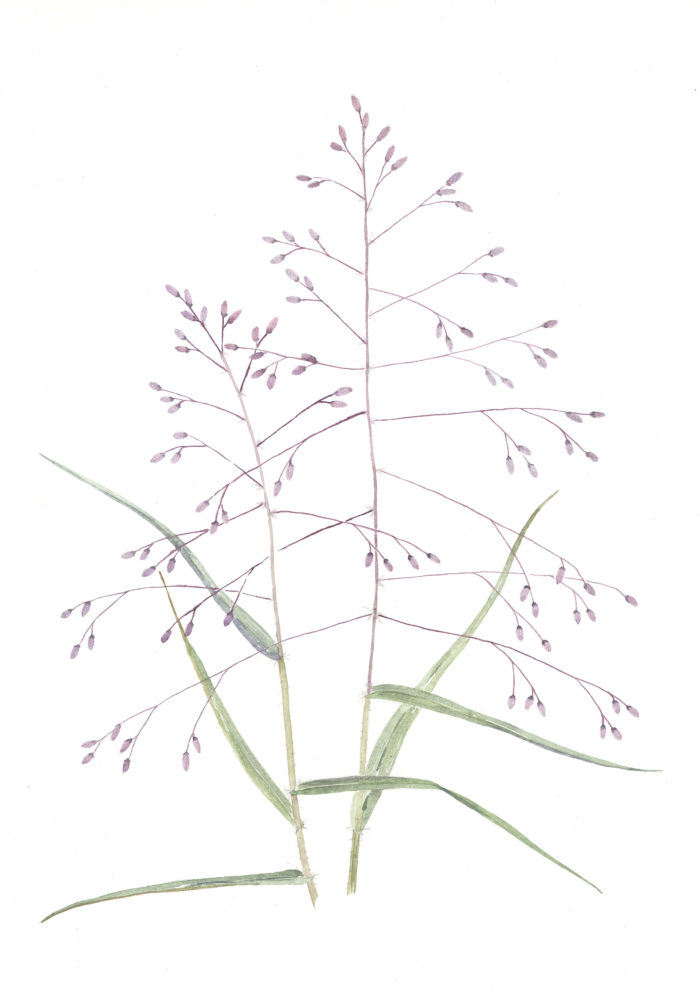
August 25th PURPLE LOVE GRASS
Once we were home I took a closer look at the grasses. In addition to tan and brown there are also many glistening greens, pale yellows, mustards, oranges, and even purples in their flowering tops. My favorite is a grass called purple love grass (Eragrotis spectabilis). This grass grows low to the ground in bushy little tufts forming clouds of purple along the roadsides in late summer and fall. Driving down a hill, seeing it in a valley below, it looks like purple fog or mist settling.
There is a whole new set of terminology for describing and identifying grasses, sedges, and rushes and it can be quite challenging, but fascinating none the less. You’d be surprised at how many different species you might find in a hundred yards of roadside. I found over a dozen before I nearly got run over, so I went back into the yard where I found even more. A good book to use if you get interested in grasses is Grasses, An Identification Guide by Lauren Brown.
August 27th POTATOES
Usually we don’t get around to harvesting the potatoes until September or October, but the plants in the front garden had turned brown so we dug them up early. The two short rows we planted there had five hills each. The potatoes were small, but there were quite a few. We boiled the smallest ones up whole for dinner. The others we’ll save for potato salad or potato pancakes.
August 28th TOMATOES
The tomatoes and hot peppers are getting out of control – it’s salsa time! This is Pete’s territory. The recipe may vary depending on how hot you like it, but basically it goes something like this:
4 large tomatoes
6 hot peppers (3 jalapeno, 3 cayenne)
1 medium onion
4 cloves of garlic
1/2 bunch (1/2 cup) chopped fresh cilantro
Juice of 1/2 lime (optional)
Quarter the vegetables and pass them through a food mill, meat grinder or food processor. Or you can dice them all up by hand for a chunkier salsa. This will make two 8 ounce jars, one which we usually eat right away with chips or tacos, and another that we store in the refrigerator. It will keep for about two weeks.
Whenever Pete makes salsa, I make tortillas. Because I prefer the texture of flour tortillas, but the taste of corn tortillas, I have come up with a recipe which is a combination flour/corn tortilla:
1&1/2 cups white flour
1/2 cup corn flour (masa harina)
3 tablespoons margarine
1/2 cup warm water
Mix the two flours and cut in the margarine. Add the water and mix with a fork until it begins to form a ball. Continue mixing and kneading it with floured hands to form a ball the size and heft of a grapefruit. It should be kneaded about sixty turns. Let this stand in a bowl covered with a damp cloth for half an hour. Then form the dough into twelve balls about the size of ping-pong balls. Return these to the bowl and let stand covered with the damp cloth for another half hour.
Forming the tortillas is easy, but takes some practice. This dough is too stiff to use a tortilla press, so I form them by hand with the help of a rolling pin or the side of a drinking glass. Taking one ball at a time, press it flat like a hockey puck between your palms. Hold it up between your thumbs and fingers and pressing as you go twirl it in a counter clockwise motion (much like making a miniature pizza). This should flatten out into a disc about three or four inches in diameter. Lay it on a lightly floured board and with a glass or rolling pin, roll it from the center outward working it thinner and larger to about six inches in diameter.
We cook these in a dry cast iron pan over the open fire. The flame and pan need to be very hot. A high flame on a gas range should work as well. Cook them for a minute on each side or until they form pockets (big air bubbles). Pete cooks the one while I form the next. These we serve with refried beans, cheese and salsa.
August 30th A BASKET OF KITTENS
There was a nip in the air this morning hinting of the approaching change of seasons. And although I enjoy the carefreeness of summer, I’m always ready for each new season as it comes. The first few leaves have even begun to turn color. It is the damaged or diseased branches or trees that often are the first to go. But there are still plenty more mild summer days ahead. In fact, both the columbine and arbutus seed that I planted some time ago have just now sprouted. If they make it through the winter in their little trays, I can transplant them into the garden in the spring.
The chilly morning, the turning leaves, the sprouting seedlings were not the only surprises in store for us today, for later in the morning our neighbor stopped in for a visit. Like country neighbors everywhere, we don’t visit on a regular basis but usually exchange nods and waves when we pass on the road, or stop in occasionally with a fresh loaf of bread, a pie, or more often a bounty of zucchini. This time Doreen had a basket of kittens. This was not a gift, but rather a plea. The kittens were two-week old wild orphans born under their house. The feral mother had been hit by a car two days ago, and her husband had to cut a hole in their kitchen floor to rescue the screaming, abandoned kittens. Not knowing quite what to do, Doreen called the vet and got instructions on how to care for them. Doreen works at the dude ranch just up the road and, not wanting to leave them unattended all day (besides they need to be fed every three or four hours at that delicate age), she took them to work with her hoping to solicit a volunteer surrogate mother. At the ranch they asked her to please not bring them to work the next day. She called our other neighbor who was also unable to care for the little wildings, but was helpful enough to suggest that maybe Pete and Shelley could help out for a couple of days. So here we are with a basket of five kittens no bigger than mice, two plastic feeding syringes, a can of evaporated milk, vague feeding instructions, and a small stuffed tiger that is supposed to be “Mom”. It wasn’t like we ever had a choice. The kittens were ours.
After finding and burying the real mother, we set about our task of learning the ins and outs of keeping the kittens alive. We warmed the milk and tried feeding them (this was no easier for us than it was for them, but we knew we would get the hang of it quickly, we simply had to). Although they barely had their eyes open they had an instinctive tendency to climb up the inclined sides of the basket, so we transferred them to a large deep box, lined with a sheepskin and clean towel. Then we drove to the library for whatever books we could find on the subject. Most of the pet books dealt with issues way beyond our immediate concerns, but we did find one book that at least mentioned caring for orphaned kittens. The chapter began by saying that one would have to be out of their minds to want to do this, but none the less it has been done. The evaporated milk needs to be mixed with an egg and served at 100¾, one tablespoon six times a day. We checked out the book and high-tailed it home to feed them again.
SEPTEMBER
September 1st WOODLAND ASTER
As usual, after a brisk hint of fall, the summer resumed. The temperature had risen back up into the mid-eighties, the sun was still shining, tomatoes still ripening, green beans still growing, and so on. We’ve become comfortable with feeding the kittens, who in turn are growing (some notably more than the others, and this is worrisome). Their eyes are fully opened now. In addition to feeding them several times a day, each kitten needed to be massaged to stimulate their bowels, or at least encourage them to pee. Their bedding had to be changed twice a day and washed. The kittens themselves needed to be washed, but the book advised against this. Normally of course the mother would lick them clean. We weren’t about to do this; changing the bedding was the best we could do.
In between feedings and the hand laundry I found that short walks along the creek, or better yet in the cool woods, were the most relaxing thing to do. Because we had to tend the kittens every three or four hours, these walks were necessarily brief. But the pleasure that I derived from them was lasting. When exploring a new trail, I can’t wait to see what’s around each turn, but even here, in my own familiar forest, new surprises sprout with each new day. Today the white woodland asters are blooming.
Asters (Aster spp.) are a huge group of flowers with many distinctive (and some not so distinctive) species. They hybridize easily and intermediate variations occur. All have alternate leaves which are variously shaped. The composite flower heads made up of disk and ray flowers vary in color and size from the tiny white blossoms of the wild heath asters to the large showy purple blooms of the New England aster. The white woodland or whorled wood aster(Aster acuminatus) is often the earliest to bloom, and is one of the few woodland species. Most asters prefer the sunshine of roadsides, fields and river banks. The flowerhead of the whorled aster is made up of white ray flowers surrounding yellow disk flowers that turn red to purplish once pollinated. It is a short plant compared to the other asters, perhaps a foot or two tall at best. Its leaves are crowded near the top of the plant, and although arranged alternately or rather spirally around the stem they appear as if in a whorl. The four to twelve more or less terminal blossoms are scraggly and about an inch across.
September 2nd SMOKE
The well remains dry so we have been in the habit of taking turns to get water from the creek. Pete usually makes a trip in the morning while the coffee water is boiling. I make a trip after the kittens have been fed and the laundry and breakfast dishes are done. I am prone to dawdling for quite some time down there on the sun drenched rocks and along the bank.
I noticed today that the Joe-Pye weeds are pretty well spent. They have been replaced for the most part by the tall gangly flat-topped white aster (A. umbellatus). These asters are four to seven feet tall with narrow dull green leaves and dirty white flower heads, not nearly as pretty as the petite woodland aster. Mixed in amongst the white asters are a few tall blue New York asters (A. novae-belgii). These asters have large blue blossoms sparsely arranged along the uppermost branches. The deep blue ray flowers encircle yellow disk flowers which turn purplish with age. The dark green leaves are long, thin and shiny. They are a handsome species.
Returning to the garden, the pale blue asters, both the large-leaved (A. macrophyllus) and heart-leaved (A. cordifolius) varieties have begun to bloom. In both of these species the flowers are smaller and paler than the New York asters, but there are many more of them on each plant. They make up in quantity for what they lack in size. Looking like weeds in the garden for most of the summer, in September they finally erupt into great clouds or puffs of blue “smoke.”
We brought the kittens outside for a while this afternoon for a bit of fresh air and exercise. The smallest of the litter always ended up at the bottom of the heap and was almost always damp. The food he was getting didn’t seem to have any effect and today he had lost his appetite as well. We separated him from the others, tried to feed him smaller quantities of food more often, and tried to keep him warm and dry. Unfortunately it was too late to make any difference, and even though Pete kept him in his breast pocket all afternoon (when he wasn’t feeding him) by evening when we laid him down in order to feed the others he quietly died. We buried him next to the mom. I transplanted a puff of blue smoke atop the tiny grave.
September 3rd INDIAN CUCUMBER ROOT
On my stroll in the woods today I came upon the Indian cucumber root(Medeola virginiana), its berries now jet black displayed above a whorl of three green leaves bleeding red from the center outward. This top whorl of leaves sits in turn above a larger whorl of six (occasionally five or seven) very regular, parallel veined, sharply pointed leaves. The entire plant grows from one to two feet tall. The berries are inedible as far as I know – it is for the root of this plant that it gets listed in the wild edible plant guides. The root, about one to two inches in length and pencil thick at best is pure white, crisp and juicy, tasting vaguely like a cucumber. I often dig up a few of these roots in the spring to add to our salads. It’s not a good idea to harvest too many, even if the plants are plentiful, for removing the root quite obviously destroys the plant. And not just the plant in question, but future generations too, for this plant depends on its root for propagation.
It flowers in May with the majority of other woodland flowers, well before the canopy of leaves is complete. The flower itself is quite interesting. The petals and sepals flop backwards forming a globe or what looks like a tiny paper lantern. The protruding reddish stigmas and downward pointed stamens transform the lantern into a miniature spaceship. Unfortunately these are hard to spot as they dangle from thin stems hidden below the top whorl of leaves.
September 5th TEETH
Yesterday two more kittens seemed to stop growing, lose their appetites, and flounder as they walked, their little bones caving under their weight. They got that telltale bony-cheek, bulging-eye look of the one we now refer to as the pocket kitty. Things didn’t look good. By evening one had died, and by this morning so had the other. There were five kittens originally and now there are two. The good news is that these two, a black male and a tortoiseshell calico, look like survivors. They have grown consistently, eaten with hearty if not ravenous appetites, they walk around with a bit of a bounce and their blue eyes shine. And they have teeth. The book says (the same one that insinuated we were of unsound mind) that once they have teeth they need meat. If the mother cat were alive she would hunt down a mouse and bring it home for dinner. The traps all empty, and unsure of how to prepare mouse in any case, we opted to go to the store and buy some meat. Top round, shaved across the grain and made into miniature meat balls warmed in our hands. We were instructed to feed these to the kittens and “watch them disappear.” It worked.
September 6th A BRIEF HISTORY of the CATS
The two kittens slept through the night and we did too. This morning there were big healthy turds in the box, and the little girl peed in a makeshift litter box when we lifted her out. They both had spunk, and they were hungry. We were feeling refreshed as well after the first full night’s sleep in a week. The anxiety over caring for the three ill-fated blond kittens was quickly dissipating in light of the vigor displayed by these two. We were somewhat guarded though, we knew we weren’t over the hump. They weren’t weaned and things could still turn for the worse at any time. We weren’t the mother cat after all, and although we were trying to do our best, we still couldn’t clean them and we weren’t ever sure if we were giving them too much food, not enough food or not the right food or whatever.
At any rate it rained for most of the day, so we kept the kittens inside and let them walk around. Our house is not a whole lot different than the outdoors anyway, except that it is dry. We noticed that the four-month old kittens from an earlier litter of this same feral female were hanging around our door on a regular basis. All that we could figure was that they were either jealous of the new kittens, or perhaps they suspected foul play. It’s difficult to understand the motives and attitudes of these semi-wild barn cats. They belong to no one, they are nobody’s pets. But they are not scrawny, they look healthy and sleek, and they are sly. We assume they want food.
Ever since we have lived here there have been cats that come and go. For years we thought they were the neighbors’ cats and hesitated to feed them. But over time we came to realize that these cats were skittish and afraid of humans. We couldn’t pet these cats; they were indeed wild after all. We began to respect them for their wild natures and eventually, one winter, to feed them. We enjoyed observing them from a distance, and had fun making up names for them. They seemed to have they own social rules and pride. Also they ate plenty of mice. We had no intention to interfere. When they came for food we’d give them some. When they didn’t, we didn’t worry. When they beat each other up and ran each other off, that was their own business. When they had a litter, they would often come by and show them off. Most likely they were teaching them where they might find an easy handout in times of need. Ours was not the only free meal; they made the rounds. Often times Mary Ellen would mention that the big black one was up at her house, and I know Doreen feeds them. We all had different names for them, but as I say they come and go. We would like to bring these two up as wild cats as well, but I’m afraid that may be impossible at this point. Meanwhile we’re still wondering what the “teenagers” have on their minds as they circle the house.
September 7th WILD RAISINS
In between feedings this morning I took another walk back in the woods. Except for the woodland asters there were no flowers out there, but I hadn’t really expected there to be. I was looking to see if the Jack-in-the-pulpit berries were ripe yet, but they were still green. Heading back toward the house I came eye to eye with the hobblebush berries (Viburnum alnifolium) now ripening. Like a checkerboard, half were red and half were black. The black ones are ripe and ready to eat. They have a subtle spicy flavor which is too delicate to describe. They are soft, mushy and small. I helped myself to a few of them, mashing them between my tongue and the roof of my mouth, then spitting out the seeds. There’s not a lot of food here or a lot of flavor, but it’s a simple treat I look forward to each fall. On years when the berries are profuse you can easily collect a cupful or two from a single bush. This year the berries are a little scant. In fact this was the only bush out of several that had any fruit at all.
September 8th BATH TIME
Book or no book, these kittens stink, and so we washed them. Rather than dunk them, Pete simply washed them with a warm slightly soapy washcloth and I toweled them dry. They looked and felt better too.
September 10th RUNNING WATER
On and off rain for the past couple of days has made the garden look messy. All the tall flowers, especially the blue asters, have flopped over, and as with the daisies back in June I went around and tied them back up again, using the same daisy supports in some cases. The afternoon sun will straighten them up again.
In light of all the rain we’ve had lately Pete primed the pump and gave it a whirl; we now have running water again. Although the garden hardly needs to be watered, we still have the extra hand laundry to do each day. Having the pump working is a welcome convenience
September 11th BEAD RUBY
Last night the skies finally cleared, revealing a multitude of stars rivaling the darkest of winter nights. Today promises perfection. The arc of sun is noticeably lower in the sky and so we don’t get as much sun in the garden as we used to. In fact in the morning there is no sun – so we took our coffee down to the front garden out by the road where we have set up a large stump (table) surrounded by four smaller stumps (chairs), and breakfasted on ripe tomatoes fresh off the vine. Later that afternoon we moved the picnic table from the southern corner of the main garden to the northern corner where it will be in the sun for most of the afternoon. It is here in this spot that I noticed under the hemlock and beech trees the bead ruby glistening.
Bead ruby (Maianthemum canadense) is probably better known as Canada Mayflower or false lily-of-the-valley. All three names are appropriate as it does bloom in May, has leaves (but not flowers) and a habit of growth resembling the popular lily-of-the-valley, and in late summer has translucent ruby-red berries strung along a flower spike like beads. Being a member of the lily family, its leaves are parallel veined. The first year plants have only one leaf and no flower stalk. The second year plants have two or occasionally three leaves alternately ascending a crooked stem which reaches to the height of about six inches and is topped with a raceme or spike of fluffy white flowers in the spring. The flowers are uncharacteristic of the lily family’s traditional plan of three. If you look closely, you’ll discover that each tiny flower is instead made up of four regular parts. They in turn produce berries which are at first green, then become tan with dark red speckles, and eventually ripen to a deep ruby red which, when backlit by the sun, sparkle like jewels.
September 13th THE FAVORITE SPOT
One of Sandye’s favorite spots when she comes here to visit just happens to be one of my favorite spots also. It’s the bank along the Hudson River, a dozen or so miles from our house. At this point along the river there is a paved road roughly following one bank, and a dirt road and railroad tracks along the other. A large rock juts out into the river on the far side (good for fishing), while big smooth slabs of quartz line this side. It’s a great spot for swimming or sun-bathing. In addition there are hiking and cross-country ski trails.
So after our picnic, while Sandye and Rik took a dip and Pete read a book, I searched the bank for remnants of the cardinal flower. I had hoped to find them still blooming, but I was too late. The two foot stalk of (I believe) the very same plant I’d sketched back in July was lined with a dozen or more dry, slightly angular or roughly round seedpods. Each pod held plenty of tiny rust colored seeds which I assumed were ripe. I folded a couple of these pods carefully into a corner of napkin to take home and plant. The majority I left there to the whims of nature.
Rejoining the rest of the group, I found myself sitting in front of a plant tucked neatly into a rock crevice. This plant was even more delicate than the harebells which were still blooming here and there in crevices of their own. This was, like the cardinal flower, a lobelia. I could tell that it was by examining the structure of the flower, the lower lip of the corolla having three lobes forming an apron and the upper lip split into two ears. I was very surprised by this delicate lobelia, as I had for some reason always thought of blue lobelias as being big showy plants, perhaps because the species most often pictured in wild flower books is called great lobelia (Lobelia siphilitica). Later I found out that the plant I had encountered was a brook lobelia (Lobelia kalmii).
Brook lobelia is distinguished by a pale blue flower with a distinctive white mark in its center. The flower is tiny; less than a half inch across. The flowers dangle from thin thread-like stems along an equally thin wiry stalk six to sixteen inches at best. The leaves are alternate, thin near the top and slightly wider or spatulate near the base.
September 15th WEANED
The past two days we have been trying to get the kittens to lap the milk from our palms instead of sucking from the syringe. They had begun chewing on the plastic tip more than sucking from it anyway, so we realized it was possibly a good time to try and wean them.
Whenever Sandye visits, she always brings a new painted flower pot, and this one came with a contrasting blue saucer. This looked like just the right thing for the kittens to eat out of; something not too deep that they couldn’t tip over. Even so, it was a fairly messy process and we had to hold them back so that they didn’t sit in the milk rather than lap it. In the end our efforts paid off. They are now weaned.
It was at this time too that we began to wonder whether we should keep the kittens or try to find them a good home in a real house. Telepathically the teenage vigilantes must have heard our contemplations, for this morning when we took the kittens outside and set their box sideways so that they could come and go at will, the teens crawled right in with them. At first we weren’t sure if they were going to eat them or what, but as it turned out they proved to be great babysitters. They even taught us a thing or two about how to handle the kittens as they played with them and began cleaning them. It looked as if the kittens had found their own home after all.
September 18th SILVER & GOLD
Two days of heavy wind and rain – the remnants of a coastal hurricane – knocked the power out for an entire day. Except for the refrigerator not running, we may not have even noticed. Today the power is back on and it is an absolutely beautiful day with that fresh clean air always present after a storm. Lingering over coffee down at our sunny breakfast spot I was wowed by the patch of goldenrod surrounding us. There are well over sixty species of goldenrod distinguished from one another by their leaves and also by the way in which the flowers are displayed at the tops of these tall graceful plants. They may be arranged in a feathery plume, elm-branched like a fountain, flat-topped, clublike, or slender and wandlike. The one pictured here, sharp-leaved goldenrod (Solidago arguta) is considered plumelike and has a reddish brown stem.
In addition to the goldenrod there was also silverrod (S. bicolor), an often overlooked species bearing white flowers instead of the customary yellow flowers we associate with goldenrod. The flowers are borne in small clusters arranged alternately at the ends of short branches along the upper portion of the slender wandlike stalk.
September 21st EARTHSTARS
Besides the many miles of state-owned hiking trails within the Adirondack Park, there are many more miles of trails owned or maintained by the various towns, counties, private and civic organizations both within and without the park. It was one of these, a nature preserve just outside the park, that I wanted to explore today. With all the wet weather we’ve been having I thought it would be a good time to look for mushrooms.
The trail was circular, about a mile and a half around, and passed through a mostly dripping deciduous forest. There was a lovely lush grove of tall ferns, emerald green from the recent rain, looking for all the world like a prehistoric diorama. A couple of well-placed plastic dinosaurs would have been just the thing. Near the end of the loop we passed across a shale pit grown over sparingly with small trees and shrubs. This is where I found what I had come looking for – Earthstars.
Earthstars (Geastrum spp.) are basically inedible puffballs with an outer layer or skin that splits radially, the rays of which form a star upon which the puffball sits. There are several species differentiated by the shape of their mouth opening, whether they are stalked or stalkless, their habitat, and the way in which the outer layer splits and opens.
As it turns out the species that I have found here is from a different genus altogether. It is a water-measure or barometer earthstar (Astraeus hygrometricus), often confused with earthstars of the Geastrum genus. The rays of this common earthstar open in wet weather and curl back up in dry weather. Today, being wet, they were all open, and being in various stages of age, they were variously colored from pale pinkish tans, to orangy browns to almost black. Scattered atop the grey shale, camouflaged by the leaf litter, this was a subtle rather than commanding display, and we had to actually search for the stars.
September 22nd PUFFBALLS
I was stacking some birch logs over by the back woodpile and noticed a number of ripe, ready-to-eat puffballs. These were not the giant, soccer-ball size puffballs (Calvatia gigantea) that books often claim grow up to two or more feet in diameter. No, these were the little gem puffballs (Lycoperdon perlatum) measuring one or two inches in diameter, round or nearly so, looking somewhat like lost golfballs. Covered with tiny blunt spines, the surface is pale tan or dirty white. They are good to eat when firm and fresh; when the flesh cut crosswise is pure white and the consistency of a marshmallow. If the flesh has begun to yellow they are too old, wait for another rainy day. Or if the flesh is dark inside or there are vestiges of what could be the formation of a cap and gills, you’ve got the wrong species, very possibly a poisonous one.
We saute these in butter, like you would a store bought mushroom. We have also used them to make a delicious cream of zucchini and mushroom soup. They are fresh and good but apparently inferior to the acclaimed giant puffball mentioned earlier. My neighbor tells me he finds the giant ones all the time in the woods, but I have never seen one. He said he’d bring us the next one he finds.
September 25th BOATS FLOAT
We harvested the last of the cucumbers, hot peppers and tomatoes from the garden and made pickles, pickled eggs with hot peppers, more salsa, and a pot of tomato sauce. Feeling satisfied with our labors, we spent the afternoon sitting on the sun-drenched rocks in the creek doing absolutely nothing. More leaves were turning with each passing day, and with the rainy blustery weather we’ve had of late, a good number of them had begun to fall. We watched as these quietly fell, floating sporadically this way and that on the updrafts before eventually settling in the creek. Once in the water they became little boats making their way to New York City (and I suppose from there to foreign ports unknown.) The fleet: sturdy oak vessels, bright red maple rafts, and delicate birch canoes.
September 26th HONKERS
While once again having our coffee down in front we heard the honking of the Canada geese heading south. While looking up for the geese I noticed that the woodbine climbing up a number of the tall white pines had begun to turn red. Woodbine (Parthenocissus quinquefolia), sometimes called Virginia creeper, is a woody vine trailing along the ground, or more often climbing fences and trees to the height of twenty feet or more. It branches freely and clings to its support by means of little adhesive disks at the ends of tendrils. The leaves, each made up of five palmately compound leaflets, are arranged alternately along the length of the vine. The inconspicuous flowers turn into attractive blue berries in the fall. The berries are for the most part hidden underneath the leaves, which is a shame, as they would most surely be striking against the crimson foliage. Once the leaves have fallen, however, the berries are easy to see attached to their bright red stems. They persist well into the fall and winter.
Woodbine is often confused with poison ivy, perhaps because of its viney habit of growth, but woodbine has five leaflets whereas poison ivy always has three. Poison ivy berries are dirty white, pale yellow or greyish. Its leaves are as apt to turn yellow in the fall as they are to turn red. In addition, poison ivy lacks tendrils or disks. It climbs (when it does) by means of aerial rootlets.
Sept. 28th SHUT DOWN
The drive into town today was a surprise for me. The fall colors were farther along than I had imagined. When living within the woods, under the leaves, the progression appears slow and subtle. It’s like living under a silk umbrella whose color changes daily. One day green, then chartreuse, now yellow, now gold. Seeing it from a different perspective, out there on the highway, was jolting. The trees indeed were beginning to shut down for winter, and doing it with a visual bang. The vivid yellows and oranges made a perfect backdrop for the showy, royal-purple New England asters (Aster novae-angliae) now blooming everywhere. Enough has already been said about asters, suffice it to say that these are quite rightfully considered the King or Queen of Asterland.
Heading home, we stopped at the local fruit stand for some apple cider, the fresh pressed kind with no preservatives. Every year we buy a gallon or two. Most of it we drink sweet, but we always set aside a quart or two for vinegar. To make the vinegar we fill a quart jar to just below the shoulder. Covered with a few layers of cheesecloth and set in a warm place, this will eventually form a thick scum on top, a process called mothering. Left for a month or more it will turn to vinegar all by itself. This is unpasteurized vinegar, reputed to be more beneficial healthwise than the commercial pasteurized vinegars sold in stores. It is also delicious.
September 30th LOW PRESSURE
Yesterday was one of those queer, ominous, foreboding days. The air was thick and still. The woods were especially quiet. No chirping birds or chattering squirrels. Not even a rustle in the underbrush. By nightfall the air pressure was so low that one of our bottles of homemade wine popped its cork spilling half its contents across the room. Shortly thereafter the rain began. It rained heavy all night long and by morning the wind kicked up. Eventually the rain ended, the clouds broke up, the sky cleared, and by afternoon it had turned into one of those perfect autumn days. We took the clue; dried off the bikes, pumped up the tires, packed the half full bottle of wine in the bicycle basket, and went out to enjoy.
OCTOBER
October 1st WINDFALL
According to my memory the apple tree was on the right on a wooded curve just past a relatively long stretch of vacant farmland. Back roads not often traveled, however, are rarely as one remembers them, and so there was no stretch of farmland and no curve to the right, but there was an apple tree. In fact there were several. The spot where we finally stopped had apple trees on either side of the road. The tree on the right had larger green apples tinged with red, while the one on the left had yellow apples, slightly smaller, but still considerably larger than the tiny sour crab apples found in abundance throughout the region. Both tasted fine, and though the branches were too high for picking them, there were plenty of good ones on the ground and a hefty shake of the lower branches brought down many more. Pete and I each collected a bagful and were on our way.
October 2nd APPLESAUCE
This morning was spent peeling and coring yesterday’s generous find. Wild apples (Malus spp.) or windfalls, as I like to call them, are generally smaller than commercial apples and quite irregularly shaped, often with bruised spots, making the peeling job considerably more difficult. They are nonetheless just as good or perhaps better. This batch was tart and juicy.
Pete had gotten up as usual about an hour before me, and he had a perfect fire burning in the outdoor fire place. So, with coffee steaming in our cups, I filled a four quart enamel pot with about two quarts of the cut up apples. I added a little bit of water, maybe a cup, to keep the apples from burning or sticking until they could break down enough to start making their own water. With a little bit of stirring, poking, and mashing, in about half an hour they were cooked down to a delicious, piping hot, tart and somewhat lumpy applesauce, just the way I like it. (You can add sugar or cinnamon, if you want, but I prefer it just plain.) What we didn’t finish for breakfast, I put in the refrigerator, where it should keep for a week or so. It could be canned of course, but then that’s turning it into a big job. And although I enjoyed being at the fireside, I didn’t really want to be stuck there all afternoon.
Being a perfect autumn day, complete with brisk fresh air, golden shimmering leaves and a beckoning clear blue sky, I took a bikeride down the road to see what wildflowers were left still blooming. In a couple of miles I was rewarded with a robust clump of bouncing bet (Saponaria officinalis). These have been blooming all season long with the other roadside flowers, but now that most of the other flowers have ceased to bloom, the bouncing bet stands out proud, sturdy and blushing pink. There are plenty of new buds, which arrange themselves horizontally on the stalk, to insure that these plants will keep blooming for several days more. Once pollinated these flowers will assume an upright position, making room for the younger buds beneath to bloom. The leaves are bright green, opposite, entire (not toothed), smooth and wavy, and although net-veined, they have three conspicuous parallel ribs. It is also called soapwort, and according to most sources the leaves make suds when rubbed together in water. This is due to the chemical, saponin found in the herb. It is said to have a mild cleansing effect, especially good for cleaning delicate and fine fabrics. I tried this once upon a time, but merely ended up with a wash basin of pale green water, a bubble or two. Maybe I didn’t use enough of the plant – at any rate it seemed like a rather ineffective and wasteful use of such a cheery, perky plant.
October 3 CANADA GEESE
For the past few days, we’ve been hearing small groups of geese flying overhead. Today the big flock came by on its trek south. It is impossible to count them, forming and reforming their ranks as they go, but this group contained three rows of V’s, one longer and two short ones, creating a very distinct if slightly irregular chevron. Even though we have not yet had a killing frost (which is fairly unusual for these northern parts), this is a sure sign that summer is done, time to turn under the garden.
October 4th SOUR GRAPES
Speak of the devil, last night we did have a killing frost. Whatever was left out in the garden – the zinnias, basil, nasturtiums and morning glories – all got nipped by the frost and are now shriveled and brown. One plant, however, that definitely benefits from a frost is the frost grape (Vitis vulpina). This, like all wild grapes, is a long climbing vine of the roadsides and riverbanks, crawling over brush, brambles and trees alike. Many different species of wild grapes are common in this area, and they hybridize readily creating an endless variety of intermediate forms. All have familiar fruits and recognizable three to five-lobed leaves. They vary in minor details: size of the fruit, the density of the fruit clusters, the depth and number of the leaf lobes, and the toothyness of the leaf margins.
Care should be taken so as not to mistake the edible grape with the dangerously inedible moonseed (Menispermum canadense) whose fruits, although they look like grapes, contain a single stone or seed shaped like a flat crescent or ring. If ingested, the sharp edges of the pits could cut up your insides. Eaten in quantity they are known to be poisonous. Grapes, by comparison, usually have two or more seeds which are smooth and nearly round. Moonseed leaves are lobed like grape leaves, but the margins are not toothed. In addition the moonseed vine climbs by twining. It wraps itself around and around its host plant, often strangling and killing it. Grapevines climb by means of their tendrils, less threatening to the plants they use for support.
The frost grape is so called because although a small sour tasting grape, it is sweetened by the frost. It is quite easy to gather up a pailful of these petite grapes, but the ratio of fruit compared to seed and skin is so small that it makes eating or cooking with them frustrating if not impossible. Nonetheless, how could I resist? One year when the blackberries ripened later than usual, we mixed some with these grapes, and with added sugar and water made a gallon of pleasant “Wild Grape & Blackberry” wine.
October 8th BURIED TREASURE
The weather has become overcast and drizzly, a good day to get the garden work done. There is a row of potatoes to dig up and so we’ll start there. It is always exciting (sometimes disappointing) to dig up the potatoes, somewhat like digging for buried treasure. The potatoes we dug up last month were plentiful and of a fairly nice medium size. We figured these would be the same. The first hill yielded two small potatoes not much bigger than cherries so we prepared ourselves for disappointment, but lo and behold the second hill had a huge one. The next hill two huge ones, and so on down the line. A nice harvest after all.
October 9th WITCH HAZEL
For the past several evenings while preparing our evening meal at the outside hearth I have been distracted by a tiny snap or pop off to the right. It has just occurred to me that this is the witch hazel (Hamamelis virginiana) releasing its seeds. The witch hazel is a small tree or large shrub, usually a rather scraggly looking plant with bright yellow flowers (also scraggly) which bloom in the fall, late September and into October. Once pollinated, these flowers will take an entire year to form a ripe fuzzy fruit pod. And so, uniquely, both blossoms and fruits are present on the tree in October.
Another oddity of the witch hazel is its naked buds. While most tree buds are encased in a protective husk of some sort, these buds, about a quater inch long, remain unprotected all winter long looking like a lopsided pair of minute withered leaves. Poison ivy and hobblebush are the only other two species I can think of that share this peculiarity.
At this time too, the leaves have turned from their summer green to a very bright, pure yellow. And if this were not enough, the fruits now commence to pop open with a definite “snap” dispersing their seeds several feet away to perhaps become new trees. For this reason you will often find witch hazels growing in rather large, but loosely clustered groves. The leaves and twigs of this species are the source of the medicinal witch hazel commonly found in drug stores. A few branches tossed on the campfire produce a familiar, clean scent.
October 12th LEAVES PEAK
Columbus Day weekend is here, and as usual the fall foliage is at its peak. It never seems to make a difference just what calendar day Columbus Day actually falls on, or whether some trees turn a little early or others linger longer, whether it’s rainy, overcast or sunny, fall colors will peak on Columbus Day; there’s just no getting around it. In fact there’s even a reason for it, one that is actually quite simple and straightforward. It goes like this:
The spectacular colors of the autumn leaves that we are all familiar with are caused by chemicals or pigments in the leaves. Different pigments produce different colors. These pigments are present in the leaves from the outset, but the color is buried by the overwhelming presence of chlorophyll which is necessary for the leaves to manufacture food for the tree throughout the summer by photosynthesis. This is their function. When the days get shorter, the trees begin to shut down for the winter. As the chlorophyll molecules break down, the previously hidden colors begin to appear. This doesn’t happen overnight or all at once, but is a gradual process. Unlike the timing of the sap run in the spring, the timing of the autumnal color display is not dependent on the weather, but is in fact triggered by the shorter days of fall.
So on this weekend traditionally, not only is the forest aflame in a blaze of color, but into the bargain every art gallery, craft shop, antique store, cider mill, and restaurant in the area will be offering up their season’s finest. Cars will no doubt be stopping in the middle of the road to take photographs. And surely we’ll have a friend or two dropping in for the weekend. This works out fine, because I get to serve my freshly made applesauce and Pete makes potato pancakes from our homegrown treasures.
October 14th LEAVES FALL
After spending a couple of relaxing afternoons reading down at the creek, enjoying the fantastic foliage festival in what seemed to us to be our own private showing (after Columbus Day, nearly all the summer people and tourists have left), by mid-week the heavy winds and rain came and stripped the trees of all their fall finery. Only the deep rusts and dark ambers of the oak and beech trees persist. This is a great time to gather up more roadside apples. Not only are there more fallen on the ground, but without the leaves, those still on the trees are easier to spot. They look like little yo-yos dangling by threads in the bare branches.
October 16th NOUVEAU DENT DE LION
The five gallons of dandelion wine which we made last May have been racked and settling since June. They are now ready to be bottled. To do this we boil a large pot of water on the outside fire for sterilizing bottles and utensils. When the bottles are all clean and ready, we set the gallon jugs of wine up on a chair or stump and siphon the wine into bottles placed beneath them. Each gallon fills five bottles. Next we cork and label each bottle. For a more delicate flavor we leave them to mellow for a few months. But as always, in mid-October, a little Nouveau Dent de Lion celebration is in order. A pork roast with dumplings will be the perfect complement.
October 18 MOVING IN
Today dawned dry, partly sunny and somewhat mild. It looked and felt like a good day to wash the windows. Seeing that our house is nearly all windows, this is a formidable job. It is part of what we call “moving indoors” and is akin to fall cleaning. We will do it all over again in the spring, when once again we move back outdoors.
All of our windows, except three which are hinged, are set into their frames and latched into place by means of handfashioned wingnuts (a short piece of lath on a swivelly screw, actually) so that they may be easily removed from inside. Originally we had intended to take the windows out for the summer months, but as it turned out we couldn’t find a suitable place to store them. Since we are outside nearly ninety percent of our waking hours from April to October we can get all the breeze we want out there, and besides, the house stays cooler and cleaner with the windows in.
Another task of moving indoors is bringing in the cupboard. In the summer we do all of our cooking and dishwashing outside, so we keep the cupboard conveniently outside, under the porch. Now we need to empty it, wash all the dishes, bring it inside, and fill it back up again. Next we’ll bring the picnic table indoors. This basically serves as our kitchen counter for the winter. On one end we prepare food, the other I use for dishwashing; an elaborate set-up of wash basin and kettle.
The final chore is to dismantle the pump. The manual pitcher pump stands in the middle of the garden. It is connected via an underground pipe to a shallow dug well about thirty feet away. The water in the well won’t freeze, nor in the pipe, but in the pump it would. In fact it has once, some years back, resulting in a cracked and ruined pump which we had to replace. Now Pete simply unbolts it from its stand and stores it in the shed. Wash water during the winter must be hauled up from the creek. We are now ready for the snow.
October 20th POT OF GOLD
Happily, the weather remains mild and sunny. Sitting out on the rocks in the creek this afternoon we were surprised by a sudden rain shower, followed by the more pleasant surprise of a rainbow just downstream. This one was so distinct, you could visually follow it right down to the ground. Looking for the “pot of gold,” we realized we were sitting in it.
October 22nd FOR THE BIRDS
Down along the riverbank, where we had gone for a picnic, I spotted a thick stand of wild roses. This time of year there were no blossoms of course, but there were plenty of ripe hips. Because they persist all winter, rose hips are a favored winter food of woodland wildlife when most other sources are buried under the snow. We like them as well.
These were the little hips, a half inch or less in diameter, from the common pasture rose (Rosa carolina), the state flower of New York. This rose blooms in June. Like all wild roses, the blossoms have five delicate petals surrouding bushy yellow centers. In this species the petals are a pale pink and the entire flower measures less than two inches across. It is a short, shrubby plant with compound leaves made up of three to nine finely toothed leaflets. There is a thin flange-like growth called a stipule at the base of each leaf where it is attached to the stem. It grows along roadsides, riverbanks, and in old fields. Oftentimes, in late June or early July, I have smelled its fragrant scent even before seeing it.
Some species of wild roses have large hips up to an inch in diameter, the pulpy flesh of which is thick and juicy, ample for turning out jams and jellies. These hips here are by contrast dry and seedy, but steeped in hot water, they make a pleasant tasting tea, rich in vitamin C. I collected a pocketful; leaving the lion’s share for the birds.
October 24th AUTUMN BOUQUET
The weather, unlike the time change, can’t seem to make up its mind if it wants to spring ahead or fall back. One day it’s cold and cloudy, the next, sunny and mild. Today is one of the sunny ones and so I took a leisurely hike down along the creek bank to where it meets the Hudson River and then back again. I was looking for the perfect milkweed pods (Asclepias syriaca) to put in vases to dress up the now barren garden. The pods have recently opened and are in various stages of releasing their seeds creating attractive abstract patterns. And even after the seeds have all parachuted forth, the pods remain; grey, rough and warty on the outside, but smooth and silky on the inside, like an abalone shell.
I easily found more than enough, and gathered up a bundle to take home. In addition I found, along the roadside, some lingering knapweed (Centaurea maculosa) still displaying its pale purply-pink ragged blossoms. This particular species of knapweed is also called purple star thistle or spotted knapweed. Many folks simply call it wild thistle. It is cousin to the larger cornflower or bachelor’s buttons (Centaurea cyanus). Bachelor’s buttons, however, have a darker, bluer blossom and are not quite as common in the wild as the spotted knapweed. The species pictured here grows in the absolute worst of soils; in gravel pits, abandoned parking lots, roadsides, etc. A few late lethargic bumblebees were taking a little nap in the flowers before giving it up altogether for the winter. Together with some rose hips and a few persistent Johnny-jump-ups, this will make a nice little bouquet.
October 27th TREES
The moon being in its first quarter, I transplanted some trees from undesirable spots (like those growing in the middle of paths or in the garden itself) to the more open areas up back where they will have room to grow in peace. These are young seedlings, a foot or less in height. The smaller the seedling, the easier it is to transplant, and the better its chances for survival. We have transplanted some rather tall white pines over the past few years which are doing exceedingly well however, despite their size when transplanted. A spade, a bucket of water, and a waxing moon are the only requirements for success.
October 31st TRICKED
We dilly-dallied in town today just because the weather was so nice. In the park, along a back slope, I found forget-me-nots (Myosotis scorpioides) blooming. Forget-me-nots are generally thought of as springtime blossoms, but here we have an excellent example of a spring flower that occasionally blooms again in the fall. Bluets, violets, and dandelions also often bloom again in the fall, triggered by the length of available daylight, or more correctly, by the length of available darkness. In this case the shorter days of autumn resemble the short daylight hours of early spring, and so the plants are tricked.
Forget-me-not is a small, delicate plant from six inches to perhaps a foot tall. The dull green, egg-shaped leaves are each only an inch or two in length and are arranged alternately along the stem, as well as in a rosette at the base of the plant. The small, but intensely blue flowers each have five round petals with bright yellow centers. They bloom at the top of the plant in branching, arched clusters. They reseed readily, and are often found in dense patches. Actually, they aren’t really wild: they are escapes from cultivation.
NOVEMBER
November 1st RAKING LEAVES
Typical of November, the chilly and damp weather has arrived. We have been lately in the habit of lighting up the woodstove in the morning for a couple of hours to warm up the house, but it seems a waste of wood to keep it going all day long if there’s work to do outside. We can always find a little something more to do in the garden. Today Pete turned under the two patches of clover that we had planted as a “green manure” this past August after harvesting the peas, beans and early lettuce.
Meanwhile, I went into the woods and raked several wheelbarrow loads of leaves from under the hardwoods to spread over the garden. I went back for a few more loads to layer onto the compost pile. So while many people are busy raking their leaves in an effort to get rid of them, here we are making untold trips into the woods harvesting them. Either way, it’s invigorating exercise and a good way to keep warm out of doors this time of year.
November 2nd ART AND MUSIC
When there is work to be done, whether it’s gardening, woodcutting or some other maintenance chore, Pete and I always do it together. But when it comes to art and music we ply our trades alone.
Hence today, it being damp and drizzly again, I elected to stay indoors with a lingering fire in the woodstove and work on notecards to take to the local consignment shops for their upcoming holiday season. These I sketch from drawings which I have done earlier in the year in my notebook. Tiny pine trees, sprigs of wintergreen, blue asters, and partridge berry all fit nicely on the miniature gift cards that the stores have ordered.
Pete spent the day indoors too, in the Hodge Podge Lodge – a small outbuilding he’s set up as a studio – writing and recording a new song.
November 4th SWEET FERN
After finishing up a few errands in town we stopped at one of our favorite spots along the Hudson River to collect sweet fern leaves. Sweet fern (Myrica peregrina) is a shrubby plant with leaves that look very much like fern leaves, bracken in particular. The leaves are attached alternately to a woody stem growing to a height of two or three feet. It grows in poor soils and often in large stands. Each slender leaf, from four to six inches long, is neatly and evenly lobed the length of the leaf along either side of a prominent midrib.
Related to bayberry, the plant is highly aromatic. The dried crushed leaves can be used as stuffing in a sachet or pillow. At this time of year many of the leaves have already turned brown, curled up, and fallen from the plant. It was by the intense fragrance alone that I was able to locate the shrubs. A few of the plants still had their leaves in tact, some even still green, and it was one of these that I used as a drawing model. After my sketch was done I gathered up a bagful of the fallen leaves to make into a pillow.
Being so fragrant, I was sure it would make a delicious tea. It is even listed in many of the wild food guides as such. But it was disappointing. Bradford Angier suggests brewing it in the sun for at least three hours, but even after three days in the sun it was still agonizingly weak. The agonizing part was that the faint flavor that was there was deliriously sweet, yet infuriatingly unavailable. Brewing it with boiling water was even less successful.
November 9th HOME AGAIN
Taking a trip, even for just a few days, is something which we find fairly essential to do this time of year. The leaves and flowers are for the most part gone and the weather is more than likely chilly and damp, but without the pleasures and prettiness of the snow. In a word, it is bleak. So when we received a note from our friends in Rochester, inviting us to come visit and play a couple of nights with their band, Invisible Idiot, we didn’t have to think twice. Needing to take along our instruments – Pete’s guitar, bass and amplifier and my maracas – Pete packed the car while I washed the dishes and then we were out the door.
As most everyone agrees, the best part of taking a trip is coming home again. The house seems to refresh itself; it smells all piney and rejuvenated. Everything is just as we left it. The dishes now dry on the table, kettle full on the stove, dry kindling to start up the fire right there next to the stove, the chairs at angles just so, the chaise all inviting, and yes, there’s even enough milk for coffee tomorrow morning in the fridge. And nothing frozen. (A genuine concern when we go away overnight at this time of year.)
November 12th WILD MINT
Finally the sun came out and like inky dinky spiders the world over, so did we. Substituting the creek for the spout, we spent the day down there, enjoying the sun, reading, and foraging on the bank. I found, along with some old bottles, some wild mint (Mentha spp.), which I gathered and will hang to dry from the rafters. With the woodstove burning and the heat constantly rising, it will dry quickly, in a day or two, and therefore retain its green color. Herbs that are dried too slowly will often turn brown in the process, but will retain their flavor and goodness just the same.
All members of the mint family have square stems and opposite leaves. Some, like spearmint and peppermint, are more aromatic than others. They are often branched and the flowers are either borne in the leaf axils or at the tips of the branching stems. The individual flowers are small and somewhat complicated, being formed of five fused petals which in turn form two lips. The lower lip consists of three petals, the upper of two which are longer in some species, shorter in others, but generally form a cup, cap, or little hood. The flowers grow in clusters, and so while the individual flowers may themselves be small or inconspicuous, the clusters are often quite showy. Colors range from white or pale blue as in catnip (Nepeta cataria), to purples, pinks and even the brilliant scarlet of Oswego tea (Monarda didyma) also known as bee balm. Nearly all members of the mint family can be brewed into a pleasant tea.
It is best to gather herbs which you intend to dry for teas, and/or seasonings when the plant is in bloom. They are said to be at their most potent then. They are also more readily identified when flowering. In most cases this will be in late spring or early to mid summer. I try to fill half a dozen or more pint jars of various dried herbs to last the winter through, but generally panic in the fall when I see how quickly we start using them up, and go out like today and gather whatever green things are still out there. Usually this will be just the mints and speedwell.
November 13th WINTERGREEN
Still in a foraging mood, I went out in search of wintergreen leaves. Wintergreen (Gaultheria procumbens) is a short creeping plant of the forest floor. The stiff, glossy leaves, from one to two inches long, are dark green on top and a pale lighter green underneath, often with tiny brown dots. Older leaves will sometimes turn a dark burgundy red. The white waxy flowers bloom in late June or July. One or more hang like ornaments from just under the top leaves, their shape resembling a crimped petticoat or perhaps one leg of a pair of bloomers. Being related, there is a family resemblance to blueberry blossoms. The pretty red, not blue, edible berries finally ripen in September or October. The berries not only persist on the plant all winter long, but continue growing, and will be even bigger, juicier and sweeter in the spring after the snow melts.
Wintergreen makes a delightful tea, and for this you need a lot of leaves, freshly picked and cut or bruised in the pot. Let these steep for 15 or 20 minutes at least. Unfortunately it does not work well with dried and stored leaves, as the volatile oils which give it its characteristic flavor and aroma evaporate upon drying rendering it useless. Fortunately though, it remains green all winter, and so before the snow falls, or even under a light covering of snow you can find and gather enough fresh leaves for enjoyment that same day.
Euell Gibbons offers an alternate method, what he calls the “proper” way, to make wintergreen tea in his book, Stalking the Healthful Herbs. His method allows the tea to ferment for a couple of days in a covered jar before heating it, thus releasing more of the volatile oils and therefore more flavor. It sounds like a good idea, so perhaps I’ll give it a try.
November 16th THE COMMON COLD
I could feel it coming on last night, and probably should have had a pot of tea, chicken soup, and some vitamin C, but choosing to ignore the symptoms, I awoke this morning with a cold or bug of some sort. This was a doozy. So instead of coffee I went ahead and made that pot of tea. I choose a combination of speedwell, mint and thyme. Next pot I varied with cayenne instead of the mint. Third pot, I tried Three-berry – my own concoction of strawberry, raspberry and blackberry leaves – with lots of honey and lemon. I had a nightcap of catnip along with a hefty dose of Vitamin C (and yes, Pete made chicken soup for dinner). I awoke the next morning good as new, or nearly so.
November 17th TUBERS
We had a light covering of snow during the night, and all of a sudden everything looks wintry and wonderful. No matter when it arrives or how much it accumulates, the first snow of the season excites me now as much as it did when I was a little girl, running around in circles catching the fresh flakes in my hand, on my sleeve or on my tongue.
In spite of the snow cover the ground was not yet fully frozen, so we decided to dig up some Jerusalem artichoke tubers(Helianthus tuberosus) for dinner. Jerusalem artichokes are related to sunflowers. They grow to a height of ten feet or more. They are so tall I need a step ladder in order to draw the flowers which bloom in late August or September. Each flower head is made up of a dozen or more bright yellow ray flowers encircling the tiny mustard-colored disk flowers.They face and follow the sun as it travels from east to west. In this way they resemble sunflowers, but the heads are much smaller, more like the familiar black-eyed Susan.
Luckily the edible part is underground. We dug up about five or six tubers, each approximately two inches long. They don’t store well, so it’s best to dig only what you need at the time. We will be able to continue harvesting them until the ground freezes solid, and then again in the very early spring. They can be prepared many ways. Simply slicing them cross-wise, raw, makes an easy snack, a nutritious little chip. Or you can parboil and saute them to serve as a side dish, or add them to soups. Tonight we plan to grate them up along with an onion, mix in an egg, a tablespoon of flour, some salt and pepper, and then fry them up like flapjacks.
November 19th TAIO
Today is the day we finally get to go visit with our friends on their boat, TAIO. We have been planning this rendezvous for a couple of months now and are anxious and more than ready. The drive is about an hour and a half and we are to meet at the docks after the last lock gate. We are not really sure where this is, but we do know where the river is and I have a map. Likewise they are not really sure where they are in relationship to the land, as they have been on the canal for five days now and from their point of view the land is merely scenery; roads and route numbers have little meaning to them. It is, we know, Lock 2, Waterford. And as it turns out, there are no signs, no parking lot, just a dead end street and the river. But they are there, the only boat in sight; the only boat in fact, that will go through the “flight” today.
I mention this visit because of the parallels between their lifestyle on the boat with ours in the woods. From the very start, things are the same. Just as we built our own house from scratch, they built their boat from scratch. Their sailboat, being forty feet in length (plus another ten feet for the bowsprit), is actually bigger than our house, and they too intend to live on it year ’round. This is their first trip out of Kingston, Ontario, where they had completed it just this past summer. Actually, the mast and sails have not yet been completed or fit into place, and so they are motoring down the canal and part way down the coast. They will motor back up to Kingston next spring to finish the mast and sails.
We were especially impressed with the interior, as well as the overall boat. Their sleeping cabin in the bow is as cozy as our loft and likewise lined with a wall of books on one side and storage for clothing on the other. The table in the main part of the cabin might have been our own, with its familiar basket of fruit and breadstuffs, condiments and flashlights. The galley is equipped efficiently and barely as our own kitchen area, with as many pots and pans, utensils, plates and cups as they need, and no more. Looking at their photo album recording the construction, we felt as if we were looking at our own photos of building our house. The same shots of the frame with its construction supports. Similar people in like dress, doing similar jobs. Covering the frame, in their case with steel, in ours with cordwood. Then the deck, the roofing; the interior, the loft; the engine, the stovepipe; and on & on. And just as we spend a great deal of time in front our fireplace, the hub of our home, they will spend their time on a like bench in front of the ship’s wheel, the hub of theirs. They will live outdoors on the great open sea with its wind and waves, sky, sun, stars, storms and the fishes, just as we live outdoors in the great northern forest with its towering trees, delicate wildflowers, woodland plants, wildlife, watersheds, and waysides.
November 20th FLOWER POTS
Rain again. I potted around in the garden, picking up some debris; old sticks and strings which had supported fruits and flowers. I put away the clippers and emptied and washed the clay pots that might otherwise freeze and break. These are not ordinary orange clay pots, but rather beautifully designed, hand painted flower pots that were made and given to us by our good friend, Sandye. Wanting to bring at least one of these pots in the house for the winter, I transplanted some die-hard Johnny-jump-ups (Viola tricolor) into one of the larger ones to bring indoors.
Johnny-Jump-ups may well be the hardiest wildflower out there. It is among one of the first to bloom in the spring and keeps right on blooming until it is buried under the snow. It is the wild version of the popular garden pansy (its ancestor, if you will). Its five petals are tri-colored: the top two being purple, the side two are white tinged with purple or yellow, and the lowermost is yellow. It grows in lawns, gardens, along sidewalks, or wherever it can gain a foothold, yet it is never an obnoxious weed, even when it shows up uninvited. It is closely related to the violets, and like violets it is edible, rich in vitamin A. It is also known as heartease and thought to be helpful in regards to ailments of the heart when brewed as a tea. Usually I just pinch off the flowers and use them as garnish on salads, more for looks than any miracle cure. New flowers readily replace those picked.
November 21st PINE CONES
After delivering more notecards and bark baskets to the local consignment shop, we side-tracked over to the Hudson River for one last picnic lunch and to spend some time in the afternoon sunlight on the river bank. Along the trail, we happened to meet two ladies filling huge plastic garbage bags with pine conesrecently fallen. I suspected that they were gathering them to make holiday wreaths. At first I thought I should do that too. On second thought, I have enough to do already. I gathered up a few anyway to take home to sketch. The ones I collected were from the white pine (Pinus strobus). Actually, I have plenty of these in my own yard. I don’t know why I hadn’t thought of this before.
November 22nd STOVEPIPE
The woodpile just outside the back door needs restocking. (This is an ongoing chore that needs attention every two or three weeks; more often in the dead of winter.) We restocked it this time from one of the piles over by the power lines that has been seasoning in the sun since last March. Next we cleaned the stovepipe. This is a messy job, but we make a habit to do it once in the spring and once in the fall. Over the summer we rarely use the stove, but when we do, the fires are small and burn cool which allows the creosote to build up quickly. In the winter, when the fires burn hotter, the creosote doesn’t build up as fast. Cleaning it twice a year we figure is the best way to prevent a chimney fire.
November 23rd …MORE PINE CONES
Having errands to do down in Saratoga today, and with the weather being relatively mild, we decided to pack a lunch and make a day of it. We strolled around in the Saratoga Spa State park and I guess I must have still had pine cones on the brain because I started picking them up again. The conifer trees here were different than those at the Hudson River up near our house, so therefore the cones were different. The ones that attracted my attention came from the large and very graceful Norway spruces. The Norway spruce (Picea abies) is not a native species, but was introduced to this country rather early on when it was cultivated as an ornamental and for windbreaks. Because it grows fairly rapidly it is used today in reforestation programs and as a crop. The cones are about the same size as the white pine cones, maybe a bit longer, but the scales are smaller and more tightly packed. There were also some pitch pines (Pinus rigida) in the park, but the cones had not fallen, or perhaps they had and either a squirrel or the groundskeeper had already stashed them away.
November 30th INDIAN SUMMER
The weather in Philadelphia, where we had gone for Thanksgiving, and more importantly another music date, was ridiculously warm and gorgeous, like summer. It was nearly 70 degrees on Sunday morning when we left there to return home again and we were thinking that we were being pretty stupid to leave, but then we love being home and figured it would be nice there too. And it was, and still is, but not nearly as warm.
Today, Monday, the warm and sunny spell continues so we set out for the local laundromat, loaded the laundry into the triple-loader and then drove two miles further up the road to fetch spring water. This is water from an artesian spring which comes down to the road via a pipe someone had set up years ago in a pool where the water collects on its way down the hillside. This spring is great. It runs all winter long. Even at forty below zero (and yes, it occasionally does get that cold here, but fortunately not often). We take a dozen or more gallon jugs plus the big five-gallon water bottle to fill. This is strictly drinking water and will conveniently last us until we need to go to the laundromat again. For wash water at home we use the pump, rainwater, creek water or snowmelt, depending on the season.
Okay, laundry’s done. We’ll take it home to dry on the line. This time of year, the sun being so low, it will probably take two days.
DECEMBER
December 1st TREES FALL
Still the fairly mild weather continues, but with very high winds today. Early this morning we heard the crack and subsequent crash of a tree falling down. The roof was still intact, so we went ahead with coffee and breakfast, and then went out to investigate. It turned out to be a hemlock tree back in the woods standing somewhat alone (and therefore more easily susceptible to the high winds) which we chose to leave for the time being. We’ll get back there in a day or two when the wind dies down to cut it up for firewood, it being too late in the season to strip the bark for baskets. Besides, it’s a little scary out there in all this wind with branches flying around every which way. Heading back toward the house I noticed that the forest floor was filled not only with downed branches, but with clubmosses of several species. These I wanted to draw.
December 2nd TREE CLUBMOSS
Today was calm, so I went up back to sketch the clubmosses that I had seen there yesterday. There are a dozen or more different species of clubmosses in our area and everyone seems to know them by a different name. Most often they are referred to collectively as ground pine or running pine. This tends to lead to a lot of confusion when trying to accurately distinguish one from the other (which is of course not necessary to do in order to enjoy them). After noticing all the different varieties in my immediate neighborhood, I became interested in finding out more about them. Identification is the easiest place to start, so I picked up a book A Field Guide to the Ferns and their Related Families by Boughton Cobb, Houghton Mifflin Co. 1963) in the library when we were in town yesterday afternoon.
All of the clubmosses are small, evergreen perennials creeping along the ground with trailing or upright stems. They look like either miniature pine trees, cedars or overgrown mosses. Large clusters of these in the woods appear like lilliputian forests. One almost expects to see tiny elves dancing around and stringing them with partridge berries while singing little forest songs.
The one that I find most common in our forest, and the first species illustrated here is properly called tree clubmoss(Lycopodium obscurum), or ground pine. This species typically grows to a height of about six to eight inches tall along a creeping underground stem at intervals of approximately six inches apart. You can follow the trail from the more mature plants to the younger specimens; like the children’s game “connect the dots.” The mature plants have a number of spore bearing cone like structures called strobili atop the uppermost branches. The lower branches curve outward in a circle and droop down in gentle arcs, forming umbrella like patterns.
The picture I envision (after connecting the dots) is either a serpent, a lasso, the constellation Draco, or some other thread-like wriggle. Two or three groupings of these clubmoss trails combine to make more elaborate associations. The one that most often comes to my mind is a poodle.
December 3rd FORKS & KNIVES
Today was nice enough to make (and eat) our coffee and breakfast outside on the open fire. This may be our last chance to cook outdoors until spring. And although this may not seem like such a big deal, it is. The coming winter may be short and mild, long and cold, or heaped heavy with snow, ice, rain … who knows? Cabin fever is a real thing; it can happen even in the best of circumstances. So any change of pace, anytime, is welcome.
And so invigorated by the brisk morning air we set about our morning chores without delay. After washing the breakfast dishes, I joined Pete in gathering up the windblows, the dead and broken branches brought down in the wind. Next we tackled the fallen hemlock tree. We cut, split and stacked the wood into various piles according to size and whether or not it needed seasoning, or was ready to burn as is. After finishing that, I went off looking for more clubmosses.
Following up the small, secluded creek that runs alongside a dirt road about a half mile from our house I found, trailing along the bank, the delicate staghorn clubmoss (Lycopodium clavatum). This species is also known by such creative names as wolf’s claw, Robin Hood’s hatband, and my favorite, forks and knives. The horizontal stem trails along the surface of the ground, covered with slender pale evergreen leaves, each with a pointed hairlike tip. From this root-like stem grow upright stems at intervals every one or two inches. These upright stems are likewise covered with rows or ranks of the same narrow green leaves with bristly, upward pointed tips. They grow either straight (as knives) or “forked” and reforked.
Up on top of the bank, above the forks and knives, amidst the Christmas ferns, trailing arbutus and gaywings (more about these plants in the spring), I found a mass of Christmas green (Lycopodium complanatum). This popular clubmoss is known also as running pine, running cedar, or ground cedar. (Note: There is a similar species, L. tristachyum which is more appropriately called ground cedar, being more erect, blue-green, and looking overall more like a miniature cedar tree topped with a candelabra of cones.) Christmas green is a bright, shiny evergreen with tightly overlapped, scale-like leaves. The plant grows along a horizontal stem that is sometimes above or sometimes just below the ground, sending up thickly branched upright stems every three or four inches forming dense mats. The gracefully drooping branches divide and rebranch again in a fan like arc, giving the overall appearance of circles and swirlygigs when seen from above.
Apparently both the staghorn clubmoss and Christmas green do bear cones, or strobili, in small candelabra like clusters at the tops of their upright stems. The particular plant specimens that I was drawing from, however, didn’t have any. I don’t know if this is because of the time of year of perhaps the sex or maturity of the plant. I’ll keep my eye open for “candles” in the spring.
December 4th SHINING CLUBMOSS
The mild weather continues, so I went back into the woods in search of still more clubmosses. Today I settled myself down in front of a large clump of shining clubmoss (Lycopodium lucidulum). This is a bright, very shiny, medium green specimen that looks more like overgrown moss than a miniature tree. The upright stems are short (usually less than six inches tall), bushy, single or branched, and often form “fairy rings” as they grow outward in a circular pattern from underground stems. Along the stems are noticeable indentations of smaller leaves every one or two inches indicating annual growth cycles. There are no cones on the shining clubmoss, rather it bears its spores at the base of the uppermost leaves. The sporecases I could actually see with the magnifying glass I had brought. I have also added a small ruler to my gig bag, along with the sketchbook, paints, brushes, pencils, erasers, sharpener and a jar of water. I carry all of this in a small burlap shoulder bag which doubles as a seat if the ground is damp, which is more often than not the case.
December 7th JUNCOS
The past few days have been more winter-like, topping out at 30 degrees with a light snow cover, enough to make it pretty, but not enough to shovel. The ground remains bare under the pine trees, and this time of year we often see the fat little juncos hopping around and pecking at the ground for seeds. The common slate-colored juncos are found here in abundance. These somewhat tame sparrows are grey on top with fat white bellies and a medium long tail that is edged in white. They have short conical beaks typical of sparrows. These beaks or bills are variously described, depending on your source, as light pink, bone, or straw colored. They look yellow to me, however, both in the book illustration and out there on the ground. Color, I guess, can be quite subjective.
December 10th BALL GALLS
The temperature has remained cold enough to help keep the scant covering of snow we do have on the ground. It being sunny today, I took a walk along the roadside to have a look at the winter weeds. The ones that grabbed my attention were the dried goldenrod stalks, not for the plume like stalks themselves, but because great numbers of them had galls (little insect houses) midway up their stems. Galls come in a great variety of shapes and sizes. Each type of gall is specialized to accommodate a specific insect for a certain stage of its life, and each specific gall forms only on an equally specific plant. The galls pictured here are known as ball galls and are home to the larva of the small spotted-winged fly. Sporting several natural hues, they looked to me like something from the inside of a lava lamp or perhaps the abstract cover of a 1960’s jazz album. At any rate, I picked a bouquet, and headed on home to contemplate them in the warmth of the woodstove.
December 11th BAKING COOKIES
In December I like to make cookies. It warms up the house and makes it smell good. All homemade things come from the heart, but cookies seem to embody this concept the best. I like to make them and give them away. My favorite recipe (and the one my friends and family seem to like the best) is for gingersnaps. These are crisp and very spicy.
Gingersnaps
2 heaping cups flour
1/2 cup butter (1 stick)
1 teaspoon baking powder
1/2 cup sugar
1/2 teaspoon baking soda
1/2 cup molasses
1/2 teaspoon salt
1 Tablespoon water
1 heaping teaspoon ginger
1/4 teaspoon cayenne (less or more if you dare)
Mix the dry ingredients (flour and spices) and set aside.
Cream the butter and sugar, add the molasses and water and mix well.
Add the dry ingredients a cup at a time and mix thoroughly. Add more flour if necessary to make a dough stiff enough that you can work with your hands. Divide the dough into thirds and on wax paper or plastic make three sausage like rolls about an inch and a half in diameter. These will be about 8 to 10 inches long. Wrap them in the wax paper (or plastic) and refrigerate for 24 hours.
Slice thin (less than 1/4 inch) and bake on a buttered cookie sheet at 375 degrees for 10 to 12 minutes. Don’t burn! Makes several dozen.
December 12th BLACKSMITH
Most of the snow has melted and even though the ground is frosted, but not yet frozen solid, I was able to pull up the remaining green onions left out in the garden. These we added to a big pot of red beans, New Orleans style, that we cooked outdoors in the afternoon.
While we had a good hot cooking fire going, Pete played blacksmith, fashioning a trivet for use indoors on the woodstove. He also transformed a couple of old bolts into two thumb screws that he needed for repairing some salvaged speaker stands. We had actually gone to several hardware stores looking for replacements for the lost thumb screws, but being an odd size we were shit out of luck. Sometimes you just have to make the things you need yourself.
December 15th FEEDER CANAL
I’m anxious to get out and go cross country skiing. Earlier this fall I came upon a map of a nearby pedestrian trail which I wanted to check out. Maps fascinate me; I enjoy conjuring up the projected landscape in my mind. Just looking at a map makes me want to go out and explore. Brisk and sunny, but without any appreciable snow for skiing, we opted to hike along this new trail instead.
The trail is particularly interesting because it follows along the historic Feeder Canal. The now defunct canal runs through Glens Falls, Hudson Falls and Fort Edward connecting the Hudson River to the old Champlain Canal. The canal was used during the 19th century to carry the products of the north country; lumber, apples, potatoes, etc., to markets in New York City and beyond. Although the canal no longer serves as transportation, it continues to feed water into the present Champlain Canal. The trail itself is seven miles long and is used by walkers, joggers, skiers and cyclists, while the canal is traveled by canoers and skaters in season.
We began our hike at the dam at the western end of the trail and walked for about two miles into downtown Glens Falls. There we turned around and walked back, saving the rest of the trail for skis or skates. Unlike my forest at home, the woods that we passed through here were mostly deciduous, with only a few pines and hemlocks, and young ones at that. There were plenty of shrubby sumacs showing off their fuzzy red fruits in an otherwise somewhat barren winter woods. Tangled vines of frost grape and bittersweet trailed over the smaller trees and climbed the taller ones. Arching purple raspberry canes lined the canal bank on either side. I noticed, too, thick stands of horsetails along the way, still green and quite prominent. Not having my sketchbook with me, I made a mental note to look for some of these closer to home on the next warm day.
December 16th HORSETAILS
Though it was hardly any warmer than yesterday, I took my sketchbook and hiked down along the creekbank looking for more horsetails (Equisetum hiemale) to draw. If we were to get a hefty snowfall they could easily be buried. I found a bunch of them nestled below some white pines. This particular species is called either rough horsetail or common scouring rush. They are great for cleaning pots and pans. I like to keep a jar with a few stalks attractively arranged on the table; whenever I get a pot with a stubborn, baked-on stain, I just break off a piece, scrub the spot clean and toss it in the compost bin. The embedded silica helps to remove dirt and grease. The ashes too can be used to make a passable scouring mixture because the silica remains in tact. I have read that it can also be used as a sandpaper substitute, or even as a nail file, but I have never tried this.
Horsetails grow from a perennial rootstock to three feet high, often forming large, pure stands. The vertically ribbed hollow stems are evergreen and about the diameter of a pencil. Every two or three inches up the stalk there is an ash grey band or clasping sheath. These seldom-branching bamboo-like stalks have solitary spore-bearing cones (strobili) at the tips of the fertile stems. The cones mature and release their spores in summer and persist throughout the year. The unfertile stems look just like the fertile ones, but without the cone. This cone looks quite a bit different than the candle-shaped cones of the clubmosses, something more along the lines of the domed rooftops of the Taj Mahal.
December 25th CHRISTMAS FERN
What better plant to draw today than a Christmas fern (Polystichum acrostichoides). This evergreen fern gets its common name from the fact that it is still green at Christmastime. Several accounts I have read suggest instead that it is called Christmas fern because the shape of its leaves resemble Christmas stockings. Either way it is a tidy little fern, stout and dark green with typically graceful arching fronds and uniform leaves. It grows to only a foot or two tall, and will soon be buried in the snow even though it is still green.
I found this specimen growing all by itself along the path to our woodpile, just past the outhouse. However, usually this fern is found in large colonies, especially along secluded creekbeds and other dark, damp, secret places.
December 30th DEAD BATTERY
The weather turned absolutely frigid (20 degrees below zero) and we awoke to a dead car battery. When it did not respond to either cleaning the battery terminals or the electric battery charger which we keep on hand for just such occasions, we had little choice but to go to a neighbors’ to use the phone. We were supposed to be on our way to New Jersey to visit Pete’s brother, and my main concern was to give him a call to tell him that we probably wouldn’t be able to make it. So while Pete was still tinkering with the battery, I hiked up to Mary Ellen’s to make the call. The snow was deeper than I thought; I should have used my skis.
Perceiving our predicament, she asked if she could help; perhaps give us a ride into town or something. Not wanting to be too much of a nuisance, I said no, figuring I could call my own brother who, although he lives over an hour to the north of here, as a contractor is presently working a job close by. Or if worse came to worst, we could hitchhike into town. She said that that was ridiculous and had some errands to do in town anyway, and if I could just wait while she took a shower and got dressed we could all go into town in her car.
Meanwhile Pete had come up to see what was taking so long, and while we were waiting for Mary Ellen to get ready we had the pleasure of watching a red fox step cautiously out of the woods, skirt the garden wall, pause to flip its tail and look around, dip back into the woods, come out again across the driveway and finally disappear back into the woods on the other side. All against the backdrop of six inches of freshly fallen virgin snow.
At this point, Pete thought it would be best if he walked back to our house to take the dead battery out of our car for exchange so that we would be ready when Mary Ellen was. But this was all going to take much longer than any of us thought.
Once she and I had cleaned the snow off her car and the engine was warmed up, Mary Ellen released the brake, put it in gear, and we proceeded to slide about forty feet down the beginning of her very steep, very slippery driveway. She managed to bring it to a safe stop, albeit a little bit sideways, and started to pray. I adjusted my seat belt. After a pause, she said that she didn’t think she could get it down the hill, and would I like to try. I almost never drive and have no experience with a standard transmission, so I suggested maybe she try backing up. That didn’t work either, so we decided to go get Pete.
Sitting in the driver’s seat, looking straight down the steep hill stretched out before him, Pete agreed: no way. Instead, we got a couple of spades and the three of us began spreading sand from along the bank onto the steepest part of the hill. The driveway is without exaggeration a half mile long, so we didn’t even think about shoveling it. The sand, however, was frozen, and we were making very slow progress. At some point, we realized that it would probably be easier and ultimately quicker to shovel the driveway after all. So we exchanged our spades for snow shovels and proceeded to do the unthinkable. In a couple of hours, we were ready to go.
The road into town was slippery too, so the whole trip, including errands as well as buying a new battery took another two hours. By the time we got home it was dark. The oddest part, though, was that Mary Ellen kept thanking us for helping her. We couldn’t seem to make her understand that it was she who was doing us the favor.
A Year In The Woods- An Artist’s Journal
Illustrated and written by Shelley Valachovic © 2000

